During the centennial year of Mayo Clinic’s Department of Anesthesiology and Perioperative Medicine, Dr. Mark Warner has been writing weekly updates that contain brief descriptions of articles or vignettes that highlight the department’s development, remarkable personnel across the spectrum of the department (e.g., respiratory therapists, nurse anesthetists, anesthesiologists, scientists, and administrators), and contributions to the specialty’s advances and recognition. Within these updates, an Anesthesia History Mystery Photo contest has been occurring. Each week, Dr. Warner provides a photograph of a past or current member of the department. Readers can then guess who the individual is and be placed in a drawing for a Starbucks gift card. The following week, Dr. Warner announces the winner and gives a brief bio on the past week’s mystery individual. These individuals are usually chosen because their past or previous studies/work relate to the topic of the update. Below you can read the bios of these individuals and learn of their impacts at Mayo Clinic.

Martin Abel, M.D., earned his medical degree at the University of Witwatersrand. After training in anesthesiology at Charing Cross Hospital in London and a fellowship in cardiovascular anesthesiology at Mt. Sinai Hospital in New York City, he moved to Rochester as a Special Clinical Fellow in Cardiovascular Anesthesiology and Critical Care Medicine. He joined the staff in 1982. Martin introduced the use of intraoperative echocardiography into our practice and has been a long-serving member of the American Society of Echocardiography’s Intraoperative Council and ASA’s Transesophageal Echocardiography Task Force. He chaired our Rochester Division of Cardiovascular and Thoracic Anesthesiology for 12 years and moved in 2017 to become chair of our department in Jacksonville. In that capacity, he has nearly doubled the size of the department and led to the major growth of its clinical and academic activities.
Martin is a master clinician, recognized with multiple department clinician and teacher of the year awards. He is one of only three Rochester-based department members to have received the Mayo Clinic’s Distinguished Clinician Award (2005). The other two from Rochester were Sait Tarhan (1993) and Mary Ellen Warner (2010). Two of our Arizona-based department members have received this award, Joel Larson in 2005 and Terry Trentman in 2018. Roy Cucchiara received this award for his work in our Florida department in 2005.
Interestingly, 3 of the 5 recipients of the Mayo Clinic Distinguished Clinician award across the institution in 2005 were anesthesiologists from each site of our department (Abel, Cucchiara, and Larson). That year was very special for the department as it was also in 2005 that we had members who served as either the president, president-elect, or immediate past president of 6 of the 8 major anesthesia subspecialty societies. To my knowledge, no other department in the country has ever achieved that distinction.

John P. (JP) Abenstein, M.D. was raised in Chicago and graduated in 1976 from Duke University. He subsequently earned his MSEE (Electrical and Computer Engineering) from the University of Wisconsin. His engineering knowledge has played a major role in his career as he has become one of the country’s leading authorities in health care technology. He obtained his medical degree at the Loyola University & Stritch School of Medicine, then served as a resident in anesthesiology and a fellow in cardiovascular anesthesiology at Michael Reese Hospital, all in Chicago. JP then entered the U.S. Navy, with his primary assignment to the U.S. Naval Hospital in Oakland, California. During his military experience, he served in 1986 on the U.S.S. Tarawa on the Surgical Team 9 team.
JP moved to Rochester in 1988 and joined our staff. For the majority of his career, he was a stalwart member of our Division of Cardiothoracic Anesthesiology. He has been the institution’s leading advocate for perioperative monitoring and integrated clinical systems for his entire Mayo career. As a member of the Mayo’s Clinical Practice Committee in Rochester, he served as chair of its Computer, Equipment, and Products Subcommittee and also its Information Technology Prioritization and Review Committee. For the institution, he has been a long-time member of Mayo Integrated Clinical Systems. In that role, he has chaired the Electronic Environment and Workstation Oversight Group, the Technology Oversight Group, the Admissions/Re-admissions Remote Patient Monitoring Group, and the PICIS Project Group. Within our department, he has led the Anesthesia Electronic Medical Record Steering Group and been our authority on equipment/technology/monitoring since he first arrived.
Outside of Mayo Clinic, JP has been a leader within Minnesota and nationally. He has been president of the Minnesota Society of Anesthesiologists. For the state of Minnesota, he has been appointed by various governors to serve on healthcare committees such as the Medical Education and Research Costs Committee, the Healthcare Technology Committee, and the Blue Cross Blue Shield Medical Policy Committee. He chaired the former two committees. In 2002, JP earned certification as a parliamentarian. This certification served him well as he became Vice Speaker and then Speaker of the ASA House of Delegates, roles he held for more than a decade. In 2014, JP was elected as President of the ASA.
JP has influenced many national healthcare technology policies and practices. For example, JP and our own Dr. Brad Narr wrote an editorial in which they advocated in Anesthesiology for the expansion of monitoring during the postoperative period. This editorial has been used by many anesthesia leaders in facilities across the nation as they have advocated locally for expanded bedside monitoring. JP’s opinion on the Bispectral Index System (BIS) monitoring persuasively argued against the cost-effectiveness of BIS monitoring and impacted its use nationally. He has become a leading and highly respected authority on healthcare technology in the U.S..
JP and his wife, Sandy, live in Oronoco. They have two children. He continues to work clinically, assigned primarily to the Eisenberg (Rochester Methodist Hospital) and Gonda Building practices.
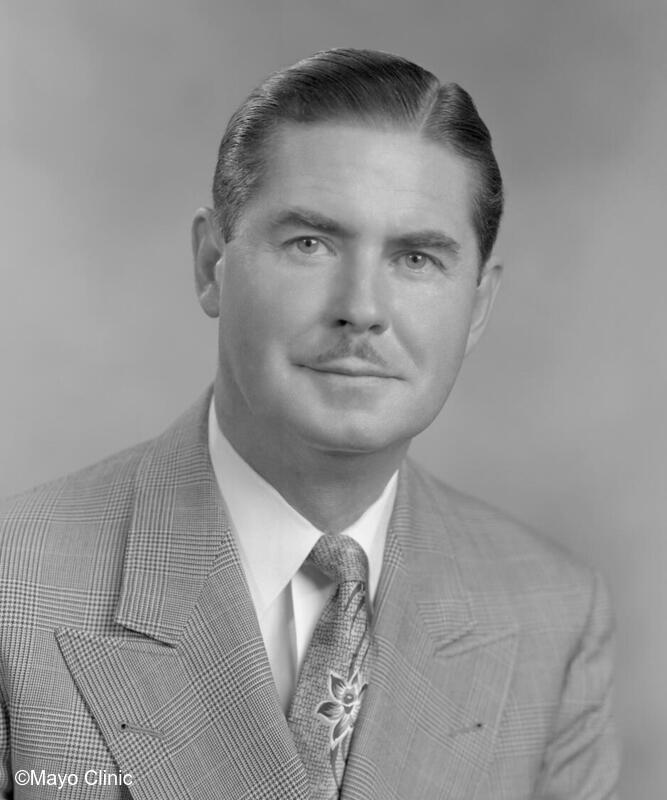
Charles Adams, M.D. was born in Woolner, Ontario, Canada on August 7,1906. He earned his M.D. at Queen’s University in Kingston, Ontario in 1931. After 4 years of general practice in Ontario, he moved to Rochester as a resident in anesthesiology. His classmates were Ralph T. Knight, M.D. (highlighted in Centennial Update #48; August 8, 2024) and John H. Hutton, M.D. He completed his training and earned a Master’s degree in anesthesiology from the University of Minnesota in 1937. His thesis for his degree was “Intravenous Anesthesia: Chemical, Pharmacologic and Clinical Considerations of the Anesthetic Agents Including the Barbiturates.”
Adams’ work with intravenous anesthesia in 1936 and 1937 aligned him closely with Dr. John Lundy. Dr. Lundy had first used sodium pentothal in June 1934, yet little was known about the barbiturate, its metabolism, and its physiologic impact in various disease states and trauma. Together, they gathered data and wrote extensively about their clinical experiences and laboratory evaluations of pentothal. Their advocacy for intravenous anesthesia led to a remarkable shift in the care of surgical patients in the coming decades. When reports from Pearl Harbor suggested that pentothal was a dangerous drug to use in traumatized military personnel who were in shock, it generated an extended controversy. In 1944, Dr. Adams wrote an article in the Journal of the American Medical Association describing the use of pentothal in peace and war. That article was cited worldwide over the following decade and was a major contributor to the advancing popularity and safe use of intravenous anesthesia. As a protégé of Dr. Lundy and, therefore, knowledgeable about Lundy’s advocacy for balanced anesthesia, he also noted in that and other articles the efficacy and safety of using intravenous anesthesia as an adjunct for regional anesthetic techniques and in combination with nitrous oxide or other inhaled anesthetics.
Adams and Lundy worked together for two decades and advocated for improvements in anesthesia care that have advanced the specialty. For example, they suggested that a hemoglobin of less than 10 mg/dl should be considered as a trigger point for transfusion in the perioperative period. In the decades before ubiquitous hemodynamic and oxygenation monitoring during the perioperative period, this trigger proved valuable in improving patient safety and was used around the globe. In 1944, Dr. Adams wrote an exhaustive text (663 pages) of the chemistry, pharmacology, physiologic actions, and his reflections and observations on the use of barbiturates and other intravenous anesthetics. Following Dr. Lundy’s footsteps in organized medicine, he served in both the ASA House of Delegates and as a member of its Board of Directors.
In 1952, Dr. John Lundy was asked to step down as chair of the Section on Anesthesiology and Intravenous Therapy. His 28-year leadership of the department was remarkable and advanced the specialty in so many ways. However, after nearly 3 decades as chair, the institution’s leaders sought someone with a different leadership style . . . perhaps less confrontational. It appears that Dr. Lundy wanted Dr. John Pender as his successor, but the Mayo Board of Governors chose the gentlemanly, affable Dr. Adams instead. Unfortunately, medical issues led him to step down just a year later in 1953. He was succeeded by Dr. Albert Faulconer.
Adams and his wife, Elma Maude, had two children. He and his wife were highly respected citizens of Rochester and strongly supported music and theater in the city. Dr. Adams passed away on January 21, 1956. An excellent summary of his life can be read on page 3 of Volume 7, No. 7 of the 1956 MayoVox edition.

Maurice S. Albin, M.D. was born on March 18, 1923, in Brooklyn, New York. After graduating high school in 1941, he joined the U.S. Army and served in the European theater during World War II. He was an infantry medic at the Battle of the Bulge. Upon returning from the war, he entered New York University and graduated in 1952. He attended medical school at the Universidad Nacional Autonoma de Mexico in Mexico City where he earned his M.D. He moved to Rochester in 1960 as a resident in anesthesiology with classmates such as Drs. Alan Sessler and Martha Smith (Mrs. Alan Sessler). He completed his training in 1962.
Albin moved to Case Western Reserve University. At that institution, he worked extensively with Dr. Robert White, a neurosurgeon widely known for attempting total head transplants in primates (Robert J. White - Wikipedia). Ironically, I heard Dr. White present this astonishing work at a meeting of the Ohio Athletic Trainers Association in Springfield, Ohio in 1975. It was at this meeting that I first learned of Dr. Albin. Although head transplantation was unsuccessful (and Dr. White was branded as “The Butcher” by several animal rights groups), the two were nominated for the Nobel Prize twice (2004 and 2010) for their work in limiting spinal cord deterioration in injury with hypothermia. Dr. Albin moved to the University of Pittsburgh, then to the University of Texas San Antonio, before settling into the University of Alabama in Birmingham.
Albin was a pioneer in neuroprotection and understanding of the biomechanics of spinal cord injury. His work on cerebral blood flow, spinal cord ischemia, and venous air embolism led to several innovations and modifications to anesthesia practice. He played a primary role as a founder of the Society of Neuroscience in Anesthesiology and Critical Care (SNACC) and was the society’s second president and recipient of its Distinguished Service Award. An excellent summary and thoughtful reflections on his impact on neuroprotection and the establishment of the field of neuroanesthesiology was written by Dr. Andy Kofke in 2016 upon Dr. Albin’s death).
As an accomplished story-teller who was an experienced battlefield Army medic in World War II, Dr. Albin loved to study and write about anesthesiology’s initial use in the U.S. Army during the Civil War. He became one of the country’s leading authorities on that topic. His article in the ASA Monitor in 2014 is a remarkably interesting summary of Civil War anesthesiology.
Albin was married to the love of his life, Marguerite, for more than 70 years. They had three children and six grandchildren when he died on July 2, 2016.
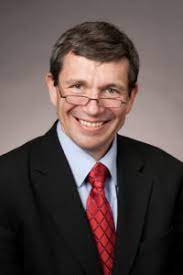
Douglas R. (Doug) Bacon, M.D.was born in Buffalo, NY on January 28, 1959. He graduated from the State University of New York (SUNY) at Buffalo in 1981 and then earned his M.D. at SUNY Stony Brook’s School of Medicine in 1985. Doug interned at Millard Fillmore Hospital in Buffalo, followed by a residency in Anesthesiology at SUNY Buffalo Affiliated Hospitals. He joined the Roswell Park Cancer Institute as an anesthesiologist and completed a Master of Arts in History degree at SUNY Buffalo in 1994. His interest and training in medical history has played a major role in his career.
During his clinical career, Doug practiced in a variety of academic settings and institutions, including the Roswell Park Cancer Institute, the Buffalo Veterans Administration Medical Center (VAMC), our department in Rochester, Wayne State University, and the University of Mississippi Medical Center. At SUNY Buffalo, he had the honor of being the vice-chair for Education. He also served as Chief of Anesthesia Services of the New York Upstate VAMC from 1995 through 2000. In April 2001, I was able to persuade Doug to move to Rochester with the goal of establishing an anesthesia history program in Rochester and supporting scholarship for trainees and early career staff in that field. During his 11 years in our department, Doug published anesthesia history papers with a remarkable 63 of our trainees and colleagues and established Mayo Clinic as an international leader in the field. Doug served as our department vice-chair of Faculty Development from 2008 through 2012. He is our first anesthesiologist to become professor of both Anesthesiology and the History of Medicine.
In 2012, Doug moved to Detroit where he spent two and a half years as chair of anesthesiology at Wayne State University. He subsequently moved to Jackson, Mississippi and spent 8 years as chair of the Department of Anesthesiology at the University of Mississippi. Doug became visually impaired in June 2022. This impairment ended his clinical career, and he left the University of Mississippi. We were fortunate to entice him to join our Rochester department as an administrative consultant at that time, and he has helped lead our current Centennial Project and represent Mayo Clinic in anesthesia history meetings nationally and internationally.
Doug’s research interest has focused on the organizational history of anesthesiology during the first half of the twentieth century and the challenges of creating the definition of and the infrastructure for the specialty. He has been a prolific author in anesthesia history and has become one of the world’s leading authorities in the field. He was honored as the 2012-2016 Laureate of the History of Anesthesiology, an international career award given by the Wood Library Museum of Anesthesiology (Douglas R. Bacon - Wood Library-Museum of Anesthesiology (woodlibrarymuseum.org). Doug served as secretary of the WLM from 2001 through 2008 and has been a council member of the History of Anaesthesia Society, United Kingdom. He also served as president of the Anesthesia History Association from 2006 through 2010.
Doug has been a highly visible spokesperson for anesthesiology during his career, serving as editor of both the New York Society of Anesthesiologists’ Spherenewsletter and the ASA Newsletter. He has been an associate or section editor for journals such as the Bulletin of the History of Medicine, Regional Anesthesia and Pain Medicine, and the Journal of Clinical Anesthesia. He currently serves as secretary of the Academy of Anesthesiology.
Doug now makes his home in East Amherst, New York, a suburb of Doug’s hometown of Buffalo. He and his wife, Dr. Melissa Bacon, have 4 adult sons and a middle-school-aged daughter.
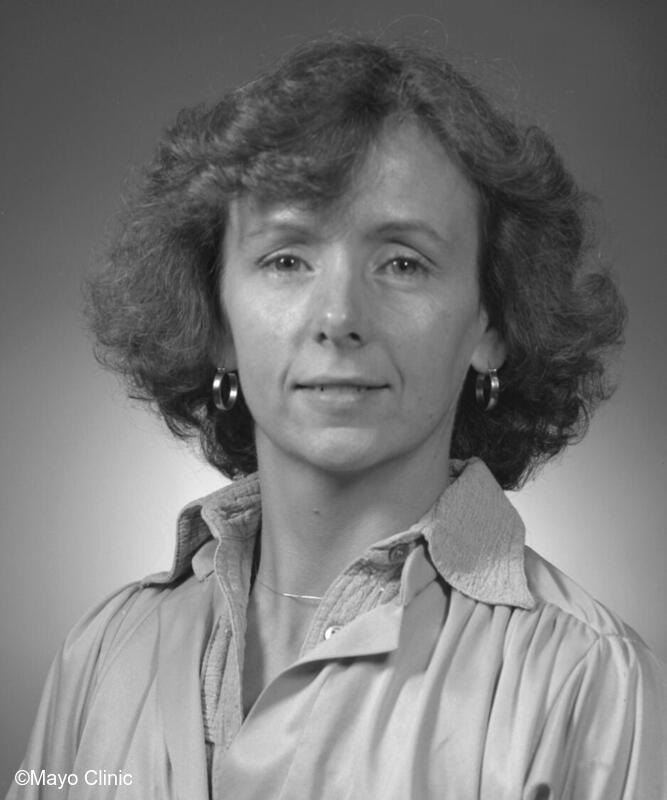
Pauline Bisel, CRNA, was one of twelve children and grew up in the country 30 miles north of Dublin. Following her elementary and secondary education she completed a two-year program on the care of children at St. Clare’s Dietetic Hospital in Co. Meath. On completion of this she worked for several years at St. Mary’s Hospital for children in Baldoyle, Dublin. Most of the patients were children who had post poliomyelitis complications.
In her early twenties she decided to become a Catholic nun, joining a community in New York State involved in the care of the elderly. After two years in this endeavor, she realized she could not spend her life living with all women! She returned home to Ireland and after a short while travelled to England where she attended the Chelmsford School of Nursing in Chelmsford, Essex. While there she met and married her husband Steve who was serving in the United States Air Force.
Upon returning to the United States, she worked for several years in various hospitals in different states gaining experience in multiple specialties including intensive care. During this time, she and Steve were blessed with two daughters.
In 1979 Pauline applied to the Nurse Anesthetist program at Mayo Clinic, in Rochester, MN. As she drove to her interview in Rochester, she recalled first reading about Mayo Clinic in a book she discovered in her uncle’s house when she was 9 or 10 years old. At that time Mayo Clinic and Rochester, Minnesota was a very long distance away. The mere thought she could be there one day was absurd. At this interview she recalls meeting the esteemed Dr. Peter Southorn who impressed her with his warmth and sincerity.
She entered the Nurse Anesthetist program in September 1979 and upon graduating stayed on as staff anesthetist at St. Mary’s Hospital. The first two years were in Cardiac Anesthesia where she was very fortunate to be involved in pediatric cardiac anesthesia under the tutoring and mentoring of Drs Beynan and Raimundo. Pauline’s love for taking care of children was clearly met. In 1987 Dr. John McMichan invited her to join the anesthesia group going to Scottsdale, Arizona. It was a department of three MDs and one CRNA. This move created unique challenges. The local anesthesia providers were not welcoming CRNAs. However, over time and due to the excellent health care Mayo Clinic provided to the community, acceptance was gained. Even though challenging this was also a very exciting time.
After eleven years Pauline stepped down from administrative duties to be a full-time clinical anesthetist. For several years she travelled to Mexico and Haiti with a small Mayo group who were part of International Medical Assistance. This was a very rewarding experience. Pauline retired in 2013 after thirty-two years on staff. In retirement she continues aiding her neighbors to the south by being part of a small group of Mayo Clinic Colleagues offering mobile medical clinics in Ensenada, Mexico.
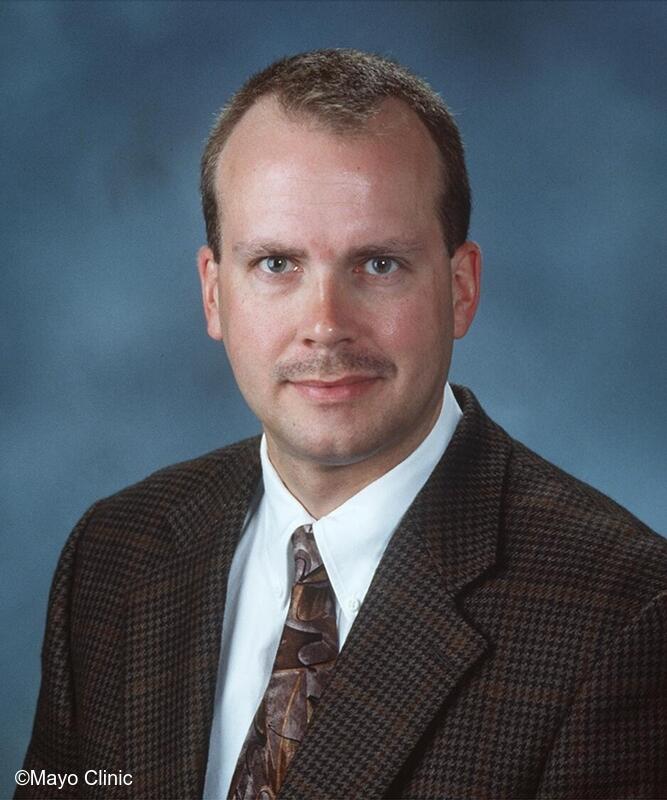
Daniel R. Brown, M.D., Ph.D. was born on May 2, 1964 in St. Paul, Minnesota. He grew up on a sheep farm in Woodbury, Minnesota. After graduating from Hamline University in St. Paul, he obtained his Ph.D. and M.D. degrees from the Medical College of Wisconsin. His Ph.D. in Respiratory Physiology formed the basis from which he learned anesthesia and critical care at Johns Hopkins University.
o In 1998, wanting to get back to the Midwest, Dr. Brown joined the Mayo Clinic in Rochester. A strong proponent of critical care medicine, he played a lead role in expanding our department’s footprint in that crucial subspecialty across the institution. It was not easy. Dan led a dedicated group of 10 anesthesiologist intensivists in the early 2000s when he first became chair of the department’s Division of Intensive Care and Respiratory Care in 2001. These individuals spent the majority of their time and an immense number of hours providing care to critically ill patients in an increasing number of ICU units across the Rochester campus. During that period, Dan successfully recruited like-minded, dedicated anesthesiologist intensivists and grew the number of division members during his time as division chair (2001-2021) from 10 to more than 50 intensivists. The critical care anesthesiology group in Rochester is now the largest institutional critical care group in the country, with our department caring for the great majority of the most acutely ill patients in Rochester. Dan and Dr. Francis (Fran) X. Whalen, Jr. began the rapid response team (RRT) in Rochester, with both personally covering this practice until it became a stand-alone service under critical care. It is impossible to overstate the remarkable leadership skills and abilities that Dan brought to advancing Mayo Clinic’s critical care services during the first two decades of this century.
Dan’s efforts were recognized by the institution when he was selected to chair the Independent Multidisciplinary Group in Critical Care in Rochester. This group coordinates all Rochester ICU care. In that role, he also led the institution’s Critical Care Specialty Council. Dan has gone on to lead the institution’s Midwest Hospital Practice Subcommittee, charged with coordination and oversight of the Mayo hospitals in the upper Midwest of the U.S.
Dan is an outstanding clinician and teacher. He has received multiple Teacher of the Year and Clinician of the Year awards in the department and critical care medicine. An excellent educator, Dan is also a long-serving oral examiner of the American Board of Anesthesiology. The institution and a grateful patient’s family honored him by designating a named professorship on his behalf. The Walter and Lenore Annenberg Professor of Anesthesiology in Honor of Daniel R. Brown, M.D. is held by Dr. Mark A. Warner. It is the first named professorship honoring a Mayo Clinic anesthesiologist.
His outstanding professional and leadership efforts have been recognized nationally. Dan served 11 years as a member of the FDA’s Anesthesia and Respiratory Devices Panel. He was on the Board of the American Society of Critical Care Anesthesiologists, a society that evolved into today’s Society of Critical Care Anesthesiologists (SOCCA). He has been a representative to the AMA’s Relative Value Scale Update Committee (RUC), a group that advises Medicare on how to value a physician’s work. He was president of SOCCA from 2018 through 2020, leading the organization through the early days of the COVID pandemic. In 2023, SOCCA recognized Dan with its Lifetime Achievement Award. In 2016, the Hamline College of Liberal Arts named Dan its Outstanding Alumnus.
Dan and his spouse, Heidi, live on a farm in Chatfield where he can be found gardening, tending bees, and pursuing outdoor activities. They have three children.
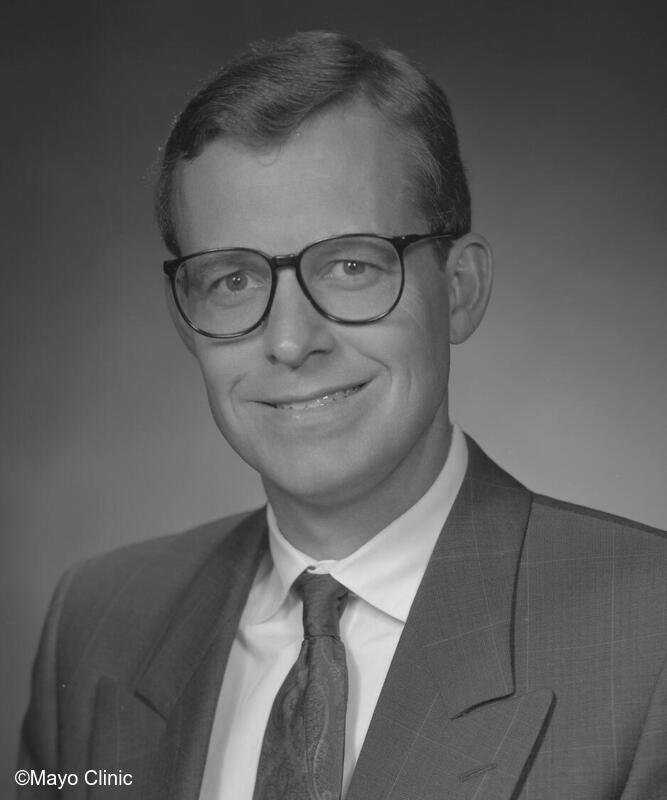
David L. Brown, M.D. was born in Ames, Iowa and raised in Wayne, Nebraska. He received an appointment to the U.S. Military Academy to play football but turned that opportunity down to attend Iowa State University. It was clearly a good decision as Dave met his wife, Kath, while at Iowa State. He subsequently graduated from the University of Minnesota Medical School in 1978. He did his residency at Wilford Hall U.S. Air Force Medical Center in San Antonio and spent 11 years in the Air Force. During part of that period, he served as a flight surgeon with 319thBombardment Wing of the Strategic Air Command in Grand Forks, North Dakota.
After his time in the Air Force, he joined the Virginia Mason Clinic in Seattle, Washington where he became chair in 1987 until he left in 1990 to join the Mayo Clinic. He spent seven years in Rochester and practiced both in the pain clinic and orthopedic group at Methodist Hospital. He left our institution in 1997 to become Professor and Chair of Anesthesia at the University of Iowa. During that time he rebuilt the department with additional staff and renewed energy in education and research. The same pattern occurred when he left the University of Iowa in 2004 to become Edward Rotan Distinguished Professor and Chair of the Department of Anesthesiology and Pain Medicine at the University of Texas, MD Anderson Cancer Center in Houston. Rebuilding academic anesthesia programs was in , and the pattern repeated again in 2008 when he accepted his final Chair position as the Professor of Anesthesiology, Cleveland Clinic Lerner College of Medicine, Cleveland, Ohio. After reflecting on his institutional leadership changes, he came to believe what he enjoyed was the excitement of turning a department around.
During his academic time, Dave completed a number of books, one of which, Atlas of Regional Anesthesia, was awarded the Anesthesia Foundation book award in 1994; it is now in its 7th Edition. His research focused primarily on pancreatic cancer pain control, and he spent five years as Editor in Chief of Regional Anesthesia and Pain Medicine. ASRA also provided him opportunity as its president, and awarded him the Labat Award, and Distinguished Service Award. He also served in leadership roles for the American Board of Anesthesiology, the ACGME, the RRC for Anesthesiology, the Association of University Anesthesiologists, and FAER.
He retired clinically and academically in 2015 from the Cleveland Clinic to form a healthcare startup, Curadux. This provided individuals with advanced illness the benefit of a physician care guide walking alongside their consequential health decisions. The firm closed in 2020.
He and his wife, Kath, split their time between a small ranch in Texas, and the lake in Hayward, Wisconsin. He currently spends time addressing substance misuse on a local Ojibwe reservation and leads a small home church – Solid Rock Church.
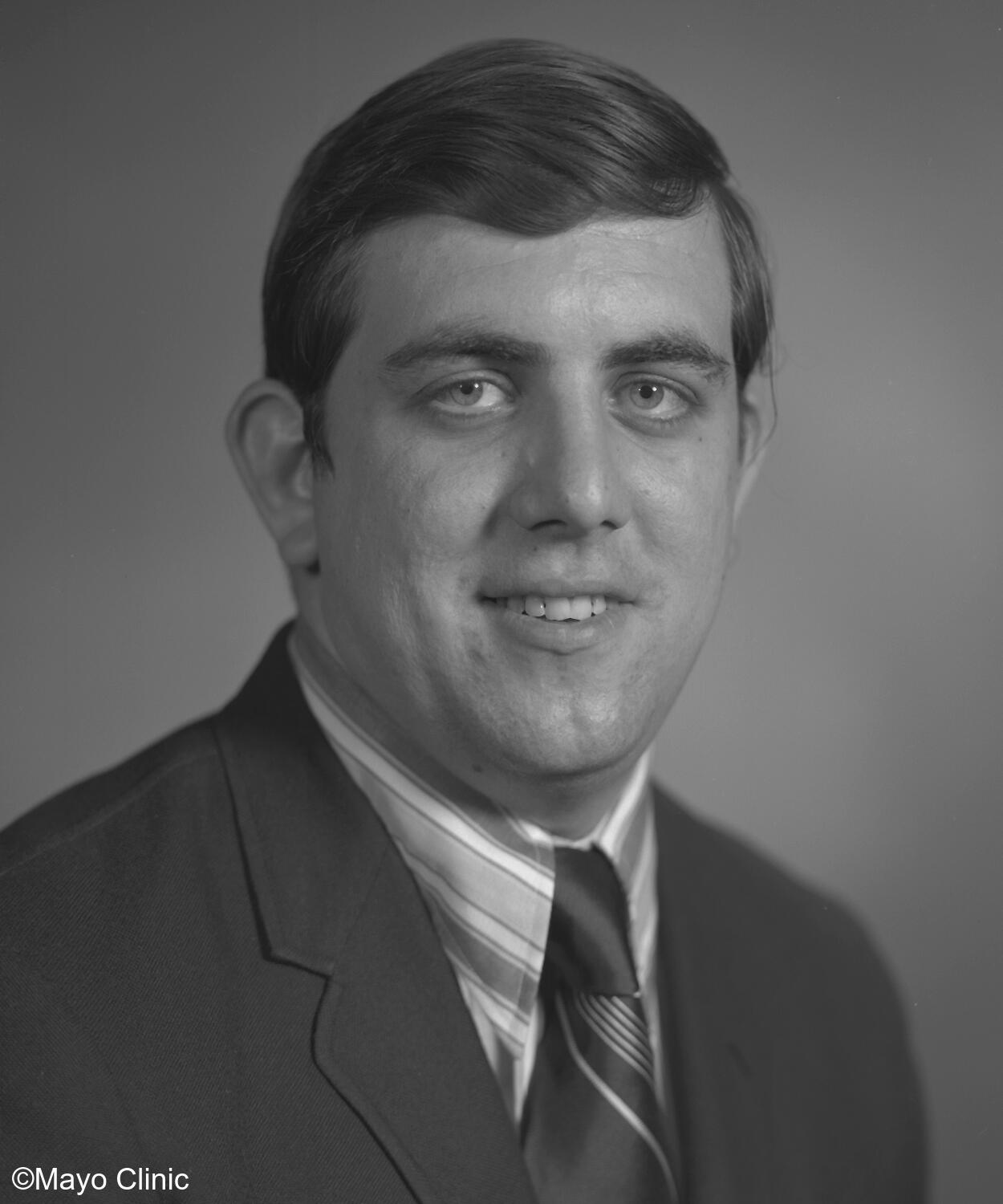
Stephen (Steve) M. Brzica, M.D. was born on Victory in Europe (VE) Day, May 8th, 1945, in Sioux Falls, South Dakota. He was originally named Victor Emmanuel until his father returned from the war and he was renamed Steve, Jr. After graduating high school, Steve attended Creighton University and the Creighton Medical School. A rotating internship at the University of Missouri, Kansas City led him to meet Dr. Jerry Tuohy, a graduate of our Rochester anesthesiology residency program in 1962. Jerry was a classmate of remarkable anesthesiologists and alumni such Drs. Maurice Albin, Martha (Smith) Sessler, and Alan Sessler. Jerry convinced Steve to visit Mayo Clinic, and thus began Steve’s career in anesthesiology.
Steve became a Mayo Clinic resident in 1971, completing his anesthesiology training in 1974. While a resident, he spent much time in the research laboratory of department chair Dr. Richard (Dick) Theye. He enjoyed his time with Dr. Theye but quickly realized research was not in his future. As he neared the end of his training, Dr. Theye called Steve to talk about joining the staff. He presented Steve with a proposal to take a year-long fellowship in Blood Banking (now days, Transfusion Medicine). Steve would then join the staff, half time in the Mayo Blood Bank and half in anesthesia. Dr. Theye crafted his request in such a way that he knew Steve couldn’t turn it down. For example, Steve and his wife, Sheila, had four children; Dr. Theye arranged for Steve to be appointed as an Associate Consultant while a fellow, a financial inducement that worked.
Steve joined our Mayo Hematology fellows working in the Blood Bank for his fellowship. At that time, the Blood Bank was located on the 9th floor of the Plummer Building. There, the fellows and staff would diagnose relatively recently described antigen/antibody interactions that were responsible for blood transfusion mismatches. For emergency requests for blood, the elevators in the Plummer Building at that time were slow. On weekends of call, Steve would run up 9 stories of the Plummer Building to begin crossmatching and testing. That year as a fellow Steve lost 50 pounds! It apparently was worthwhile -- the following year, he passed the board exam given by the American Board of Pathology in Blood Banking.
In the Blood Bank, Steve began working with exceptional transfusion leaders such as Dr. Howard Taswell. They spent their time studying and writing about transfusion practices in surgery. Specifically, they worked on the issue of cell salvage during surgery, trying to find what damage was being done to the cells that were to be re-transfused. They were never able to find the appropriate tests to determine the status of the cells that were to be transfused, but the company marketing the early version of what is now the Cell Saver® was able to convince others to use the product without this information. Steve soon became a very popular speaker on transfusion therapy at many continuing education programs. During this time, he co-authored the chapter on transfusion in Dr. Ron Miller’s first edition of his textbook, Anesthesia(1981).
Once Steve was on staff and while working at Methodist Hospital in 1977, Dr. Theye asked him to go to lunch. He then told Steve that he had self-diagnosed himself with ALS and was heading to see a neurologist that afternoon. Sadly, Steve never saw him again as Dr. Theye died shortly thereafter on November 21stof that year. It was a difficult time for Steve since Dr. Theye and he had an unusually strong bond. For example, in 1975 when Steve was taking his oral board examination in anesthesiology, Dr. Theye, a director of the American Board of Anesthesiology (ABA), arranged for Steve to be examined on a Friday, the last day of a week of examinations. The night before Steve’s examination, Dr. Theye came to his hotel room with two suitcases of dirty clothes. Dr. Theye was going bone fishing in the Florida Keys with Dr. John (Jack) Michenfelder immediately after the examination week concluded. He wanted Steve to take the suitcases back to Rochester and give them to Jane Post, Dr. Theye’s secretary. Steve did, and Jane said, “Dr. Theye wanted you to know that you passed the exam.” Probably a fair trade -- dirty clothes carrier service for early notification about the outcome of Steve’s examination. As a former ABA director, I believe that Dr. Theye’s insider information to Steve would probably not be ethical by today’s standards, but it was probably marginally acceptable in 1978.
Things changed dramatically for Steve after Dr. Theye’s ALS diagnosis and rapid death. With child #5 on the way, Steve and Sheila decided that he should join Mayo anesthesiology alumnus Dr. Bill Cant in a new outpatient surgical practice in St. Paul in 1979. Bill was a pediatrician in Red Wing, Minnesota who transitioned to our anesthesiology residency in 1972 and completed his training with Steve in 1974. Our own Dr. Allan Gould had told Steve and Bill that anesthesia in the Cities was in the “dark ages” when they moved to St. Paul. They quickly found out that they were in great demand, not so much for their new surgical center (the St. Paul Surgery Center), but for their anesthesia skills. They soon found themselves working at Shriner’s Children’s Hospital, and Steve also took a part-time job working with medical students and residents at Hennepin County Medical Center. Once there, he taught them to use new inhalation anesthetics such as enflurane and isoflurane. At the time, no one else was using these new drugs in the Twin Cities.
In 1982, Fairview Southdale Hospital in Edina, Minnesota asked Steve and Bill to start a same-day surgical facility to prevent others like them from starting a competing outpatient surgical facility in the area. They did this and added two additional Mayo anesthesiology alumni, 1974 fellow resident classmates Drs. Bob Venegoni and Jerry Edelman. Steve remained in this Edina practice until his retirement in 2017.
Regarding Steve’s career in blood banking, after leaving Mayo Clinic in 1978, Dr. Taswell asked Dr. Herb Polesky, director of Memorial Blood Bank in Minneapolis, to contact Steve. This started a 20-year relationship for Steve with that organization. Those initial years with the blood bank were exciting since Dr. Polesky was active in developing tests for the AIDS virus and transfusion services across the country were tasked with preventing transmission of the virus through blood transfusions. Steve served on the Board of Directors of Memorial Blood Centers of Minnesota starting in 1981. He oversaw the restructuring and expansion of Memorial Blood Bank during his time on the blood center’s board. He subsequently served as president of that board from 1993 through 1995. He was recognized by Memorial Blood Centers of Minnesota with its 1997 Service Award and its Presidential Award for Outstanding Vision and Leadership.
Steve and Sheila, a former nursing school instructor at Mayo Clinic, have five children and fourteen grandchildren. They reside in Bloomington, Minnesota. They now spend their time visiting the grandkids in Omaha, Nashville, and Washington, DC. Steve enjoys playing golf at Hazeltine National Golf Club and occasionally consulting on anesthesia issues for Minnesota Gastroenterology, a large group gastroenterology practice in Minnesota and Wisconsin.

Curtis Buck, R.R.T., CRNA, began his Mayo Clinic career at St. Marys Hospital in its front lobby as a “bellboy” (honest, that was the job title) in 1971. After high school, he completed a 2-year nursing degree at Rochester Junior College (currently the Rochester Community and Technical College). Curt worked in the existing 3rd Alfred Surgical ICU at St Marys Hospital for two years, then joined our nascent Mayo Respiratory Therapy program’s second class. He worked as a respiratory therapist at St. Marys Hospital until 1979 before matriculating into our Mayo Clinic Nurse Anesthesia program. He completed his anesthesia training in 1981.
Curt spent most of his 11 years in our operating rooms in the old General Section (currently the Multispecialty Division) at St. Marys Hospital. Contemporaries in the General Section at the time included nurse anesthetists John Ahle, Christine Hendricks, Mary Marienau, Don Nelson, John Carter, Dan Schnell, Gloria Davis, Jack Hostak, Jan Miller, Margaret Sinclair, Bev Ondler, Pauline Bisel, Linda Buck, and many others. In 1992, Bernie Gillis, our director of Respiratory Therapy and a great nurse anesthetist, was severely injured in a car accident. Given Curt’s background as an RT, he was asked to temporarily fill in as director of Respiratory Therapy. As with many “temporary” Mayo appointments, this one turned out to be permanent. Curt held the position for 22 years. During those 22 years he worked with colleague intensivists such as Drs. Brad Narr, Mike Murray, Dan Brown, Rolf Hubmayr, Dan Diedrich, and many others.
Our Rochester Respiratory Therapy Division excelled under Curt’s vision and leadership. Curt and Dr. David Warner expanded our department’s small Perioperative Outcomes Group and created our robust Anesthesia Clinical Research Unit (now part of our Perioperative Information Management, Implementation, and Analytics Program, PRIISM). Brad Narr and Curt worked together to integrate our respiratory therapists into our new Preoperative Evaluation Clinic. Under Curt’s leadership, our respiratory therapists advanced the practice of respiratory care by first implementing therapist-driven ventilation protocols and then independent management of ventilation for many patients. Our Respiratory Care Division is now considered one of the most active and progressive in the country, with full credit to Curt and his respiratory therapy colleagues for their remarkably successful and innovative clinical initiatives and growth.

Robert Chantigian, M.D., attended Temple University. Not content to be a typical college student, he was engaged in the university for a decade and graduated with not one but three degrees (B.A. in Mathematics, B.S. in Pharmacy, and M.D.). He came to Mayo in Rochester for his residency training in 1979, joining an incoming group of new residents that included Steve Rettke, Mary Ellen Warner, and Mark Warner. Amazingly, these four individuals have spent a cumulative 165 years in the department. By the time you read this Update, Bob will have retired as his last workday as a consultant is Wednesday, February 14th, a Valentine’s Day that many of us will associate with Bob’s retirement date.
After completing his residency program, Bob trained in obstetric anesthesia at Brigham and Women’s Hospital in Boston and then in pediatric anesthesia at Children’s National Medical Center in Washington, D.C. He joined the staff of Brigham and Women’s Department of Anesthesiology from 1983 through mid-1985 before returning to Rochester. Upon his return he became the department’s Director of Obstetric Anesthesia, serving in that capacity for 10 years and remaining a mainstay in that area for two decades.
Bob is a remarkable teacher and clinician. He has been awarded 10 Teacher of the Year Awards from the residents and student nurse anesthetists and is a member of the Mayo Fellows Association Teaching Hall of Fame. In 2013, the department recognized him with its Commitment to Education Award. He also earned Distinguished Clinician Awards from residents and colleagues.
In 1992 Brian Hall and Tony Jones wrote the first edition of their best-selling board examination preparation book, Anesthesia: A Comprehensive Review. They published a 2nd edition in 1997 before Tony left Mayo to become chair of the Department of Anesthesiology at the University of Alabama at Birmingham. With Tony’s move, Bob joined Brian in producing editions 3 through 6 in 2003, 2010, 2015, and 2019, respectively. Their text is one of the best-selling in the U.S. over three decades and has become an anesthesia library staple (please link to “Hall Chantigian Anesthesia book review 5th edition” here). They currently are working on the book’s 7th revision. They believe it will be available at the end of this year.
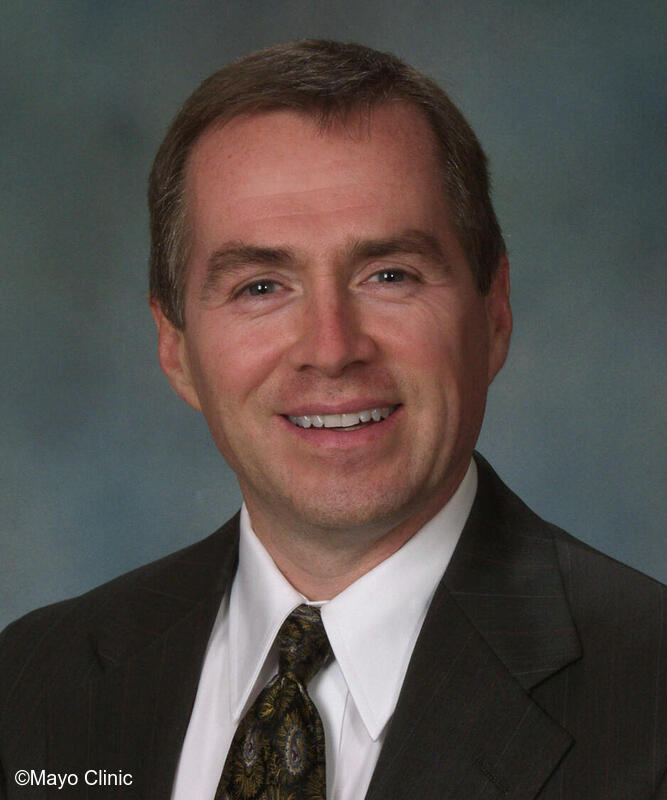
Dan Cole was born in Washington, D.C. and raised in Michigan. After graduating from Andrews University in Berrien Springs, Michigan (20 miles northwest of South Bend, Indiana), he earned his M.D. from Loma Linda University, 60 miles east Los Angeles. He also completed his anesthesiology training there. Dan subsequently was a neuroanesthesiology fellow at the University of California, San Diego. Dan was a faculty member at Loma Linda University from 1986 through 2003. During his time in California, he rose within the California Society of Anesthesiologists’ leadership, serving as president in 2001-2002. He also was president of the Society of Neuroscience in Anesthesiology and Critical Care from 2001-2002. It was obviously a very busy year.
Dan moved to Phoenix in 2003 and became chair of our Mayo Clinic Arizona Department of Anesthesiology. During that period, he worked with Dr. Renee Caswell and started our residency program and led a time of departmental growth which included the addition of a cardiac transplant and assist device program, and expansion of non-operating room anesthesia. He also served as the Vice-Dean of our Mayo Clinic School of Continuous Professional Development. Dan moved to the University of California, Los Angeles in 2013 as vice-chair of its Department of Anesthesiology. A prolific author and investigator, he currently is Professor of Anesthesiology at UCLA.
Dan is one of only 17 anesthesiologists who have served as president of both the American Society of Anesthesiologists and the American Board of Anesthesiology. While with the ABA, Dan was its Executive Director of Professional Affairs for 4 years. He also has been a director of the Foundation for Anesthesia Education and Research. In 2021, Dan became president of the Anesthesia Patient Safety Foundation and holds that position currently. Dan initiated the ASA’s Perioperative Brain Health, one of the specialty’s major initiatives to improve patient safety in the past 4 decades. He was recognized in 2020 by the ASA with its Distinguished Service Award, joining 6 other Mayo Clinic colleagues as a recipient of that award.
Dan and his wife, Cristine, have two sons (Steven and Andrew) and live in San Monica, California.
Addendum: Although Dan has experienced many memorable events over the years, I am pleased to report that one of the better ones occurred during a summer visit to Rochester when I invited him to speak to our local colleagues and residents. Since it was a social event, I took Dan to lunch with a small group and we sat outside at Famous Dave’s restaurant. Yes, I was being frugal with our Mayo budget. Unfortunately, Dan sat in a large dollop of the restaurant’s famous BBQ sauce. His light tan pants were colorful, to say the least. Knowing that he had an upcoming presentation in the later afternoon, we rushed to my home to wash his pants. Dan is fit, in shape, and weighs less than two-thirds of what I do, so the substitute gym shorts I could provide as a temporary substitute were a little on the large size. A nice piece of rope as a belt fortunately saved the day until the dryer had completed its task. To be fair to Dan, I am not sharing any of the funny photos from that afternoon.
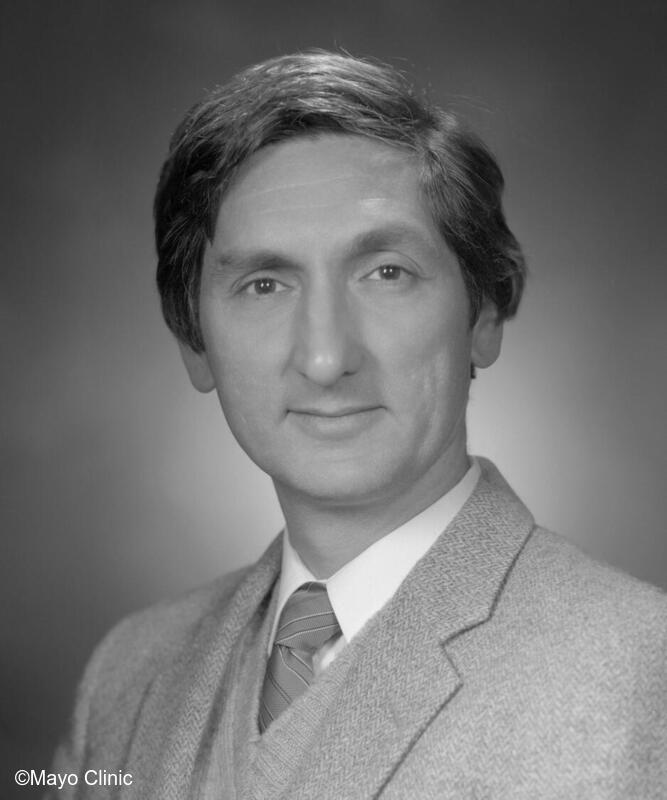
Roy Cucchiara, M.D., after medical school at Louisiana State University, he interned at Charity Hospital in New Orleans. He moved to Rochester and completed his residency and a fellowship in neuroanesthesia in 1973. He subsequently served two years in the U.S. Army at Walter Reed Army Medical Center in Washington, DC before returning to Rochester.
Upon his return to Rochester, he joined one of the country’s most prestigious and influential neurosurgical and neuroanesthesia practices, working (over a period of time) with luminary neuroanesthesia colleagues such as Jack Michenfelder, Joe Messick, Gerry Gronert, Ron Faust, Leslie Milde, and Bill Lanier. His surgical colleagues were also internationally recognized and included Collin MacCarty, Ross Miller, Thor Sundt, Burt Onofrio, Ed Laws, PJ Kelly, Ross Miller, Rick Marsh, and Fred Meyer. Together, they brought huge recognition to Mayo Clinic and were prolific contributors to our understanding of neuroanesthesia and neurosurgery.
Roy was a trainee’s dream educator. He could speak to any topic and always had time to teach anyone. He was an excellent educator, whether one-on-one at the bedside, in the classroom, or in front of 1,000 ASA members during his prolonged run of outstanding refreshers courses on neuroanesthesia at ASA annual meetings. He was an exceptional oral examiner for the ABA. One of his favorite philosophies was that you could be “good and slow or good and fast” . . . and no one was faster or better than Roy with assessing, inducing, and caring for neurosurgical patients with complex morbidities. His extraordinary clinical skills carried through his career. In 2005 Mayo Clinic honored him with one of only five Distinguished Clinician Awards throughout the institution that year.
He was chair of our Rochester Department of Anesthesiology from 1988 through 1991, then subsequently served as chair of the anesthesia department at the University of Florida (1993-1997) and interim chair of our Mayo Clinic Florida department (2003-2004) during his stellar career.
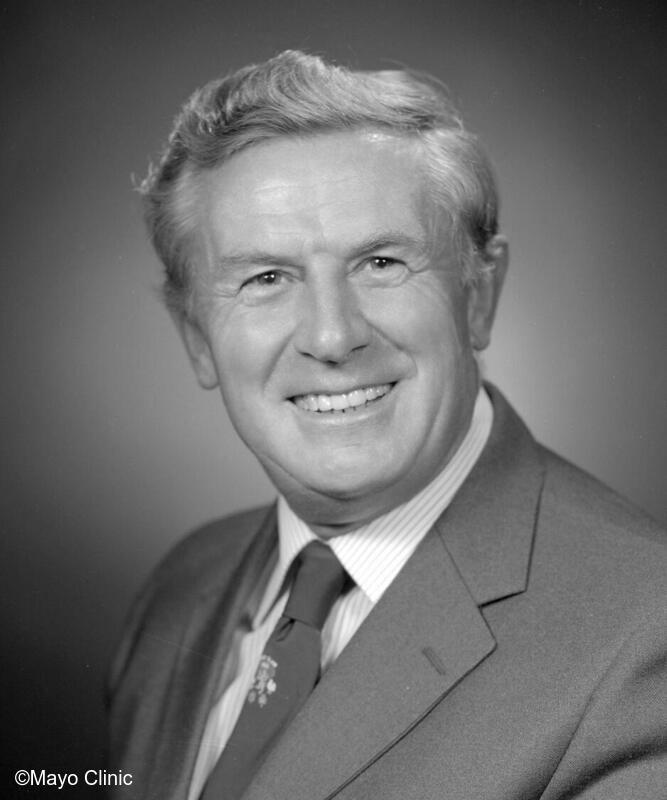
Brian Dawson, M.D. was born in 1927 in Staplecross, Sussex, England. He received both his Bachelor (1951) and Medical (1954) degrees from the University College in London. After residency training in anesthesiology at the University College Hospital in London, Brian moved to Rochester and completed our training program in 1959. After 15 years on staff in Rochester, he moved to Phoenix, Arizona and spent 6 years in private practice at the Phoenix Surgi Center, the country’s first dedicated free-standing ambulatory surgical center (please link to Ambulatory Surgical Centers History here). Brian returned to Rochester in 1981 and became an extraordinarily effective teacher of pediatric anesthesia. He chaired the Section on General Anesthesia at St. Mary's Hospital from 1981 through 1985. In that role, he became one of the institution’s leading advocates for expanding outpatient surgical practices. He was beloved by his colleagues and the entire department.
In responses I’ve had to the Mystery Photo contest, I’ve gotten comments ranging from how he would bring fresh trout into staff after a successful day of fishing the streams of SE Minnesota and NE Iowa to how he would use his gold-plated laryngoscope (which is still in my office) for intubating the most difficult airways. Dr. David Hatch, world-renowned pediatric anesthesiologist at Great Ormond Street Children’s Hospital in London, tells the following story, “Brian and Sonia (his wife) were very close, another couple who made me so welcome in Rochester. In early 1969 Brian took me from snow-bound Rochester to my first major pediatric anesthesia conference in Los Angeles, where I met Drs. Digby Leigh and Jackson Rees, the latter over from the UK. On the way, we stopped off in Las Vegas. I remember Brian telling me that it is better to be snowed out of Rochester than snowed in!!”
Brian passed away after a motor vehicle accident on October 31, 1981. Dr. Paul Stensrud was an intern working in the emergency room at St. Mary's Hospital that afternoon and I was the anesthesiologist who responded to the emergency room when Brian was brought in. It is a day that neither of us will ever forget and incredibly heart-breaking. A mass was held in the St. Mary's chapel to recognize Brian’s humanity and graciousness, especially in caring for children. The nurses of the St. Mary's Hospital pre and postoperative units named the preoperative pediatric area in his honor and dedicated a plaque in his name. Brian is survived by his wife, Sonja. She currently resides in the Charter House just to the north of Rochester Methodist Hospital. Sonja designed the institution’s 3-shield emblem as described in Centennial Update #8 (October 26, 2023).
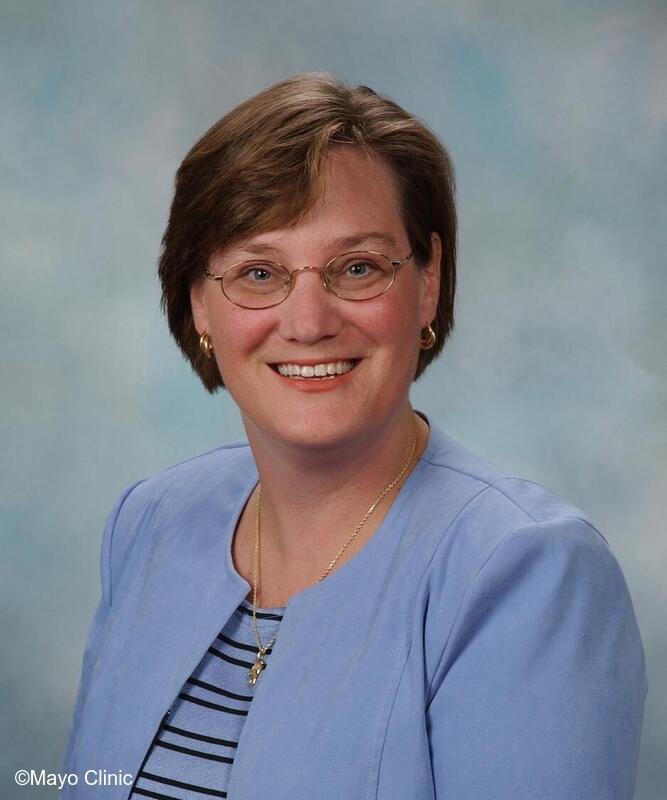
Marie L. De Ruyter, M.D. was born in Riverside, California on January 5, 1962. She received her undergraduate degree from Santa Clara University in 1984, a Master’s degree in Biological Sciences from California Polytechnic State University, Pomona in 1986, and her M.D. from Creighton University, Omaha, Nebraska in 1990. Marie completed her internship and anesthesiology residency in Rochester in 1994. She graciously joined our staff at Mayo Clinic Florida that same year. Coincidently, her older brother, Marty, completed his anesthesiology training and a critical care fellowship here in Rochester, also in 1994, and joined our Rochester department.
Marie is an outstanding educator and her career interest has always been focused on resident education. She was voted “Teacher of the year” in 1996, 1997, and 2013. She was the Jacksonville program director of our institutionally integrated anesthesiology residency program from 1997 through 2001. In 2000 and early during the chairmanship of Dr. Mike Murray, Marie embarked on applying for an independent residency program at Mayo Clinic Florida. The ACGME awarded provisional accreditation for the residency program in 2002, and the first residents started in July 2003. Marie was the program director until 2013. Marie served as chair of the residency program’s Clinical Competency Committee from 2016 through 2021. Among her many career interests, she pursued adding simulation education into our Florida training programs. She developed and coordinated the residency simulation curriculum from 2010 – 2023. Outside of Mayo Clinic, Marie has been a long-time member of the Faculty Development and the Research Committees of the Society for Education in Anesthesia.
Her clinical practice interests are in neuroanesthesia where she has worked to improve the practice on various quality improvement projects. From 2006 through 2008, Marie chaired the department’s Division of General Anesthesia.
Marie and her husband, Dr. Mark Parkulo, an internist at Mayo Clinic Florida, have 3 children. They live in Ponte Vedra Beach, FL and enjoy Jacksonville Jaguar football (sometimes – ha!) and travelling.

Beth Elliott was born and raised in Kentucky. After medical school at the University of Louisville in 1981, Beth moved to Rochester to begin her training in Anesthesiology. Her fellowship year in Rochester focused on Regional Anesthesia/Pain and Neuroanesthesia. She joined the staff in 1985, originally working at Rochester Methodist Hospital with the Vascular and Gynecologic surgeons. Beth eventually moved to St. Marys Hospital to join the Ortho Anesthesia group where she was integral to the development of the Acute Pain Service and the use of epidural analgesia for thoracic surgery patients. She also helped cover chronic pain consults at St. Marys Hospital, creating a busy block practice in addition to her work in the operating rooms. In 1995, Beth was named Division Chair of the Ortho Anesthesia group where she promptly led an effort to rename it the Central Division. She continued in this leadership role until 2005. She was awarded the Clinician of the Year award by her peers in 2007.
As a visiting medical student in 1980, Beth had the serendipitous opportunity to care for Dr. Virginia Hartridge as one of her first patients. Hartridge was the longtime medical director for the Nurse Anesthesia program at Mayo. This led to her initial interest in the nurse anesthesia program, triggering an educational pursuit that became a major part of her stellar career. Beth succeeded Dr. Bob Lennon as medical director for the nurse anesthesia program in 1991 and has held it to this day. Along with her CRNA colleagues, program directors Ed Thompson, CRNA and Mary Marienau, CRNA, she helped guide the program over the ensuing decades in the transitions from a Certificate program to a master’s degree program to the Doctor of Nurse Anesthesia program that it is today. In recognition of her long-term commitment and contributions to the education, Beth was awarded the Distinguished Educator Award from Mayo Clinic in 2009. This award is Mayo Clinic’s highest recognition in education.
Anyone who sees Beth away from the OR (meaning not wearing scrubs) knows that she loves scarves and can be seen wearing one almost every day. Her collection of Hermes scarves goes back many years, adding to her travel adventures and making friends across the USA and Europe.
In addition to her scarves, Beth enjoys quilting and needlepoint. She and her husband of 33 years, Steve Rose, are avid skiers and still spend several weeks a year chasing the perfect powder day at Vail. Beth holds a unique distinction of having not just one . . . but three (!) holes-in-one on various golf courses around Minnesota. She is as skilled on the golf course as she is in clinical practice and education.
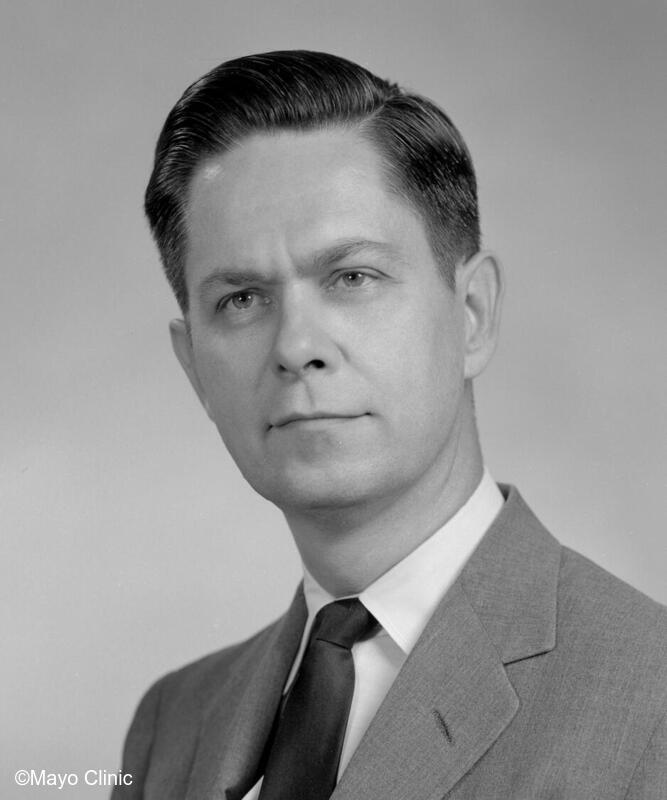
Albert Faulconer Jr., M.D., was born in Arkansas City, Kansas, south of Wichita near the Oklahoma border. He graduated from the University of Kansas Medical School in 1936. After a general internship and medicine residency, plus several years in clinical practice, he came to Rochester in 1943 as part of the 90-day “short course” anesthesia training for physicians who would subsequently play a major role in caring for injured soldiers/seaman/marines during WWII. After the war, he returned to Rochester, joining the anesthesia staff after only 6 months of clinical anesthesia training during his abbreviated residency. He was an exceptional research talent, developing an acoustic gas analyzer as part of his master’s degree thesis. The department almost lost him to Boston’s Harvard programs but a reportedly impassioned plea by Dr. John Lundy to the Mayo Board of Governors resulted in him being hired as a consultant before completing his training.
Albert became a major force in anesthesiology research during his career. An excellent summary of his career and legacy has been published by our own Drs. Peter Southorn, Mary Ellen Warner, Alan Sessler, and Kai Rehder. He used EEG techniques to determine the impact of both inhaled and intravenous anesthetics on the cerebral cortex. He demonstrated that nitrous oxide worked as an anesthetic . . . an assumption that was not universally accepted in the late 1940s and early 1950s. At that time, there was a prevailing wisdom that nitrous oxide worked through diffusion anoxia of the brain. He used a pressure chamber to give percentages of nitrous oxide greater than 80% but ensuring sufficient oxygen to volunteers who were in 2 atmospheres of pressure. He used EEG monitoring of the brain to detect changes depicting levels of anesthesia but not cerebral hypoxia.
His experience with EEG techniques led him to the concept of intraoperative cerebral monitoring to estimate depth of anesthesia. From that and work he did to show that anesthetics, especially intravenous anesthetics, lost their cerebral effects by distribution to other tissues in the body, he developed a computer-activated model to predict uptake and distribution of anesthetics. This then led him to use the model to test a servo-controlled anesthetic machine and a similar intravenous anesthetic infusion device. He soon found that a “closed-loop” computer approach to delivering anesthesia was not going to be successful without the input of trained anesthesia personnel. However, his work formed the basis of today’s processed cerebral monitors to estimate depth of anesthesia.
Albert’s outstanding and novel research earned him a position for 11 years (1950-1961) on the National Research Council’s Committee on Anesthesia. The Research Council was and continues to be the operational arm of the National Academy of Sciences. He was a founder of the Association of University Anesthesiologists and its president in 1956. He also was a director and president of the American Board of Anesthesiology during the 1955-1969 period. In 1953, he was appointed as chair of our Section of Anesthesiology and Intravenous Therapy. He led the section through several name changes, including 1970 when it was renamed as the Department of Anesthesiology. He stepped down as department chair in early 1971. He was a member of the Mayo Clinic Board of Governors from 1963 through 1969. Albert died on December 10, 1985.
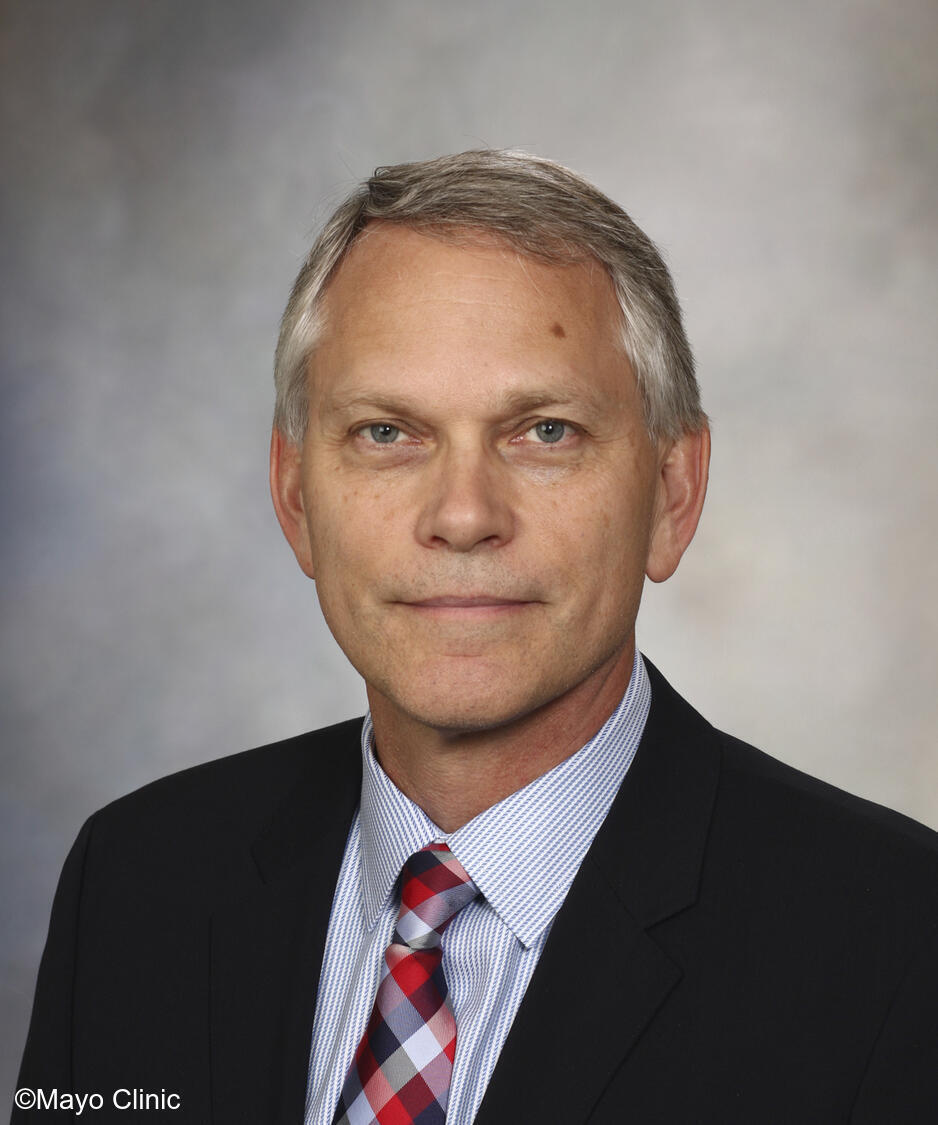
Randall (Randy) P. Flick, M.D. was born in Fargo, North Dakota on June 24, 1957. He received an R.N. diploma from St. Luke’s Hospital School of Nursing in 1980 and a B.A. degree from Moorhead State University in 1983. He earned an M.D. degree from the University of North Dakota School of Medicine in 1987. Randy completed an internship and residency in pediatrics at St. Louis Children’s Hospital, Washington University in 1990; a residency in anesthesiology at Barnes Hospital-Washington U. in 1992; and a fellowship in advanced specialty training in pediatric anesthesiology and intensive care at The Johns Hopkins Hospital in 1995. He joined the staff of Mayo Clinic that same year. He holds board certification in four specialties: Pediatrics and Pediatric Critical Care, as well as Anesthesiology and Pediatric Anesthesiology.
Randy made an immediate impact on the quality of our care of children upon his arrival to Rochester. He was an outstanding clinician and educator in our operating rooms and our pediatric intensive care units. He received multiple Excellence in Teaching Awards from the Mayo Medical School in his first decade on staff. He was appointed chair of the Division of Pediatric Anesthesia in 2006 and continued in that role through 2013. In his years at Mayo Clinic, Randy has played a major role in recruiting and developing high quality and well-trained pediatric anesthesiologists (see above story). In 2009, he was asked to serve as the medical director of the Mayo Clinic’s Eugenio Litta Children’s Hospital. In 2014, he advanced to medical director of the entire Mayo Clinic’s Children’s Center. In that role, he oversaw all pediatric activity across the institution. He completed his time as our Mayo pediatric services leader in 2023.
o Randy is a past president of the Society for Pediatric Anesthesia (SPA; 2016-2018). He previously chaired the ASA Committee on Pediatric Anesthesiology. He has served as chair of the U.S. FDA’s Advisory Committee on Anesthetics and Analgesic Drug Products and has been a member of the Pediatric Advisory Committee reporting directly to the FDA commissioner. Dr. Flick currently serves as a member of the National Institute on Child Health and Human Development’s (NICHD’s) Pediatrics Study section.
Randy’s research interests have included outcomes in pediatric anesthesia, neurodevelopment effect of anesthetic exposure, and quality in pediatric hospital care. Working with colleagues such as Drs. David Warner, Bob Wilder, Juraj Sprung, Toby Weingarten, Yu Shi, Steve Gleich, Mike Nemergut, Lindsay Hunter Guevara, and Devon Aganga, he has played a major role in elucidating and understanding the impact of repeated general anesthetics on the brains of infants and children. He currently is a co-PI on a federally funded study of the effects of anesthetic exposure on the developing brain and co-investigator on another NIH grant, “Neuroimaging Studies in Pediatric Anesthesia Neurotoxicity.”
Dr. Flick and his wife, Loree, have three sons. In the community, he has served as president of the local Ronald McDonald House Board, is a global medical advisor to Americares International, a current trustee of the Minnesota Zoo, and a board member of the SPA’s Women’s Empowerment and Leadership Initiative. Loree is also very involved in the children’s services in the community (e.g., SPARK, Rochester’s Children’s Museum).

Neil Fienglass, M.D., earned his medical degree from Vanderbilt University. He trained in anesthesiology as well as critical care medicine at the University of Florida. After a one-year cardiothoracic anesthesia fellowship at Texas heart Institute with Arthur Keats, he moved to Rochester in 1987. In 1988, he transferred to Jacksonville, initiated intraoperative echocardiography services and chaired the Section on Cardiac Anesthesia at Mayo Clinic Florida. In 1998, he became one of the nation's first board-certified echocardiographers in anesthesiology.
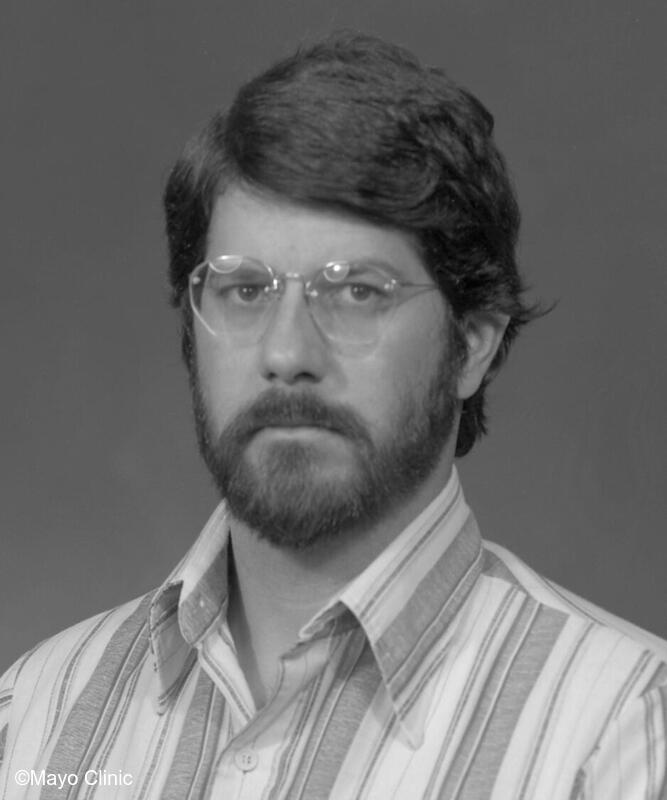
Mike Geisler, CRNA, completed his nurse anesthesia education at the Mayo School of Health Related Science in 1984. Before that, he worked at Rochester Methodist Hospital as an RN in the old "11-1 Unit" (Respiratory ICU) and then as the Head Nurse of the Plastic Surgery Unit. Mike's father served our country as a member of the Defense Intelligence Agency of the US Army, which influenced Mike's childhood by living in numerous places around the world. He and his family lived in Tehran, Iran, for three years, in Bangkok, Thailand, for four years, and in Frankfurt and Stuttgart, Germany, for eight years. He spent most of his childhood in other countries, exposed to various cultures and languages. Mike was fluent in Thai as a toddler.
Mike and his family returned to the US in time for him to complete his senior year of high school in Southern Pines, North Carolina. Two years after graduating from high school, in 1972, Mike received his military draft notice. He enlisted in the US Navy and served as a Corpsman with the US Marine Corps. As a corpsman, he became aware of the profession of nurse anesthesia by watching Navy CRNAs at work in the operating room. This exposure led him down his professional career path, which he enjoyed for 38 years.
In 1997, Mike was asked by Dr. Jeffry Steers, a Liver Transplant surgeon in Rochester, to assist him in organizing and educating a new Liver Transplant team for Mayo Jacksonville. Mike was an integral part of the Rochester anesthesia team and participated, along with Dr. Steve Rettke, in the first liver transplant in Rochester. When Dr. Steers approached Mike about relocating to Jacksonville, the Mayo Department of Anesthesiology in Jacksonville was comprised of approximately 10 CRNA's and 8 anesthesiologists. A short time after the formulation of the Liver Transplant Team, he was asked by Dr. Tim Lamer, Chair of the Department of Anesthesiology, to assume the position of Chief CRNA. As a result of the Mayo Jacksonville Liver Transplant program and subsequent heart and lung transplantation, the nurse anesthesia component of the Anesthesia Care Team grew to approximately 34 CRNAs. Mayo Jacksonville’s Liver Transplant Program evolved into the nation's most extensive and successful liver transplant program.
Mike has been recognized for his clinical expertise and contributions beyond the boundaries of Mayo Clinic. In 1999, he was awarded the American Association of Nurse Anesthetists’ Clinical Practitioner of the Year Award. Mike remained in the Chief CRNA position in Jacksonville until 2002. He subsequently followed his desire to return to clinical practice, retired from the Chief position, and returned as a staff member in the department. He retired from Mayo in 2007 but not from the practice of nurse anesthesia. In 2007, Mike and his wife Deb formed an anesthesia staffing group that provided anesthesia services to local surgery centers, oral surgery groups, and hospitals. In recognition of Guedel's teachings, the group was named "Stage II Anesthesia."
Mike continued providing anesthesia services until his retirement in 2022. He currently lives in Jacksonville, FL, on the Intracoastal Waterway within view of the Mayo Clinic campus. He enjoys fishing, sailing, playing guitar, and spending time with family, including three lovely grandchildren.
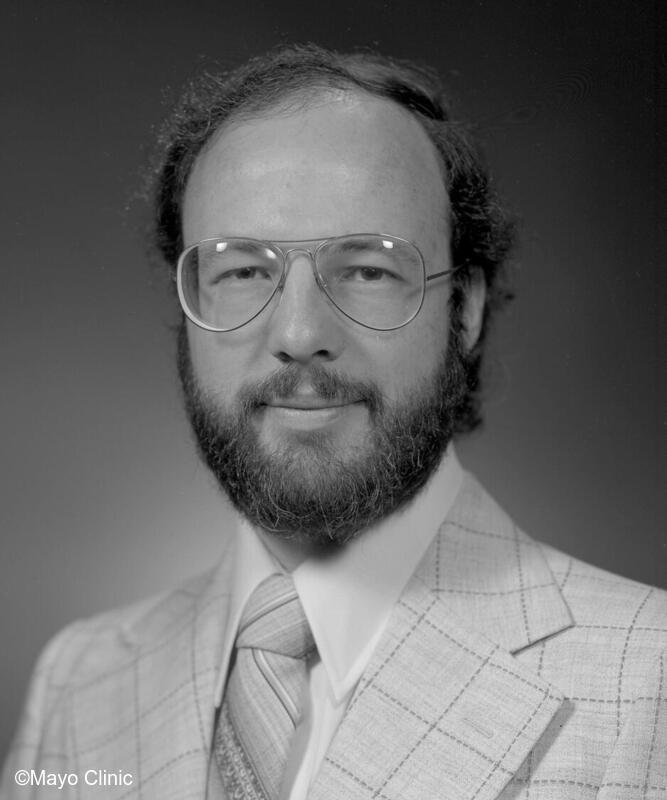
Adrian Gelb, M.B. Ch.B. earned his medical degree from the University of Cape Town, South Africa in 1972. After an internship at Groote Schuur Hospital in Cape Town, he was a surgical resident at Addington Hospital in Durban, South Africa for a year. He then moved to Bath, England and was a resident in anesthesiology for a single year before moving again, this time to the University of Western Ontario (now Western University) in London, Ontario. After completing his anesthesia residency training, he moved to Toronto for a year of Critical Care Medicine training. In 1979, Adrian moved to Rochester where he worked closely with Kai Rehder, Peter Southorn, and Paul Didier as a Mayo Clinic research fellow. His work during his one year at Mayo resulted in two publications, one in Lung(DOI:10.1007/BF02713915) and the other in the British J of Anaesthesia. Adrian’s year in our department was the first year of training for Drs. Bob Chantigian, Steve Rettke, Mary Ellen Warner, and me.
Adrian returned to London, Ontario in 1980, progressing and becoming chair of the University of Western Ontario’s department from 1991 through 2004. His academic career skyrocketed while at Western as he earned professor rank in Anesthesiology, Clinical Neurological Science, Pharmacology & Toxicology, Kinesiology, and Clinical Pharmacology. In 2004, he moved to the U.S. west coast and joined the Department of Anesthesiology at the University of California, San Fransisco. He remains there today as Professor of Anesthesiology.
A remarkable visionary, Adrian has served as president of the Society of Neurosurgical Anesthesiology and Critical Care (SNACC; 1995), the International Society for Anesthetic Pharmacology (ISAP; 2003); and the World Federation of Societies of Anaesthesiologists (WFSA; 2020). He also has been chair of the Board of Trustees of the International Anesthesia Research Society (IARS; 2003). In the science of anesthesiology, he has served on the editorial boards of the Journal of Neurosurgical Anesthesiology, the Chinese Journal of Anesthesiology, the Canadian Journal of Anesthesia, Anesthesia & Analgesia, Current Opinions in Anesthesiology, the Korean Journal of Anesthesiology, the Romanian Journal of Anesthesiology, the Brazilian Journal of Anesthesia, and the Journal of Neuroanesthesiology and Critical Care of India. Truth is, Adrian rarely sleeps and with his extensive travels, I suspect his world clock is wound pretty tightly.
With all of his international activities, Adrian has taken a worldwide lead on global health and, specifically, anesthesia patient safety. He has chaired the Patient Safety and Quality Committee of the WFSA and was the leader of the development of “the World Health Organization-WFSA International Standards for a Safe Practice of Anesthesia.” In recognition of his passion and enduring contributions to improving anesthesia care worldwide, the ASA will bestow its Nicholas M. Greene, M.D. Award for Outstanding Humanitarian Contribution on Adrian at its October 2024 Annual Meeting in Philadelphia.

Allan Gould, M.D., was born in Buffalo, NY and grew up in Piqua, Ohio. After college at Ohio State University, he attended Jefferson Medical College in Philadelphia, graduating in 1952. Within a week of graduating, he married Marilyn Buxton, his wife of 52 years. He served in the U.S. Army after an internship in Philadelphia and the first year of his anesthesiology residency training at Mayo Clinic in Rochester. He joined the Korean conflict as a physician in a Mobile Army Surgical Hospital (MASH) unit. He often chuckled at the humor and simultaneously shook his head in disbelief at the way movies and television shows depicted MASH units. He described his time in Korea in a department newsletter article written in 2003.
After the conflict, Allan returned to Rochester to complete his anesthesia training and joined the staff in 1958. He had a distinguished career as a remarkable clinician. In his retirement year of 1991, Allan was recognized by his colleagues with the department’s Distinguished Clinician Award. For 8 years from 1972 through 1980, he chaired the Section of Anesthesia at the Rochester Methodist Hospital. Extramurally, Allan served as an ABA oral examiner, an editor of the ASA Newsletter, chair of the ASA Annual Meeting (twice!), and a member of the ASA’s Board of Governors. He also was president of the Minnesota Society of Anesthesiologists. Allan was widely admired by his colleagues. He and Marilyn enjoyed their five children, 8 grandkids, and 5 great grandkids during their retirement. They found great joy in working with the walnut trees they planted on their Fillmore County farm in southeast Minnesota and watching birds. Allan passed away on October 14, 2014.

Bernard Gillies, CRNA, RRT, was born in 1930 in North Dakota and served in the US. Army infantry during the Korean War. He subsequently became an outstanding nurse anesthetist in our department. He was very involved in much of the early pulmonary physiology research in our department and served as the nurse anesthetist partner to Alan Sessler as they developed the St. Marys intensive care units during the 1960s and 70s. Bernie and Alan built our respiratory therapy program and Bernie served as our clinical director for respiratory therapy for more than 20 years.

Roy A. Greengrass, M.D. was born on January 19, 1948, in Winnipeg, Manitoba. He graduated from the Department of Medicine, University of Manitoba in 1973 receiving BSc Med and M.D. degrees. His early career involved caring for patients in a busy family practice in rural Manitoba where, besides primary care, he performed obstetrical, surgical and critical care procedures. He returned to the University of Manitoba to complete an anesthesiology residency and received the Fellow of the Royal College of Medicine and American Board of Anesthesiology certification. During his residency Roy had the privilege of being mentored by internationally recognized leaders in anesthesiology, including Dr. Shinman Liu and Dr. Y.K. Poon (a fellow of Sir Robert McIntosh) who molded Roy’s future career by demonstrating regional anesthetic techniques that allowed major procedures to be safely performed in awake patients.
After completing his anesthesiology training, Roy joined the Department of Anesthesiology Health Sciences Center Winnipeg as a consultant. Roy was an avid reader and interested teacher who helped develop a regional anesthesia curriculum, including cadaver workshops. He helped incorporate regional anesthetic lectures into Grand Rounds and invited internationally recognized leaders in regional anesthesia as lecturers.
In 1992, he was recruited to Duke University by Dr. Jerry Reves to join an internationally recognized regional anesthesia division led by Dr. Susan Steele. Roy helped create a weekly problem-based learning lecture which was very popular with the residents. The Duke team helped create the country’s first resident regional anesthesia rotation that did not involve an operating room commitment. With Dr. Steele, Roy helped create a Regional Anesthesia Fellowship at Duke which remains very popular today. Dr. Steele and Roy were among the first in the world to send patients home with indwelling regional catheters, several of which were designed by them.
We are fortunate that Roy was recruited to Mayo Clinic Florida in 2001 by Dr. Tim Lamer to assist with the regional anesthesia practice. He has helped introduce additional regional techniques such as paravertebral blocks which have helped facilitate ambulatory discharge after major breast procedures. Roy also assisted in the increased number and complexity of continuous regional techniques in our Florida practice and contributed to the literature on their advantages. He was part of the creation of a Regional Anesthesia Fellowship at MCF and was its inaugural director. With assistance from the Department of Nursing in Jacksonville, Roy helped create a hospital ward-based low-dose ketamine service to assist patients on chronic opioids having major procedures.
Roy mentored numerous residents and fellows, many who currently hold academic positions nationally and internationally. He continues to be actively involved in clinical and academic practice. His research interests involve methodologies to attenuate chemotherapy-induced peripheral neuropathy and the use of local anesthetics as potential chemotherapy adjuvants. He notes that he is privileged to work with gifted regional anesthesiologists and CRNA’s in our Florida practice. He has received Educator of the Year Awards at Winnipeg, Duke, and Jacksonville. In 2001, the American Society of Regional Anesthesia recognized his contributions to regional anesthesia and pain medicine with its Nils Löfgren Award.
Roy has five children. During his leisure time he enjoys running, kickboxing, The Bard, Beethoven and Newton.

Karen Hammell was born in Rochester and attended school in Chatfield. After completing studies as an administrative secretary, Karen joined Mayo Clinic, working with the Mayo Clinic School of Graduate Medical Education (MCSGME) for 5 years. She subsequently worked within our institution’s Legal Department before joining our department in 1991 as the Education Program Coordinator for our residency. Her program director partners during her 31 years of stellar time as the residency coordinator have been Drs. Leslie Milde, Steve Rose, Tim Long, and Bridget Pulos.
Karen has been a primary contact for our trainees during her three decades with the residency program in Rochester. She’s been remarkably successful and respected. She was recognized in 2017 with the MCSGME Education Program Coordinator Award in Surgery and Surgical Specialties, the institution’s highest recognition for that position. In 2023, she was recognized by the Mayo Fellows Association with its Fellow Award. The award is given to exceptional individuals who are extraordinarily committed to our residency and fellowship programs and their success.
Karen will retire in June of 20254 after more than 3 decades of service to our residency program in Rochester. She has 7 grandkids in the St. Charles and Plainview areas who will benefit from her new-found time.
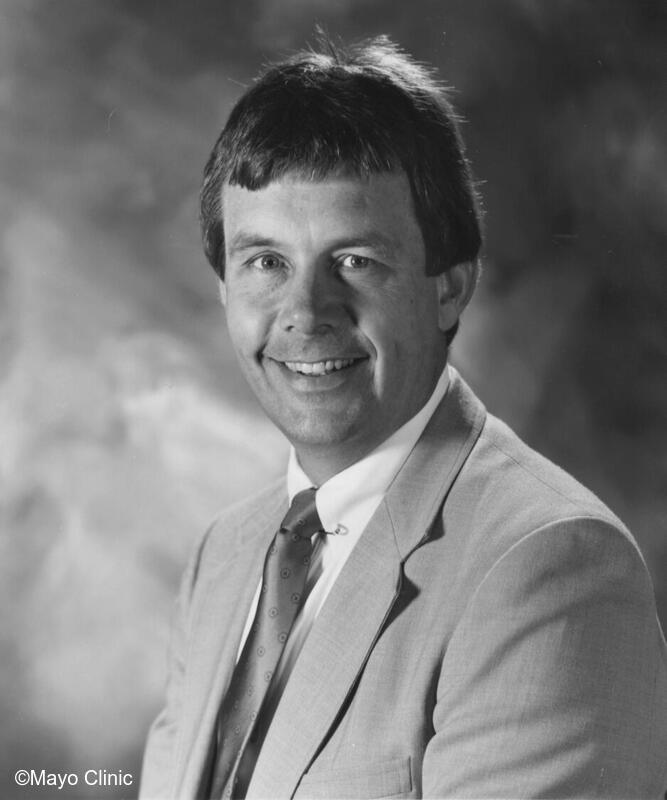
James Harper, M.D., served in the U.S. Army Special Forces (1967-1970) and then attended medical school at the University of Arizona. He joined our Rochester staff in 1982 and moved to Jacksonville to start our Florida department. He was chair of the department for 8 years.
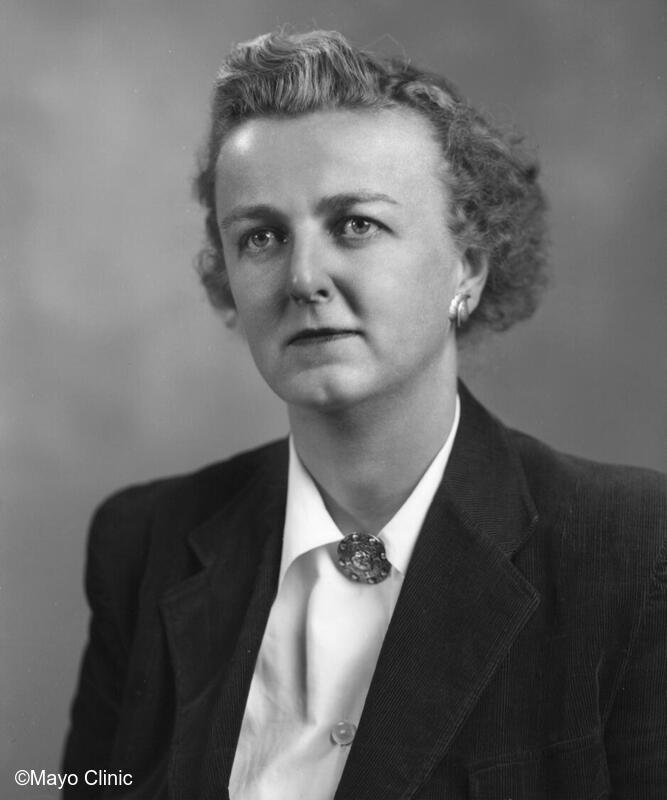
Virginia Hartridge, M.D., earned her M.D. from the Woman’s Medical College in Philadelphia. She served as an officer in the U.S. Army from 1942 through 1946 and while a medical student from 1946 through 1950. She transferred to the U.S. Navy after medical school and served as one of a small handful of navy women physicians on active duty. In 1953 she joined Mayo Clinic as an anesthesiology fellow and came on staff in 1956. She worked primarily in obstetric, general and orthopedic surgery, all at St. Marys Hospital, until her retirement in April 1982. Mary Ellen and I were privileged to share her retirement dinner with her on top of the Hilton Hotel in San Francisco at the annual meeting of the IARS, the last anesthesia meeting that she attended.
Virginia served as the director of our nurse anesthesia training program from 1956 through 1976. Like many other trainees who interacted with Virginia and as a young intern on an orthopedic surgical service, I knew her to be tough as nails. But as a young colleague during her last year on staff, I also knew her to be kind and gracious. Upon her death in 2001, she left most of her considerable estate to the Rochester Area Foundation to support women in domestic abuse situations and single mothers who struggle to raise their families. Her endowed fund continues to make an impact on these two areas today.
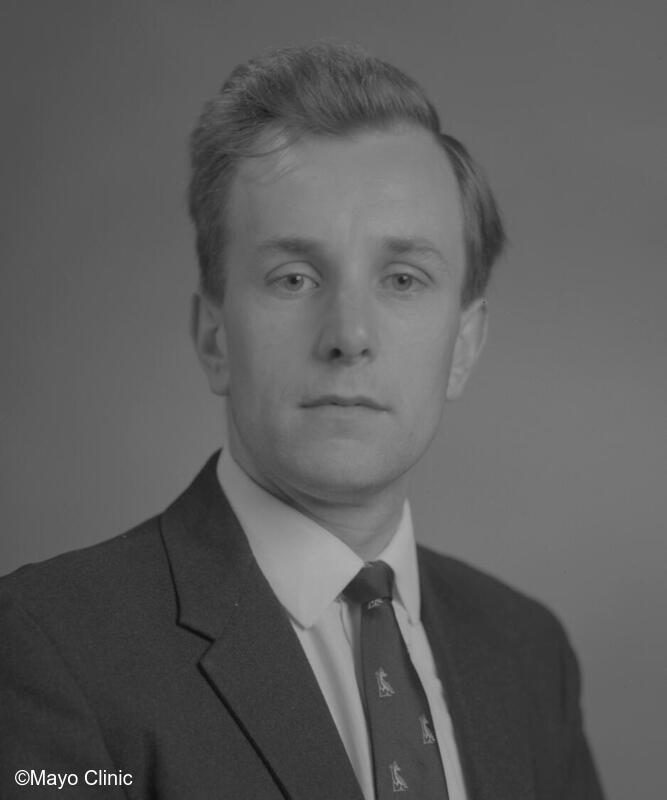
David Hatch, M.D., was a fellow at Mayo Clinic in Rochester in 1967 and 1968. During his time with us, he was involved in cardiac anesthesia, caring primarily for children, and in our fledgling intensive care units with Alan Sessler. Kai Rehder convinced David to stay longer with a six-month opportunity in pulmonary research and he became Kai’s first research fellow. Upon returning to London, he became Consultant at Great Ormand Street Hospital and the world’s first professor of pediatric anesthesia. David made many major contributions to our understanding of the perioperative care of children, especially those cardiopulmonary defects.
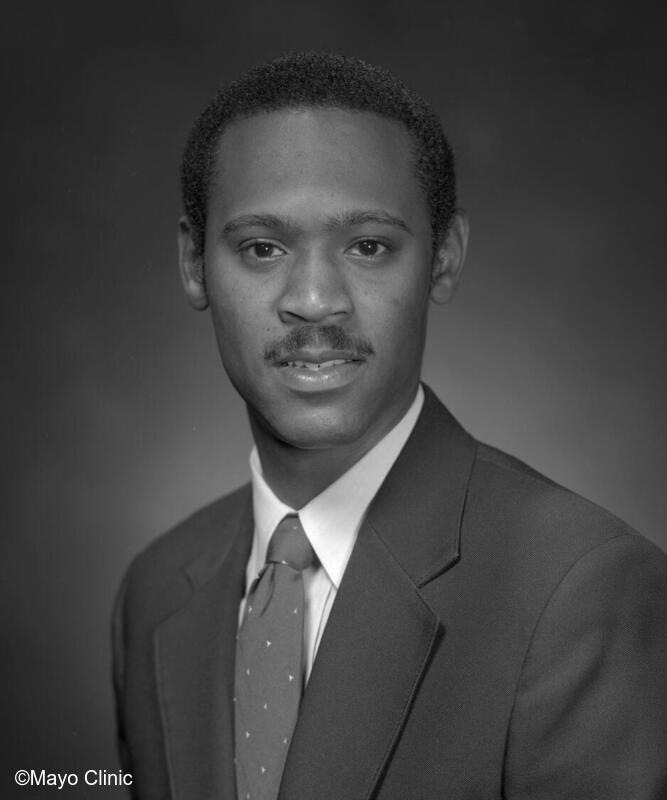
Keith “Tony” Jones, M.D., earned his M.D. at the University of Alabama, Brimingham (UAB) in 1982. After completing his anesthesiology residency in Rochester, Tony trained with Kai Rehder in the physiology of smooth muscle, with emphasis on mechanisms that are responsible for smooth muscle hypersensitivity and asthma. In 2006, Tony, Evelyn, and his children moved back to Birmingham where he was appointed to a named professorship and installed as chair of UAB’s Department of Anesthesiology and Perioperative Medicine. He has subsequently held many major leadership roles within the UAB Health System and its Heersink School of Medicine. He also has been at the forefront of leadership in U.S. anesthesiology as a member of the FAER Board of Directors and chair of the Board of Directors of the IARS. You may read more about Tony at Keith A. Jones, MD | AMGA and Meet medicine leadership in 2022, a series: Get to know Tony Jones, M.D. - Heersink School of Medicine News | UAB.
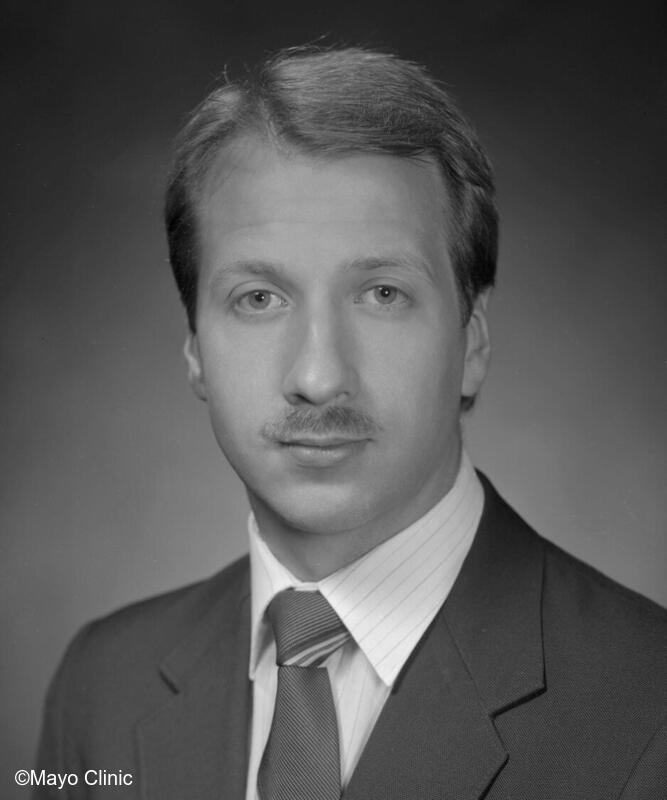
Tim Lamer, M.D., after college and medical school at the University of Wisconsin, he moved to Rochester in 1983 to start our residency training program. He completed his residency as well as a Pain Medicine fellowship in Rochester and has been in the department ever since. He first split his time between the Pain Medicine Clinic and the operating rooms in Rochester. In 1991, Dr. Jim Harper recruited Tim to move to Jacksonville and help develop our Mayo Clinic Florida Pain Medicine practice and a fellowship program.
Tim was a leader in our Florida department during his 16 years in Jacksonville, starting as chair of the Pain Medicine Division and Director of the Pain Medicine fellowship program. In 1997 at the conclusion of Jim Harper’s term as department chair, Tim stepped into that role and served as chair until 2001. During that time period, Tim led the integration of the St. Luke’s private practice anesthesiology group into the Mayo department, opened an outpatient surgical center, and started what is now one of the country’s largest and most successful liver transplant anesthesia teams. He subsequently dedicated his remaining time in Jacksonville to the growth of our pain medicine practice, expansion of our fellowship program, and study of innovative techniques in pain medicine. The Pain Medicine Division became the Department of Pain Medicine in 2004 with Tim as its chair.
In 2007, Tim returned to Rochester and has dedicated his professional efforts to Pain Medicine both internally and externally. Tim has served on the editorial boards of Pain Medicine, the Pain Physician, and Clinical Journal of Pain. For the former, he is the current Section Editor on Neuromodulation and Minimally Invasive Surgery. He is a past president (2019-2020) of the American Academy of Pain Medicine. In addition, Tim has received numerous Teacher of the Year awards and was recognized in 1990 as our Rochester department’s Distinguished Clinician.

John S. Hattox, M.D. was born in Coldwater, Mississippi in 1921. After receiving his undergraduate degree from Mississippi College in Jackson, Mississippi, he earned his M.D. at the University of Tennessee in 1945. At that time, the University of Mississippi did not yet have a medical school. After several years in the U.S. Navy, he moved to Rochester and joined our department as a resident in anesthesiology. He completed his training in 1951. Classmates included Drs. David Massa, inventor of the intravenous catheter, and Robert Devloo, long-time cardiac anesthesiologist in our department. During his time at Mayo Clinic, Dr. Hattox earned a Master’s degree in anesthesiology. His thesis was entitled, “A New Method for the Analysis of Blood Nitrous Oxide and Its Application to a Study of Anesthesia with this Agent.”
Hattox moved to San Diego in 1951 and joined the fledgling Anesthesia Service Medical Group. During his time in that group, it grew to be the largest private practice anesthesia group in the country for a period of time. Dr. Bob Adams, noted below in the story about his dad, Dr. Charlie Adams, served as president of the group from 1983 through 1988. Dr. Hattox remained in clinical practice with that group until retiring in 1990.
As described in Dr. James Arens’ memorial article for Dr. Hattox in 2018, Dr. Hattox was influenced by his former Mayo Clinic instructors as well as past ASA presidents, Drs. Rick Siker and Harry Bird, to participate in the California Society of Anesthesiologists and the ASA. Both Drs. Siker and Bird were great friends of our own Dr. Alan Sessler. Dr. Sessler, one of the specialty’s finest and most successful mentors, also supported Dr. Hattox’s involvement in ASA. Dr. Hattox served as president of the California Society of Anesthesiologists in 1966. He rose to president of the ASA in 1980, with his term as president matching the first years in the specialty as residents for Drs. Steve Rettke, Bob Chantigian, Mary Ellen Warner, and me. He was the first ASA president that I heard present his summary of the year at an ASA House of Delegates’ meeting. Dr. Hattox also served as chair of the ASA’s AMA Section Council in Anesthesiology. He was an ABA examiner. He was recognized for his contributions to the specialty in 1982 when he received the Distinguished Service Award from the California Society of Anesthesiologists and, in 1992, received the Distinguished Service Award from the ASA. He is one of only 8 Mayo Clinic anesthesiology alumni to receive the ASA Distinguished Service Award (Mayo Clinic | Anesthesiology | Department Awards Statistics).
Hattox was married to Kathy Crippen Hattox. Kathy was an amazing spouse, an outstanding lawyer in the San Diego area, and one of the city’s most generous philanthropists. Hattox Hall in The Old Globe Theater in Balboa Park is named from Kathy and John. You may learn more about Kathy at Old Globe Mourning Death of Board Member Kathryn Crippen Hattox - Times of San Diego. Dr. Hattox passed away on December 31, 2017. He was a modest soul. Dr. Bob Adams recalled a time when someone complimented Dr. Hattox on his many successes and contributions to anesthesiology. His response was typical: “Well, I don’t know about that. I do know that if I died tomorrow, all anyone would be asking would be who’s going to take my call that weekend.”
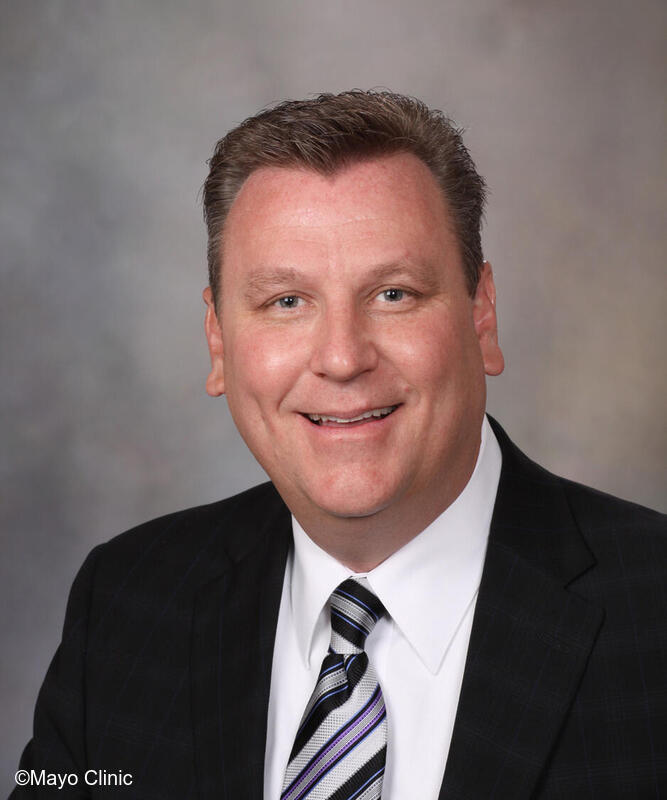
James R. (Jim) Hebl, M.D. was born in Mankato, Minnesota on January 1, 1969. He graduated from Saint John’s University (MN) in 1991 and earned his M.D. at the University of Minnesota in 1995. Jim completed his anesthesia residency, an NIH Clinical Research fellowship, and a Regional Anesthesia fellowship in Rochester. He joined our department as a staff member in 1999.
Jim made many contributions to our department’s clinical practices during his first 17 years on staff. Under the mentorship of leaders such as Drs. Denise Wedel, Terre Horlocker, and Bob Lennon, he gained national visibility in regional anesthesia and acute pain medicine. He was the program chair for the Annual Meeting of the American Society of Regional Anesthesia (ASRA) in 2010; chaired ASRA’s Practice Advisory on Infectious Complications Associated with Regional Anesthesia and Pain Medicine, was an associate editor for the journal Regional Anesthesia and Pain Medicine(RAPM), and served as a member of the ASRA Board of Directors. In 2010, Jim and Dr. Bob Lennon co-edited a textbook, Mayo Clinic Atlas of Regional Anesthesia and Ultrasound-Guided Nerve Blockade.
In our Rochester department, Jim was instrumental in changing our orthopedic surgical practice. For example, he co-directed a multidisciplinary team to develop the Mayo Clinic Total Joint Regional AnesthesiaClinical Pathway. He served in a variety of leadership roles, including chair of our Methodist North Division, program director of our Regional Anesthesia Fellowship, chair of our Community Division, and chair for Integration and Practice Convergence. In Mayo Clinic’s Midwest, he has been a member of its Executive Operations Team and a number of its highest-level committees.
In 2016, Jim had the opportunity to “change careers” without leaving Mayo Clinic when he was appointed as a Regional Vice-President of our Mayo Clinic Health System (MCHS). This transition brought him back to his hometown of Mankato. In this role, Jim currently serves as the senior physician executive for five of our MCHS hospitals, 22 primary and specialty care clinics, and nearly 4,000 staff across southern Minnesota. In May 2024, Jim and his team opened a new $155 million hospital expansion project in Mankato, which is the largest MCHS capital project thus far in Minnesota. With these internal leadership roles, Jim has become a certified executive coach and a new member of Mayo Clinic’s executive coaching team.
On a state and national level, Jim served as president of the Minnesota Society of Anesthesiologists, director and board member of the American Society of Anesthesiologists (ASA), and has been the ASA’s representative to the American Academy of Orthopedic Surgeons (AAOS).
Jim and his wife, Heather, live in Madison Lake, Minnesota, and have 3 children—Zachary, Matthew, and Gabriela (Gabi). Tragically, Gabi passed away in a car accident in 2022. During his free time, Jim enjoys traveling internationally, cooking, reading, and enjoying time with Heather and family and friends at their lake home.
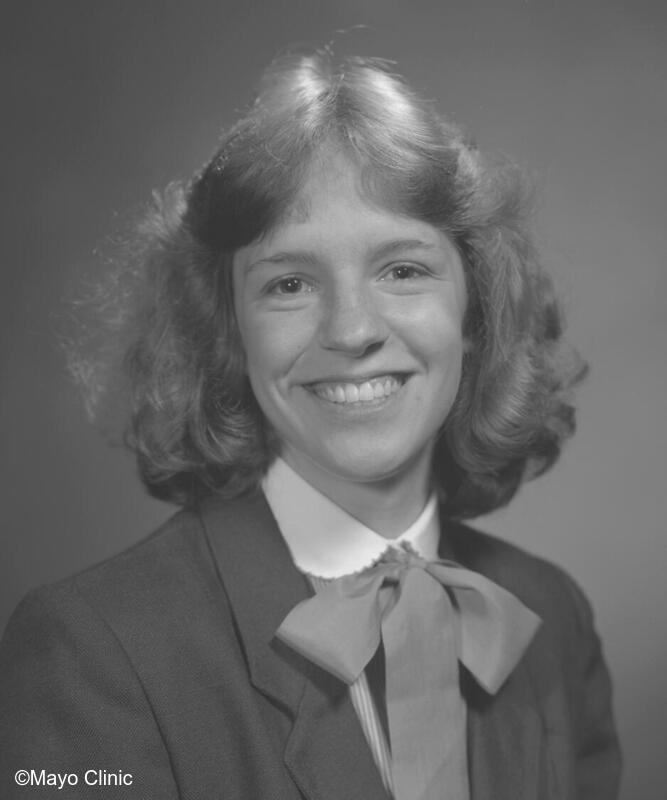
Terese (Terre) Horlocker, M.D., is a native of Rochester, born in St. Marys Hospital on April 2, 1959. She likely has the lowest Mayo Clinic number of any active member of our staff. Terre graduated from the University of Minnesota and Mayo Medical School and then completed her training in anesthesiology here in Rochester in 1989. Classmates in her residency class who worked on staff in the department included Mark Ereth, Bob Friedhoff, Mike Johnson, Tom Losasso, Bill Perkins, Kevin Ronan, and Margaret Weglinski.
Terre has become one of the leading anesthesiologists in the world in regional anesthesia, with special recognition for her work in understanding the risks of anticoagulants and the use of neuraxial anesthetic techniques. Soon after joining our staff in 1989, she began working closely with Dr. Denise Wedel on projects to define the risks of regional anesthesia and especially neuraxial anesthesia. Early papers with Denise and hematologist John Heit led to our understanding of anticoagulation risks and her leadership in developing guidelines for their use with regional anesthesia. These guidelines have been used worldwide for more than a quarter of a century, a remarkable testimony to their value and appropriateness.
Terre has been a leader in regional anesthesia and the department and institution. Examples of her leadership roles and awards include:
- 1998: Chair, FDA Anesthesia and Life Support Drugs Advisory Committee
- 2000: Chair, Division of Methodist North Anesthesia
- 2003: Chair, ASA Committee on Regional Anesthesia
- 2004: Section Editor (Regional Anesthesia), Anesthesia and Analgesia
- 2005: President, American Society of Regional Anesthesia (ASRA)
- 2008: Chair, Mayo Space and Remodeling Committee
- 2009: Recipient, ASRA Distinguished Service Award
- 2011: Recipient, ASRA Gaston Labat Award
- 2011: Recipient, Minnesota Society of Anesthesiologists’ John Lundy Award
- 2020: Recipient, ASRA Trailblazer Award
An excellent story about Terre, told by her, is found in the 2020 ASRA Newsletter about Women in Regional Anesthesia.
Terre retired in May of 2024. Her humor, stories, wit, and knowledge will be sorely missed.

Keith “Tony” Jones, M.D., earned his M.D. at the University of Alabama, Brimingham (UAB) in 1982. After completing his anesthesiology residency in Rochester, Tony trained with Kai Rehder in the physiology of smooth muscle, with emphasis on mechanisms that are responsible for smooth muscle hypersensitivity and asthma. In 2006, Tony, Evelyn, and his children moved back to Birmingham where he was appointed to a named professorship and installed as chair of UAB’s Department of Anesthesiology and Perioperative Medicine. He has subsequently held many major leadership roles within the UAB Health System and its Heersink School of Medicine. He also has been at the forefront of leadership in U.S. anesthesiology as a member of the FAER Board of Directors and chair of the Board of Directors of the IARS. You may read more about Tony at Keith A. Jones, MD | AMGA and Meet medicine leadership in 2022, a series: Get to know Tony Jones, M.D. - Heersink School of Medicine News | UAB.

Tim Lamer, M.D., after college and medical school at the University of Wisconsin, he moved to Rochester in 1983 to start our residency training program. He completed his residency as well as a Pain Medicine fellowship in Rochester and has been in the department ever since. He first split his time between the Pain Medicine Clinic and the operating rooms in Rochester. In 1991, Dr. Jim Harper recruited Tim to move to Jacksonville and help develop our Mayo Clinic Florida Pain Medicine practice and a fellowship program.
Tim was a leader in our Florida department during his 16 years in Jacksonville, starting as chair of the Pain Medicine Division and Director of the Pain Medicine fellowship program. In 1997 at the conclusion of Jim Harper’s term as department chair, Tim stepped into that role and served as chair until 2001. During that time period, Tim led the integration of the St. Luke’s private practice anesthesiology group into the Mayo department, opened an outpatient surgical center, and started what is now one of the country’s largest and most successful liver transplant anesthesia teams. He subsequently dedicated his remaining time in Jacksonville to the growth of our pain medicine practice, expansion of our fellowship program, and study of innovative techniques in pain medicine. The Pain Medicine Division became the Department of Pain Medicine in 2004 with Tim as its chair.
In 2007, Tim returned to Rochester and has dedicated his professional efforts to Pain Medicine both internally and externally. Tim has served on the editorial boards of Pain Medicine, the Pain Physician, and Clinical Journal of Pain. For the former, he is the current Section Editor on Neuromodulation and Minimally Invasive Surgery. He is a past president (2019-2020) of the American Academy of Pain Medicine. In addition, Tim has received numerous Teacher of the Year awards and was recognized in 1990 as our Rochester department’s Distinguished Clinician.
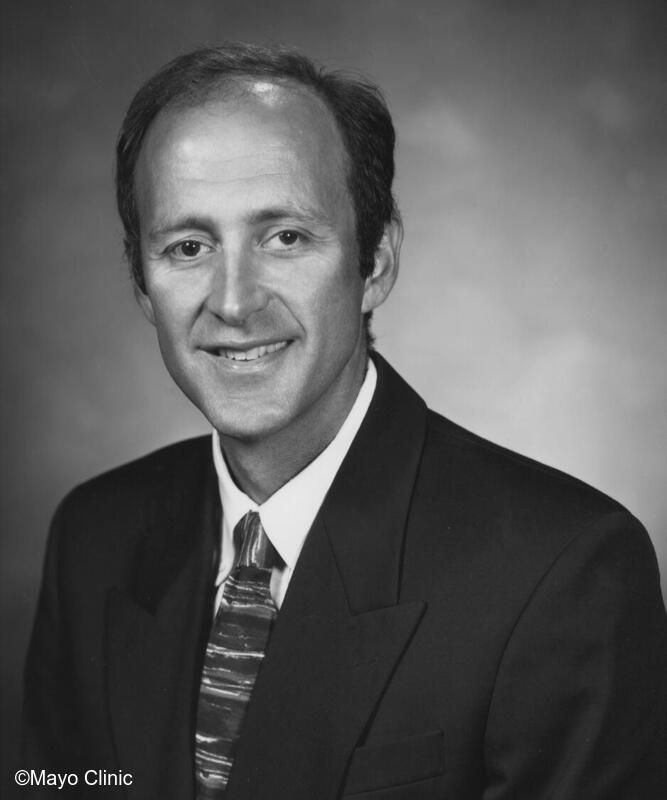
Michael (Mike) Joyner, M.D. was born in Lafayette, Louisiana in 1958 and was raised in Tucson, Arizona. He earned both his undergraduate and medical degrees from the University of Arizona. Mike was an outstanding member of the university’s track team as an undergraduate. During that time, he became involved in human physiology research. He continued this research during medical school, graduating from the University of Arizona College of Medicine in 1987.
Mike joined our Mayo Clinic Department of Anesthesiology in Rochester as a resident in 1987. His classmates included Maria DeCastro, Paul Stensrud, Mary Weber, Doug Dubbink, David Cook, Jeff Jax, and others. Maria and many others, including me, distinctly remember our surprise when Mike asked several complex questions of our visiting professor in July of Mike’s intern year. It was clear at that moment that Mike was going to have a unique and illustrious academic career.
Mike was motivated to be at Mayo Clinic in part by the opportunity to do both clinical training and work with Dr. John Shepherd, a noted physiologist in Rochester. Dr. Shepherd was the first dean of Mayo Medical School, a president of the American Heart Association, and a giant in blood pressure regulation. Mike earned his first NIH grant in 1992 while still a resident and joined our staff in 1993.
He has had many institutional roles on Mayo’s Research Committee, has been involved in leadership teams directing major center grants, and has run a large lab that has been continuously funded by the NIH since 1992. Mike now serves as the department’s Vice Chair for Research. He currently holds a prestigious NIH Outstanding Investigator R35 award. He also is one of the world’s most widely quoted anesthesiologists in the media.
More than 30 fellows have received training in the “Joyner Lab” and many of his Ph.D. fellows now direct independent research programs at major research universities. More than 100 undergraduate and medical students have spent time in his lab, including more than ten current staff members. He is a collegial and caring mentor and facilitator to an incredibly diverse group of mentees and colleagues.
Mike’s research group has made major contributions to our understanding of:
- How blood flow to muscle is regulated
- Sex differences and blood pressure
- Hypoxia
- The physiology of human athletic performance
In March of 2020, early in the COVID-19 pandemic, the US Government asked him to lead an expanded access program for convalescent plasma to treat COVID-19. Mike repurposed his research program and, with his collaborators from around the world, showed that convalescent plasma given early in the course of disease reduced mortality. As the pandemic progressed, he showed that it was especially useful in immunocompromised patients.
Mike and his wife, Teri, have two boys along with Mike’s two daughters.
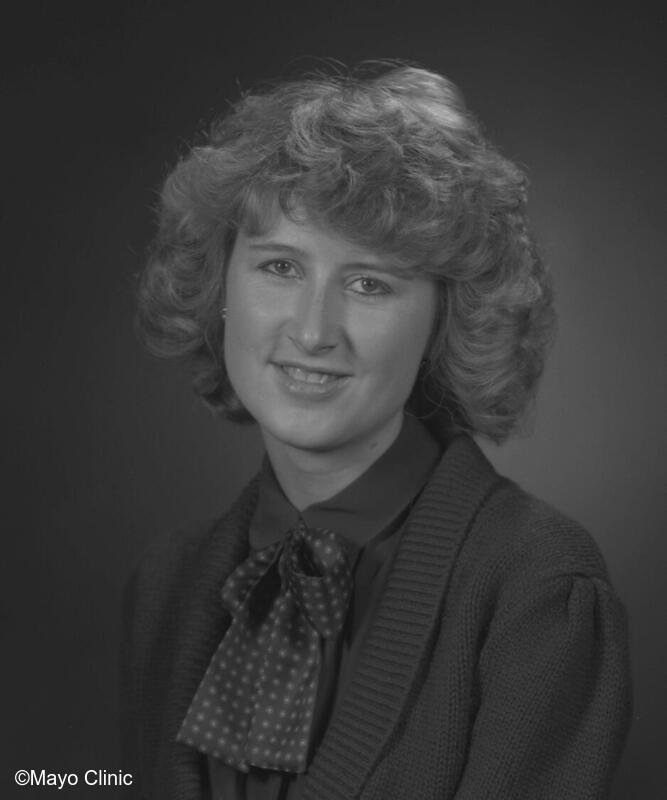
Marlea A. Judd, CRNA, DNP was born in Huron, South Dakota and spent most of her childhood years in very small rural towns in South Dakota and Nebraska. She attended Mount Marty College in Yankton, South Dakota to obtain her nursing degree and was introduced to Mayo Clinic recruiters at the school. She gambled on a big move and the prairie winds blew Marlea to Rochester in August 1983.
Marlea started in the old 4 Mary Brigh critical care unit on the St. Marys Campus and was scared straight by the high patient acuity and the level of complicated surgical patients that Drs. Frank Sims (orthopedic oncology), Peter Pairolero (thoracic surgery), Mike Farnell (emergency surgery), Larry Hollier (vascular surgery) and many other trauma/thoracic/vascular surgeons would send there. Over the next couple of years, she thrived, became the unit’s Charge Nurse and started to consider new opportunities. She was always impressed with the nurse anesthetists who brought patients back from surgery. She contacted Don Nelson, our lead CRNA on the St. Marys campus, and asked to shadow a nurse anesthetist.
After that one experience, she was convinced to enter our training program. Marlea graduated in February 1988. At that time, there were 6 students per class. The school started 2 classes per year. Two of her classmates, Mavis Ward and Mark Solomonson, spent their careers in Rochester. After graduation, Marlea joined our department with a Rochester Methodist position and eventually found her “home” working with pediatrics, EENT, and oral surgery. During her initial years on staff she worked closely with Drs. Allan Gould and Ron Mackenzie and nurse anesthetists Marilyn Crawford, Merry Milverstedt, and JoAnn Haebig. She completed her Master of Science degree from our nurse anesthesia training program in 2001. Marlea was selected as a supervisor for the Methodist Hospital South Division, St. Marys Hospital Cardiac and Vascular Procedural Center, and Obstetric Anesthesia that same year.
In 2001, Drs. Mark Warner and Brad Narr and Rochester CRNA Director Steve Osborn announced the creation of an outpatient procedural practice in the new Gonda Building. Dr. Warner, chair of the department, asked Marlea to team with Dr. Mary Ellen Warner, Dr. Narr, administrator Steve Jorgensen, and Steve Osborn to design, develop, and operationalize a totally new practice model for what was to become the Gonda 7 Outpatient Procedure Center. The unit was built with safety, efficiency and patient satisfaction top of mind. The unit was unique as allemployees (e.g., core nursing staff, surgical staff, and technical support staff) were employed by the Department of Anesthesiology. The all-RN model of care provided surprising flexibility and outstanding expertise for the unit’s varied roles. It was a huge success for the department as well as the patients. The overall practice and business models from that initial Gonda 7 Outpatient Procedural Center has been replicated in many parts of the institution and around the world.
The “outfield” or Non-Operating Room Anesthesia (NORA) practices in Rochester grew 20% annually in the first decade of the century. Marlea and Dr. Mary Ellen Warner established the RN and CRNA Bedside Sedation Team in 2011 to provide safe sedation care to inpatients and decrease the need to bring these patients into the OR. It also was remarkably successful and emulated across the country.
When Steve Osborn, past CRNA Director (1994-2011) retired, the Rochester department had grown to 205 nurse anesthetist full-time equivalents. Two CRNA Directors were now needed to support the practice. Marlea and Jean Guyer, CRNA, DNP were selected for the new positions in 2011 and they continued to grow the nurse anesthesia staff. They faced challenges with introducing and implementing programs and protocols such as QGenda (a scheduling system), EPIC (an electronic medical record), Hemosafe (automated blood distribution system), and standardized glycemic control protocols. It was a busy time, and Marlea, Jean, and the entire department fared well.
In 2014, Dr. Brad Narr, now the Rochester department chair and also the chair of the Mayo Clinic’s Midwest Surgical and Procedural Committee, shared the need for complete anesthesia integration into the Mayo Clinic Health System (MCHS). Dr. Jim Hebl and Marlea were selected to lead that venture. They started by visiting the 18 MCHS sites existing at that time to see how the Rochester department could help them with equipment, resources, or governance to support the institution’s mission and vision. It was a new adventure to learn all of the different struggles and accomplishments that faced these important MCHS sites. When Dr. Hebl moved in 2016 to Mankato to serve as Mayo’s Regional Vice-President for MCHS Southwestern Minnesota, Dr. Sandy Kopp joined as Marlea’s partner to advance our MCHS community anesthesiology practices. By 2018, the MCHS and Rochester practices were both major entities so Marlea transitioned to solely leading the MCHS nurse anesthetists. In Rochester, the department added Bettina Thompson, CRNA, DNP as a new CRNA Director. At that time, there were over 300 nurse anesthetist full-time equivalents in the Rochester practice and 100 of them across MCHS.
Marlea worked at Mayo Clinic for nearly 41 years and retired in April 2024. She lives in Minneapolis and spends time with friends, family, and traveling with her husband, Joe. She continues to advise our department and specifically me as a member of our Centennial Project Team.

Mark T. Keegan, M.D. was born in Dublin, Ireland on October 7, 1968. He was the first in his family to pursue higher education. His parents worked in industries often associated with his home country - his father, Jim, spent his entire working life at the famous Guinness Brewery, and his mother, Pat, calculated horse-racing bets in a turf accountant (aka bookmaker) office!
Mark attended Trinity College, Dublin, graduating in 1992, the year the university celebrated its 400th anniversary, with the degrees of BA MB BCh BAO. He trained in Internal Medicine in Dublin at St. James's and the Mater Misericordiae Hospitals, passing the exam for Membership of the Royal College of Physicians of Ireland in 1995. As part of that Internal Medicine training, he spent 6 months in 1994 as the second person in a newly established visiting resident program between the Mater Hospital and the Mayo Clinic’s Rochester Internal Medicine residency program. He returned to Ireland for a year to work in anesthesia at the Meath-Adelaide-National Children's Hospital before coming back to Rochester in 1996 to complete an anesthesiology residency and critical care fellowship, the latter as a Special Clinical Scholar. While in training, Mark was a chief resident, received the anesthesiology residency In-Training Examination award, the Critical Care Academic Clinician Award, and, in 1999, the Mayo Brothers’ Distinguished Fellowship Award. This latter award is given to 6 trainees every year selected from across the entire enterprise “in recognition of an outstanding record in clinical performance, humanitarianism and scholarly activity”.
In 1999, Mark became my first hire as a new department chair. He served as a Mayo Clinic Special Clinical Scholar (modification of today’s Mayo Clinic Scholar program) while a fellow in Critical Care Medicine during 2000. Since joining the staff in December 2000, he has divided his time between the intensive care units at both campuses in Rochester and the South (now Jacobson) OR division, though since the COVID-19 pandemic almost all his time has been in the ICUs. Additionally, he spent a decade on the liver transplant team. Although primarily a clinician, Mark gained a Masters Degree in Clinical and Translational Science from Mayo Graduate School in 2011 and has expertise in the use of prognostic scoring systems, writing many papers with the late and much-loved Dr. Bekele Afessa from the Division of Pulmonary and Critical Care Medicine. His exceptional article on a novel severity of illness scoring system may be found here. Additionally, prompted by his thoracic surgical ICU experience, Mark mentored critical care fellow Evans Fernandez on a widely cited study that demonstrated the importance of intraoperative tidal volume on the incidence of post-pneumonectomy respiratory failure, leading to significant changes in clinical practice. For those readers who worked with Dr. Afessa, a memorial article about him can be found here.
Starting as a critical care medicine question writer in 2007, Mark has ascended through the ranks of the American Board of Anesthesiology (ABA), serving on multiple committees, as an APPLIED examiner and, since 2016, as a Director. He is currently the Treasurer of the ABA and will assume the ABA Presidency in October 2025, as the second non-North American born president of that organization (Dr. Suresh Santhananam of Chicago has been the other). During the COVID-19 pandemic, he chaired both the ABA Assessments Committee and the ABA Task Force on the Virtual APPLIED examination, leading the development and delivery of a remote form of the final certifying examination to more than 3000 candidates in 2021 to allow career progression when in-person examinations were cancelled.In addition to his ABA work, extramurally, Mark has served as Chair of the American Board of Medical Specialties Ethics and Professionalism Committee and as associate editor-in-chief of the American Society of Anesthesiologists ACE Program.
Mark and his wife, Patricia, who is also from Ireland and is a highly respected pediatric clinical nurse specialist (CNS) at Mayo Clinic, have two high-school age children.
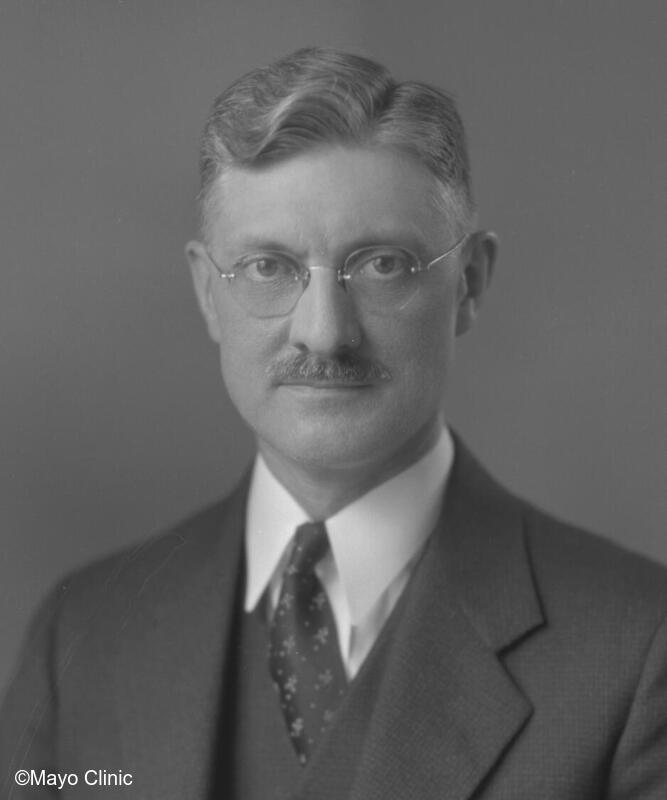
Ralph T. Knight, M.D.was a 1912 graduate of the University of Minnesota School of Medicine. He subsequently trained in surgery at that same institution and started a general surgical practice in Minneapolis. From 1918 through 1920, Dr. Knight was a surgeon in the U.S. Army and served as an Ambulance Battalion Commander on the front lines of WWI’s battles in northern France. Upon the conclusion of the war, he returned to Minnesota and his general surgical practice. His practice was primarily located in the Minneapolis City Hospital (often called the Minneapolis General Hospital and currently the Hennepin County Medical Center) and affiliated with the University of Minnesota. In 1928, recognizing the need for well-trained nurse anesthetists in the Twin Cities area, he organized and started the Minneapolis School of Anesthesia at the University of Minnesota and Minneapolis City Hospital. Alice Anderson was the nurse anesthetist chosen by him to administer the program.
In 1935, Dr. Knight stepped away from his surgical practice, moved to Rochester, and was trained by Dr. John Lundy. His fellow classmate was Dr. R. Charles Adams. Dr. Adams would join our department as a consultant in 1937 and serve as its chair for a brief time in 1952 and 1953. More on Dr. Adams in a later Mystery Photo.
Knight left Rochester upon completing his anesthesia training in 1937, returning to Minneapolis and the University of Minnesota as the chair of its Section on Anesthesia. He was an extraordinary advocate for improving anesthesia care in Minnesota and elsewhere. He became the first professor of anesthesiology at the University of Minnesota and wrote extensively on general anesthesia. In 1947, he started the first state society of anesthesiology in the U.S. He was the first president of the Minnesota Society of Anesthesiologists (MSA), assuming that role on December 3, 1947. The MSA became the newly-founded American Society of Anesthesiologists’ first state component society. He advanced to become ASA’s 1953 president.
Knight was director of anesthesiology at the Minneapolis Veterans Administrative Hospital towards the end of his career. The MSA has a dedicated Ralph T. Knight, M.D. Award to recognize outstanding service to the society. You may read more about Dr. Knight’s career in a summary provided on the website of the Wood Library Museum of Anesthesiology and printed here.

Tim Lamer, M.D., after college and medical school at the University of Wisconsin, he moved to Rochester in 1983 to start our residency training program. He completed his residency as well as a Pain Medicine fellowship in Rochester and has been in the department ever since. He first split his time between the Pain Medicine Clinic and the operating rooms in Rochester. In 1991, Dr. Jim Harper recruited Tim to move to Jacksonville and help develop our Mayo Clinic Florida Pain Medicine practice and a fellowship program.
Tim was a leader in our Florida department during his 16 years in Jacksonville, starting as chair of the Pain Medicine Division and Director of the Pain Medicine fellowship program. In 1997 at the conclusion of Jim Harper’s term as department chair, Tim stepped into that role and served as chair until 2001. During that time period, Tim led the integration of the St. Luke’s private practice anesthesiology group into the Mayo department, opened an outpatient surgical center, and started what is now one of the country’s largest and most successful liver transplant anesthesia teams. He subsequently dedicated his remaining time in Jacksonville to the growth of our pain medicine practice, expansion of our fellowship program, and study of innovative techniques in pain medicine. The Pain Medicine Division became the Department of Pain Medicine in 2004 with Tim as its chair.
In 2007, Tim returned to Rochester and has dedicated his professional efforts to Pain Medicine both internally and externally. Tim has served on the editorial boards of Pain Medicine, the Pain Physician, and Clinical Journal of Pain. For the former, he is the current Section Editor on Neuromodulation and Minimally Invasive Surgery. He is a past president (2019-2020) of the American Academy of Pain Medicine. In addition, Tim has received numerous Teacher of the Year awards and was recognized in 1990 as our Rochester department’s Distinguished Clinician.
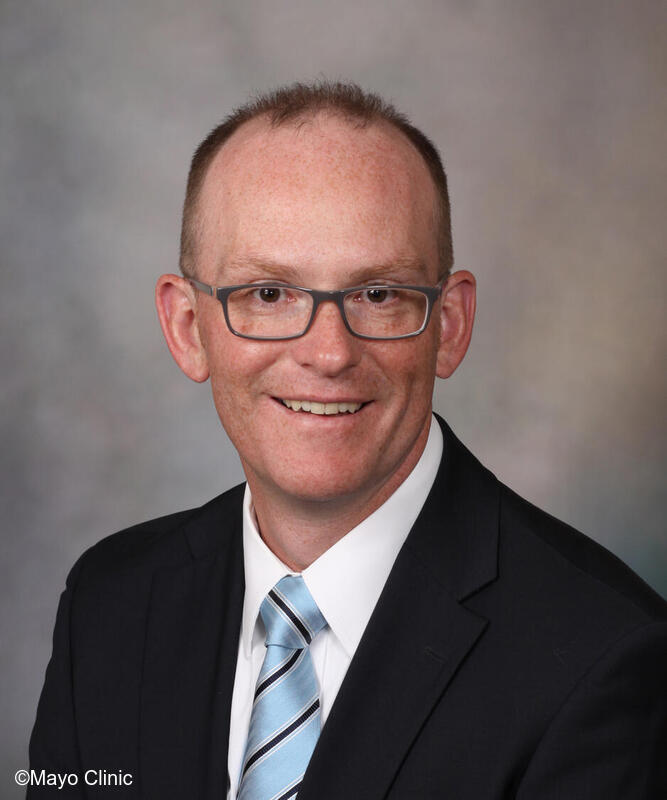
Daryl J. (DJ) Kor, M.D. was born on March 24, 1974, in Marshall, Minnesota and was raised in nearby Cottonwood, northeast of Marshall. He attended St. John’s University in Collegeville, Minnesota from 1992 through 1996. While there, he played football for the legendary Coach John Gagliardi, the winningest coach in American college football. He participated in the 1993 and 1994 NCAA Division 3 semi-finals games and his teams posted a 90% winning percentage over his 4 years of play. He was recognized as both an All-Minnesota Intercollegiate Athletic Conference and an Academic All-American running back in 1995. Definitely an underachiever. Ha!
After graduating from St. John’s University in 1996, DJ attended the University of Minnesota School of Medicine, earning his M.D. in 2001. He was an anesthesiology resident here in Rochester from 2001 through 2005. At that time, he became a Mayo Clinic Scholar and was a critical care medicine fellow for a year. He joined the Rochester staff in 2006. During the next decade, he was honored with Distinguished Clinician and Teacher of the Year awards from trainees in the Department of Anesthesiology and from the Surgical Critical Care fellows. Along the way, he earned a Master’s degree in Clinical and Translation Sciences, receiving it in 2014.
DJ’s academic career has followed several unique paths.
- Data, Analytics, and Information Management.
He has played major roles in creating, expanding, and improving these three fields in the institution. Within the department he has served as the catalyst and medical director for creating our Perioperative Information Management, Implementation, and Analytics Program (PRIISM). This program is expanding to many other areas within the institution and providing data support that is extraordinarily helpful to our clinical practices and research efforts. The institution has recognized his success in clinical informatics by placing him in leadership roles such as medical director for our Center for the Science of Healthcare Delivery’s Clinical Informatics Program, the Unified Data Platform Oversight Group, and the Center for Digital Health Data Analytics program, as well as appointing him Dean of Research Data and Digital Solutions. - Transfusion Medicine.
DJ has been a leader in transfusion medicine within Mayo Clinic and in our specialty. He first obtained an NIH R01 grant related to transfusion practices. He subsequently gained institutional and national visibility in transfusion medicine. He has served as chair of Mayo Clinic’s Transfusion Medicine Committee and as chair of the ASA’s Committee on Transfusion Medicine. He’s been very involved in multiple committees of the American Association of Blood Banks. - Leadership. As a former elite college football player, DJ believes strongly in teamwork, especially on specific projects and across Mayo Clinic’s three mission shields of clinical practice, research, and education. He has become an oral examiner for the ABA and the chair of both the Research Committee and the Education Committee of the Society of Critical Care Anesthesiologists. He is a frequent visiting professor to high profile academic medical centers and is in high demand to speak at annual meetings of the ASA and other specialty societies. In August of this year, DJ became our Rochester department chair. In this role, he oversees a department of approximately 1,400 staff members. We know that he will enjoy the role, and that the Rochester department will benefit from his extensive leadership experience.
DJ and his wife, Molly, have 3 sons ranging from 15 to 20 years of age. Hockey predominates as a family activity, with many weekends and most weekdays filled with events and practices in ice arenas. In whatever spare time they have, DJ and Molly love to travel, preferably to warm places that have sand, sun, and water.

Tim Lamer, M.D., after college and medical school at the University of Wisconsin, he moved to Rochester in 1983 to start our residency training program. He completed his residency as well as a Pain Medicine fellowship in Rochester and has been in the department ever since. He first split his time between the Pain Medicine Clinic and the operating rooms in Rochester. In 1991, Dr. Jim Harper recruited Tim to move to Jacksonville and help develop our Mayo Clinic Florida Pain Medicine practice and a fellowship program.
Tim was a leader in our Florida department during his 16 years in Jacksonville, starting as chair of the Pain Medicine Division and Director of the Pain Medicine fellowship program. In 1997 at the conclusion of Jim Harper’s term as department chair, Tim stepped into that role and served as chair until 2001. During that time period, Tim led the integration of the St. Luke’s private practice anesthesiology group into the Mayo department, opened an outpatient surgical center, and started what is now one of the country’s largest and most successful liver transplant anesthesia teams. He subsequently dedicated his remaining time in Jacksonville to the growth of our pain medicine practice, expansion of our fellowship program, and study of innovative techniques in pain medicine. The Pain Medicine Division became the Department of Pain Medicine in 2004 with Tim as its chair.
In 2007, Tim returned to Rochester and has dedicated his professional efforts to Pain Medicine both internally and externally. Tim has served on the editorial boards of Pain Medicine, the Pain Physician, and Clinical Journal of Pain. For the former, he is the current Section Editor on Neuromodulation and Minimally Invasive Surgery. He is a past president (2019-2020) of the American Academy of Pain Medicine. In addition, Tim has received numerous Teacher of the Year awards and was recognized in 1990 as our Rochester department’s Distinguished Clinician.
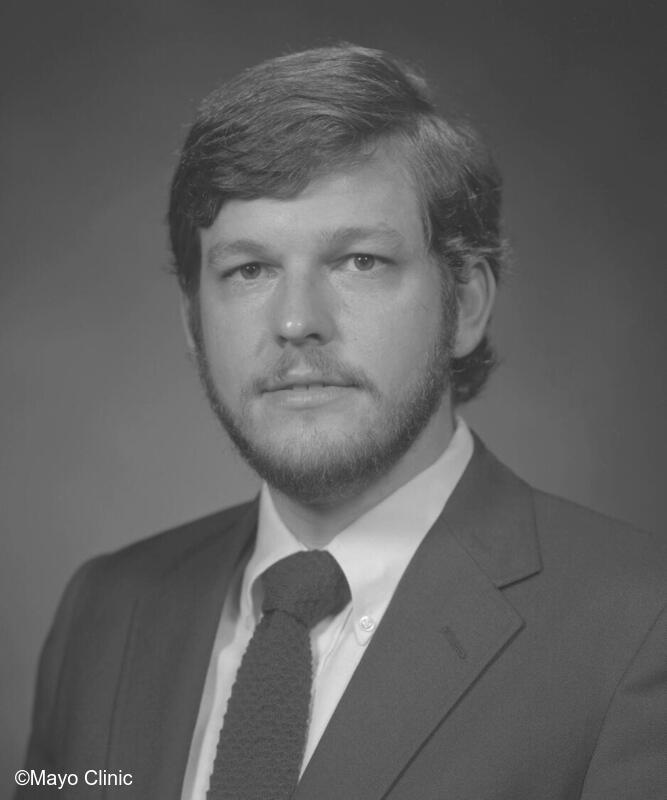
William L. Lanier, M.D. was born on June 8, 1955, in Statesboro, Georgia. He grew up on a farm near Metter in southeast Georgia. He attended the University of Georgia, graduating in 1976. He subsequently matriculated to the Medical College of Georgia. Upon earning his M.D. in 1980, he served as a resident in anesthesiology at Wake Forest University from 1980 through 1983. He followed his residency with subspecialty training in neurosurgical anesthesiology at Mayo Clinic in Rochester and was appointed to the Mayo Clinic faculty in 1984. By 1995, Bill had risen to the rank of Professor of Anesthesiology.
Bill was actively engaged in both laboratory and clinical research throughout his career. For 10 years, he served on the research team of Dr. John (Jack) Michenfelder’s Cerebral Blood Flow and Metabolism Laboratory at St. Marys Hospital. From there, he moved to the Medical Science Building on the Rochester campus where he established and was medical director of the Neuroanesthesiology Research Laboratory for the next 13 years. His original research focused on neuroprotection, cerebral physiology, and clinical neuroanesthesiology. He also published and lectured extensively on quality of medical evidence, medical ethics, and professionalism. Two of his most clinically important lines of research involved (1) augmentation of ischemic brain injury by clinically relevant doses of intravenous glucose solutions or minor changes in blood glucose concentration and (2) modulation of ischemic brain injury by small (e.g., 1ºC) changes in temperature. Notably, the former research resulted in changes in default intravenous 5% glucose fluid usage in anesthesiology practice worldwide and the latter research resulted in changes to how we now manage patients with ischemic brain injuries.
Bill was president of the Society for Neuroscience in Anesthesia and Critical Care (SNACC) in 1994. In 2011, he was named SNACC’s Teacher of the Year and in 2014 was recognized with the SNACC Distinguished Service Award. He was an examiner for the American Board of Anesthesiology from 1994-2014. Additionally, he has been a scientific reviewer or consultant for approximately thirty-five indexed scientific journals. He was a founding section editor for the Journal of Neurosurgical Anesthesiology; a founding editorial board member for Disaster Medicine and Public Health Preparedness; and the senior editor overseeing the conceptualization, planning, and launch of Mayo Clinic Proceedings: Innovations, Quality & Outcomes.
Bill’s many education accomplishments were highlighted in last week’s Centennial Update #45. Bill has been active his entire career and even now in retirement with mentoring high-school-, college-, and medical students, as well as resident physicians and early career faculty in anesthesiology and other fields. More than ten of his Mayo Clinic mentees have joined our departments across the institution and have spent their entire careers on the faculty. He has also mentored students seeking advanced academic degrees in the Mayo Clinic School of Nurse Anesthesia. He has been a strong advocate as well as mentor for trainees of all types during his career.
Bill remained active as a practicing physician until the time of his retirement in September 2021. However, from January 1999 to early-2017, he spent most of his professional effort serving as editor-in-chief of Mayo Clinic Proceedings, the world’s third largest circulation scholarly biomedical journal. At the time of his appointment, the Proceedings was a provincial publication, with authorship of articles overwhelmingly from Mayo Clinic physicians and scientists. During his time as editor-in-chief, and because of promotional efforts for a new Journal vision, authors from approximately sixty nations submitted manuscripts, and the journal’s Impact Factor increased from 2.0 to 7.2. He is the longest serving editor of the Mayo Clinic Proceedings.
Bill is an avid hunter and angler, having hunted and fished throughout North-, Central-, and South America. He has been active in introducing many young people to fishing. He and his wife, Mary, also enjoy gardening, travel, foods, and the arts. Bill and Mary have two children. In September 2023, they moved to their 1,000-acre Zedee Farms north of Metter, GA. The farms have been in the Lanier family for more than 2 centuries. They now actively manage their farms for commercial timber production and wildlife habitat.
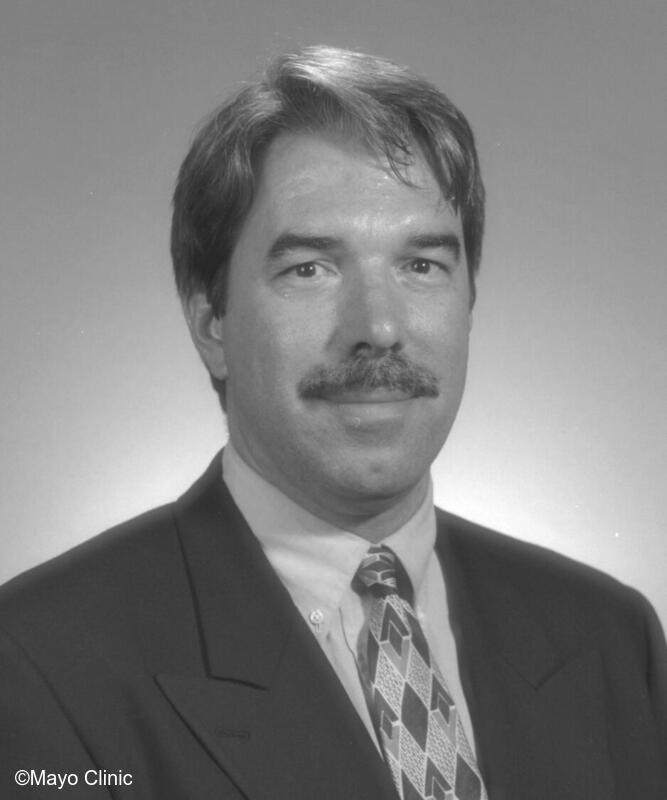
Bruce J. Leone, M.D. was born in Boston, Massachusetts on November 23, 1957. He attended undergraduate school at Harvard University and graduated in 1978. After Harvard, Bruce matriculated to the University of Florida College of Medicine, graduating in the class of 1982. He completed his rotating Internal Medicine internship at Baylor University Medical Center at Dallas, Texas in 1983 and his anesthesiology residency at the University of Texas Southwestern Medical Center (Parkland Hospital) in 1985. Bruce then did a research fellowship in Cardiac Anesthesiology at Parkland Hospital, completing this in 1986, followed by two years as a Senior Registrar at the Nuffield Department of Anaesthetics at Oxford University, UK. He became an Assistant Professor of Anesthesiology at Duke University Medical Center in 1987 and completed a second cardiac anesthesiology fellowship at Duke University Medical Center in 1988.
After a decade at Duke University, Bruce joined our Mayo Clinic Florida faculty in 1998 and helped establish the cardiac and pulmonary transplant programs, working alongside cardiac surgeon, John Odell, M.D. Bruce served as Vice-Chair of the department in Research and Academic Affairs, as well as the general Vice Chair of the department. He also served as Program Director of the anesthesiology residency program from 2013 through 2015. In his education role, he was a long-serving member of our Jacksonville’s Surgery and Surgical Specialties education committee within the Mayo Clinical School of Graduate Medical Education. He was a member of the cardiac anesthesia team at Mayo Florida from 1998 through 2008, when he then transitioned to neuroanesthesia, serving as Chief of Neuroanesthesia Division from 2009 through 2014.
Bruce was active in national organizations such as the ASA. He served on ASA committees related to clinical as well as experimental circulation and equipment and facilities. He was a reviewer for the NIH’s Surgery, Anesthesia, and Trauma Study Section. Bruce was a member of the editorial boards of the Journal of Cardiothoracic and Vascular Anesthesiaand the journal Anestesia en Mexico.
Bruce retired in October 2023 as a Professor of Anesthesiology. He now spends his time traveling between his homes in North Carolina and Florida with his wife Christine and their pets.

Jeff Lunn, M.D. was born in 1952 in Bismarck, North Dakota. His primary interest in high school at Bismarck High related to sports. Jeff went to the National Junior Olympics in Knoxville, Tennessee in 1968 and ran in the 100-yard dash (yes, he is in an age group that came before track in the U.S. switched to the metric system). He also earned athletic recognition in football and basketball. Despite his obsession with sports in high school, he did graduate and go on to North Dakota State University, graduating in 1974. After completing medical school at the University of North Dakota and a surgical internship at the University of South Dakota, Jeff moved to Rochester and was an anesthesiology resident from 1980 through 1982. He then spent a year working with Dr. Duane Rorie as a Special Clinical Fellow in Duane’s lab. In addition to being certified in anesthesiology, he also holds a certificate in critical care medicine.
Jeff joined our staff in Rochester in 1983 and then subsequently joined Mayo Clinic in Arizona in 1992. From 1992 through 1998, Jeff served as the chair of the Department of Anesthesiology during its transition from working at Shea North Memorial Hospital (currently HonorHealth Scottsdale Shea Medical Center) to the new Mayo Clinic Hospital on the Phoenix campus. He also served as the chair of the Department of Critical Care Medicine at Mayo Clinic Arizona from 1996 through 1998. During his time in these leadership roles, Jeff and colleagues established our Preoperative Evaluation Clinic (1995) and the Department of Critical Care Medicine (1996). For the latter effort, he partnered closely with Dr. Joel Larson, his best “wing man” ever. While in Phoenix, Jeff was chair of the Mayo Clinic Arizona Clinical Practice Committee from 1994 through 1997.
In 2007, Jeff moved to Kingman, Arizona and joined the Kingman Regional Medical Center. It serves as the primary center for northwest Arizona and was one of the first medical centers to join the Mayo Clinic Care Network thanks to Jeff and his partnership with Jim Anderson, one of our leading administrators in Mayo Clinic Arizona at the time. While at Kingman, Jeff helped start the hospital’s cardiac surgical program and served in multiple leadership roles, including as Chair of Surgery, Vice Chief of Staff, and Chief Medical Officer. Jeff theoretically “retired” in January 2023 but still works intermittently in critical care medicine on contract.
Jeff and colleagues from Kingman Regional Medical Center formed a non-profit foundation in 2010. “Live Now.” This foundation provided surgical services at multiple locations in Tanzania. In addition, they became involved in the area near Lake Eyasi, Tanzania located at the southern border of Serengeti National Park and immediately southwest of the Ngorongoro Crater. Live Now has helped built a medical center and other facilities for members of the indigenous Hadzabe, Datoga, and Maasai people of that area.
Jeff and his wife, Barb, have finally returned to a lake home in northern Minnesota.

Ronald MacKenzie, D.O., attended Alma College. After graduation from the University of Health Sciences Osteopathic School of Medicine 1967, he was a resident in anesthesiology at Detroit Osteopathic Hospital (2 years), Cleveland Clinic (1 year), and here in Rochester (1 year). He served many leadership roles in the department over his 43 years as a consultant, including chair of the former GYN/ENT (also known as the former South or current Jacobson) Division during Alan Sessler and Roy Cucchiara’s times as department chair. In addition, he served as Vice-Chair of the department during Duane Rorie’s time as chair. Ron also led Mayo Clinic’s Equipment Committee for a number of years. He was an excellent teacher and was recognized multiple times by the residents as Teacher of the Year.
Ron was a wonderful advocate for young colleagues, nurse anesthetists, nurses, and just about all people in general. I don’t believe I ever met anyone who did not like Ron. Ron was a leader by example. He served as president of both the Minnesota Society of Anesthesiologists and the American Society of Anesthesiologists. Personally, for Mary Ellen and me, Ron was a gracious friend and colleague throughout our careers. I started my first two weeks in anesthesia in July 1979 with him, one-on-one in old OR 16 at Methodist Hospital. He ended his career working day-by-day with Mary Ellen as they created and led the evolution of our creative new practices on Gonda 7. He worked clinically until age 77, stopping only to assist his beloved wife, Nancy, as they matured together.
Ron passed away far too early for us all on August 21, 2022.
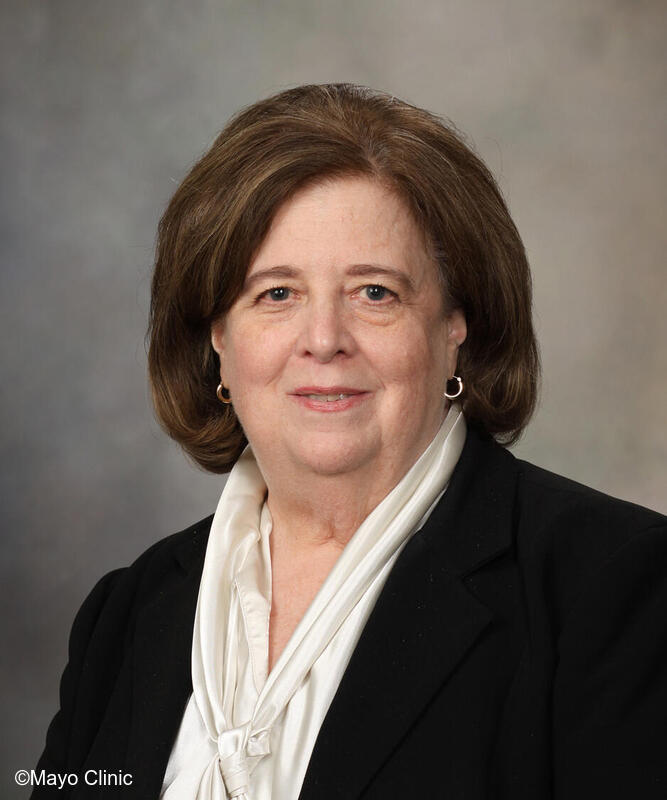
Mary Marienau, PhD, MS, RN, received a nursing diploma from Allen Memorial Hospital School of Nursing (1971), a B.A. degree (1976) from the University of Northern Iowa, a certificate in Nurse Anesthesia from the Mayo Clinic School of Health Sciences Nurse Anesthesia Program (1979), an M.S. degree (1986) from Winona State University, and a Ph.D. degree (2011) from the University of Minnesota. Early in her career she was a nurse at health facilities in Waterloo, Iowa. Dr. Marienau was appointed a staff anesthetist in the Department of Anesthesiology at Mayo Clinic in 1979 and advanced to a supervisory role in 1982. She became director of the Nurse Anesthesia Program at Mayo Clinic School of Health Sciences in 1997 and director of the Doctor of Nurse Anesthesia Practice Program at the school in 2017. Dr. Marienau advanced to the rank of assistant professor of anesthesiology at Mayo Clinic College of Medicine and Science in 1998. She has been active in professional associations and served as an officer and board member of the Council on Accreditation for Nurse Anesthesia Educational Programs. She is the recipient of several awards, including the Outstanding Educator Award from Mayo Clinic School of Health Sciences and the Outstanding Professional Achievement Award from the Minnesota Association of Nurses Anesthetists. Dr. Marienau retired from Mayo Clinic in July 2020.
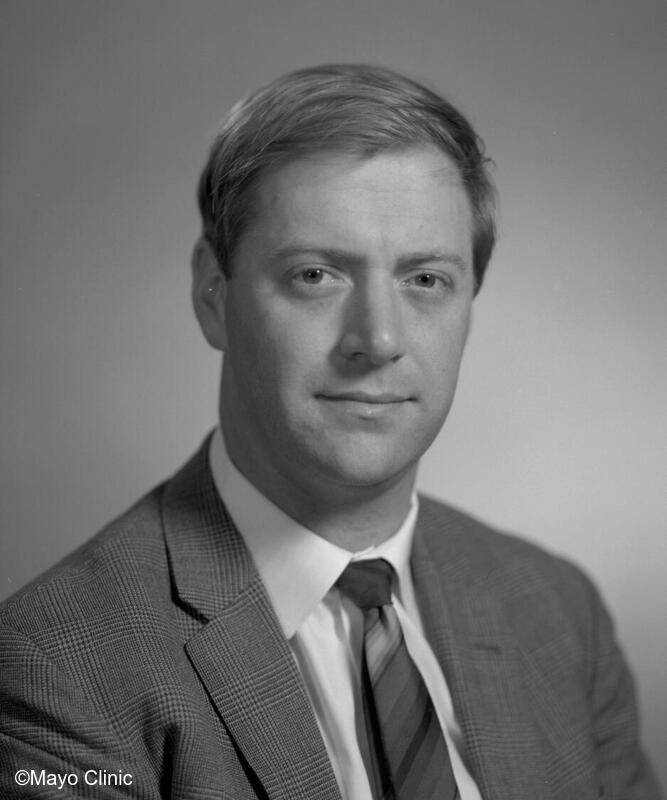
Michael (Mike) Marsh, M.D. was born in Australia on March 7, 1939. He graduated from the medical school at the University of Sydney in 1964. In doing so, he followed his grandfather (1912), his father (1936), and his uncle (1938) as alumni of that school. He subsequently trained in anesthesia at the medical school’s Royal Prince Alfred Hospital.
In 1968, Mike was advised by Dr. Tim Cartmill, a Mayo-trained Australian cardiac surgeon, to go to Rochester. He applied and received a Mayo scholarship to travel to Rochester and study Critical Care and Respiratory Care under the supervision of Dr. Alan Sessler. After arriving in 1969, he also met and worked closely with Drs. Kai Rehder and Paul Didier and Bernard Gilles CRNA and Myron Ricks CRNA. This team of newfound colleagues worked together clinically in the ICUs and also studied the effects of anesthesia, muscle relaxation, and gravity on pulmonary function and ventilation-perfusion matching during mechanical ventilation. The research program was directed by Kai, with collaboration from Drs. Ward Fowler, Fred Helmholtz, and Robert Hyatt.
Mike returned to Sydney in 1972 after a 6-month fellowship in cardiac anesthesia at Toronto’s Western Hospital, using that fellowship to accumulate enough money to pay for his return trip home. The Mayo scholarship that supported his travel to Rochester did not provide funding for a return ticket. Sounds like a good recruitment process, doesn’t it?
Upon his return to Sydney, he was made director of intensive care and charged to establish a general ICU. Building, equipping and staffing a 5-bed unit for this 1,000 bed-hospital took him eighteen months. During that time, he provided consultative services to all patients requiring intubation and mechanical ventilation for respiratory failure. These patients were being cared for on open wards by non-specialized nursing personnel. During that ICU’s first 18 month period using a Mayo-style practice, the 30 day mortality rate for its patients was reduced by 50%.
Mike returned to Rochester and Mayo Clinic in 1974. Dr. Dick Theye invited him to join Alan Sessler, Paul Didier, and colleagues in the ICUs. During the next 15 years his activities at Mayo included a mixture of clinical practice, research, education and administrative roles. While at Mayo, Mike became an oral examiner for the ABA, was very involved in a number of national societies, and developed our ACGME-approved anesthesiology fellowship in critical care medicine. He was the program’s first director.
In 1989 Mike was recruited to Detroit, Michigan’s Henry Ford Health System as chair of the system’s Department of Anesthesiology. His primary task was to apply for ACGME approval for renewal of the institution’s residency program. The previous program had ceased in 1975 and his work entailed starting a research program and developing educational experiences in critical care and pain medicine. For the research program, he started by recruiting our own Russell Van Dyke, Ph.D. The Henry Ford residency program was approved in 1990 and has continued from that time. To this day Mike still provides a half-day teaching session for the program’s residents at each level of training. During all of this, Mike became president of the Wayne County Medical Society and a board director in the Michigan State Medical Society. He also served on the Michigan State medical Board for several years., rising to President and from there to board Membership on the Michigan State Medical Society Board for several Years.
In 1998 Mike transitioned to chair of the Department of Anesthesiology at Wayne State University. The challenge for him was to bring together disparate elements within the Detroit Medical Center, a loose amalgamation of hospitals and anesthesia practices, and revitalize another failed residency program. He supposedly retired in 2012 when our own Dr. Doug Bacon succeeded him. By the way, the program continues but struggles at Wayne State as Detroit Medical Center is now under the management of Venture Capital, a for-profit entity. Neither Mike nor Doug are associated with Wayne State any longer.
In fact, Mike did not retire in 2012. Instead, at Doug’s request, they moved together to St Joseph Mercy Hospital, Oakland in Pontiac, Michigan. Here they started another residency training program, now Mike’s third in Detroit. He served as the new program’s director for a period before stepping down. He worked clinically part-time, primarily at St. Joseph Mercy Hospital, until November 23, 2023, completing a full 60 years of clinical practice and leadership.
Mike’s beloved wife, Eleanor passed away several years ago. They had three children. Now at age 85 years, Mike enjoys watching his five grandchildren as they make their way to their future and meaningful careers and lives.
In Mike’s own words, “Being allowed to practice Medicine in any community is a profound privilege. It places one in a sacred position of trust with intimate access to the lives and confidences of other individuals. The Mayo philosophy and culture places emphasis on honesty, integrity, respect and accountability in serving the best interests of one’s patients, through practice, research and education. It was my great privilege to be accepted to train for two years at Mayo Rochester and then to be invited to return to serve as a Consultant in Anesthesiology and Critical Care Medicine for a further fifteen years in my mid-career.”
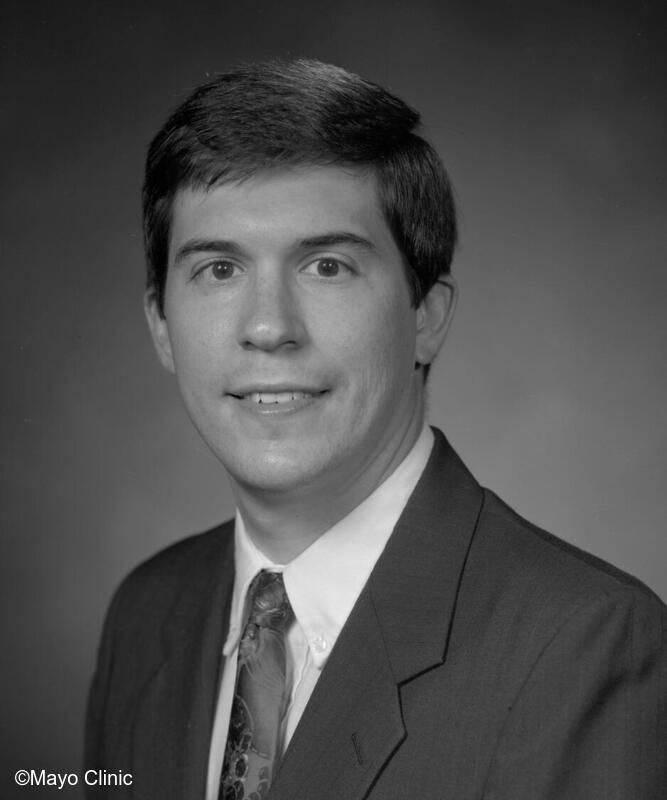
David P. Martin, M.D., Ph.D.was born in Cincinnati, Ohio on April 28, 1964. The family moved to Kokomo, Indiana when he was 6 years of age. He completed undergraduate studies at Indiana University in 1985 and earned his M.D. and a Ph.D. in Neuroscience at Washington University in St. Louis in 1992. After an internship in St. Louis, he moved to Rochester as a resident in anesthesiology, graduating in 1996. Colleagues in his 1996 class who have served as members of our department include Roxann Pike, Todd Kor, and Brian McGlinch. Following residency, he did a fellowship in pain medicine combined with postdoctoral research in the Neurology laboratory of Dr. Phillip Low. Investigations related to that research later contributed to the creation of a high-frequency spinal cord stimulation device that is still used clinically today.
Dave chaired the Division of Pain Medicine from 1999-2001. During an era where it became increasingly challenging to excel in both the operating rooms and Pain Clinic, he chose to switch entirely to the operating rooms, specializing in orthopedic anesthesia and liver transplant. He served as departmental Vice Chair for Safety and Quality from 2010 to 2023 and implemented Safety & Quality Grand Rounds, our Near Miss program, and the SAFE-CAER event review. His roles also included serving as the medical director for the moderate sedation practice for all Mayo Clinic enterprise procedural sites.
Outside of Mayo Clinic, Dave has been an extraordinarily active member of multiple organizations. Within the Minnesota Society of Anesthesiologists (MSA), he has held every office in that society, concluding his time as an officer when he was elected President in 2015. He was awarded the MSA Distinguished Service Award in 2022 for his dedicated effort to sustain and grow the society. He has been very engaged in both committee and editorial board work in the American Society of Anesthesiologists (ASA). Highlights include becoming the founding editor-in-chief of Patient Safety CME Editorial Board, Section Chair for Education and Research, and Director. He was elected ASA Vice President for Scientific Affairs in 2022, an office he holds today. Recently, Dave joined the board of directors of the Foundation for Anesthesia Education and Research (FAER). He also is the current President of the Academy of
The Academy was formerly the Anesthesia Travel Club first started by Dr. John Lundy in 1929.
Dave’s steady hand, tenacity, and vision for the specialty have made him invaluable to our department, the Mayo Clinic, and the ASA and other specialty organizations. Dave and his wife, Laura, have 2 adult children and 3 grandchildren.
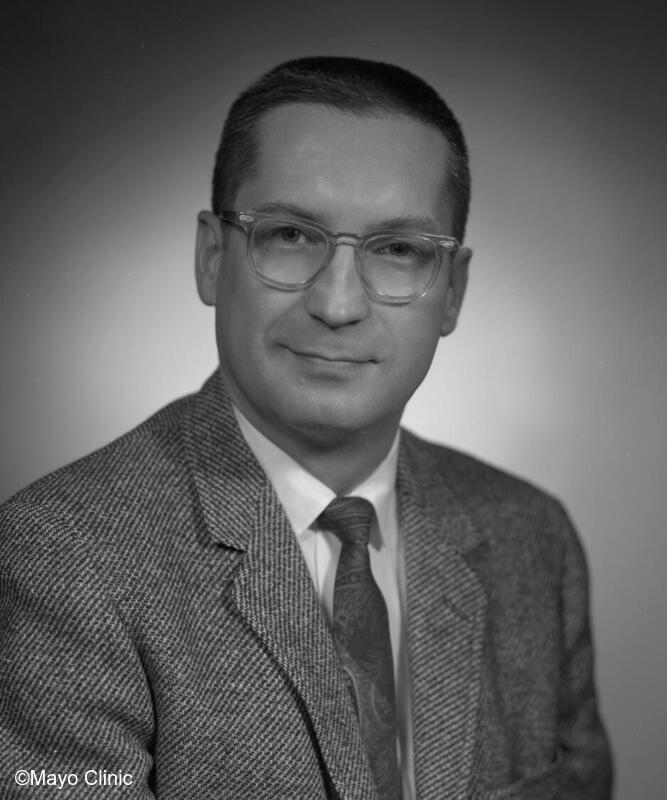
Tom Martin was the first mentor that Mary Ellen and I had when he was chair of the Department of Anesthesiology at the Medical College of Ohio in Toledo. It was Tom who sent us to Rochester for our ASA Medical Student Preceptorships in 1978 and introduced us to Drs. Alan Sessler, Duane Rorie, Jim Prentice, Ted Janossy, Mark Sperry, Gary Baggenstoss, Charley Rich, and so many others great anesthesiologists and residents. Ann Brumm, Jane Post, and Donna Baxter worked in the department offices at that time and made sure we knew how to get to our daily assignments. In those assignments, nurse anesthetists such as Alice Johnson, Jeanne Tiemans, John Carter, Mary Marienau, Jack Hostak, and others graciously tolerated our ineptitude and lack of knowledge and taught us how anesthesia care was provided at Mayo Clinic.
Tom was born in Cleveland, Ohio but grew up primarily in the Cincinnati area. His mother, Clara Martin, worked at Miami University in Oxford, Ohio and started the student boarding system and food services in that institution. Today, Martin Hall is one of the university’s primary dining halls and one that I used my first year at Miami. Tom met Marion, his wife of 59 years, in high school and they became a dynamic couple on the music scene during their time in Rochester (1958-1972). Marion was a master pianist and Tom was extraordinary as a trombonist. Tom was a member of the Mayo Clinic Notochords stage band, the Rochester Symphany Orchestra, and the Rochester Park Band. He also served as president of the Rochester Civic Music organization.
Tom was drafted into the military in 1944 and was the first graduating US. Air Force anesthesiology resident at Lackland Air Force Base (Wilford Hall) in 1948. Tom served as the Air Force’s residency program’s director until moving in 1958 to Rochester to join our department. He was the division chair downtown when the Rochester Methodist Hospital was being built and designed many of the elements in the hospital’s new operating rooms. The hospital opened in 1966. In 1972, Tom moved to New Orleans as chair of the Ochsner Clinic’s Department of Anesthesiology. After a short 2-year stint in that role, he moved to the Medical College of Ohio (MCO), joining Dr. Lucien Morris and colleagues. At MCO, he succeeded Dr. Morris as chair, served as medical director of intensive care and president of the MCO Faculty Senate.
Tom gained international recognition for his reports, presentations, and book dedicated to patient positioning. His text, “Positioning in Anesthesia,” was the primary authority of patient positioning during surgical procedures for more than 3 decades. Tom also was very involved in pre-hospital care training. He was the medical director of the northwest Ohio emergency medical technician program and paramedic training. He continued our department’s leadership of the International Anesthesia Research Society by serving as president of its Board of Trustees from 1979-1981. He was an editor of Anesthesia & Analgesia from 1966-1977. Tom passed away in 2005 in Toledo, Ohio. I was honored to speak at his funeral.

Charles F. McCuskey, M.D.was born November 26, 1893 in Marshall County, West Virginia alongside the Ohio River 30 miles south of Wheeling. After college at Fairmont State College and West Virginia University, he attended medical school at the University of Tennessee, graduating in 1918. He subsequently served in the U.S. Navy Medical Corps in Charleston, South Carolina. After four years in general private practice in Tennessee, West Virginia, and Washington, D.C., he moved to Rochester and started his residency training on January 1, 1925. He was the first trainee of Dr. John Lundy to complete the residency and joined the Mayo staff on July 1, 1926.
McCuskey remained on the Mayo Clinic staff until 1933. At that time he moved to Los Angeles and joined the staff of the College of Medical Evangelists (now Loma Linda University’s School of Medicine). By 1938, he had a growing reputation in anesthesiology and was recruited to chair the newly formed department of anesthesiology at the University of Southern California (USC). He served as chair of that department from 1939 through 1961. In his first year at USC, he also served as the first president of the Pacific Coast Association of Anesthetists (to become the California Society of Anesthesiologists). His early years at USC were interrupted by WWII. From December 1941 through February 1946, he was an active leader in the U.S. Army’s Medical Corps. He ended his distinguished military career as consultant to the Pacific Ocean Area and the Central Pacific Area. He received a Bronze Star and retired as a lieutenant colonel, one of the few anesthesiologists to serve in both world wars.
He was one of just a handful of anesthesiologists in the U.S. to serve as president of his state society (1939), the American Society of Anesthesiologists (1948), the American Board of Anesthesiology (1948) and the Academy of Anesthesiology (1957). He also chaired the Section on Anesthesia of the American Medical Association in 1949. He received the ASA’s Distinguished Service Award in 1953 for his organization of state component societies and hosting the first ASA House of Delegates meeting while he was ASA president.
An excellent summary of his life was published in Anesthesia & Analgesia in 1968. Dr. McCuskey and his spouse, Gertrude, had two children. He died on January 24, 1980.

John McMichan, M.D., received the degrees of M.B.B.S. (1966) and Ph.D. (1976) from Monash University, Australia. He completed an internship at Alfred Hospital (1967-1968), a Royal College fellowship (1970) and surgical residencies at St. Vincent's Hospital and Alfred Hospital (1971-1972) in Melbourne. In 1973 he was appointed a clinical assistant in surgery at Alfred Hospital. Dr. McMichan entered the Mayo School of Graduate Medical Education in 1976 as a fellow in anesthesiology and was appointed a Mayo Clinic consultant in anesthesiology and critical care in 1981. He advanced through the academic ranks to become associate professor of anesthesiology at Mayo Clinic College of Medicine in 1986. During his career at Mayo, he served as director of the St. Marys Hospital Surgical and Respiratory Intensive Care Unit (1981-1987) and the Mayo Graduate School Critical Care Training Program (1985-1987). He transferred to Mayo Clinic in Arizona in 1987 and to serve as head of the Section of Anesthesiology (1988-1992). Dr. McMichan retired from Mayo Clinic in December 1999.
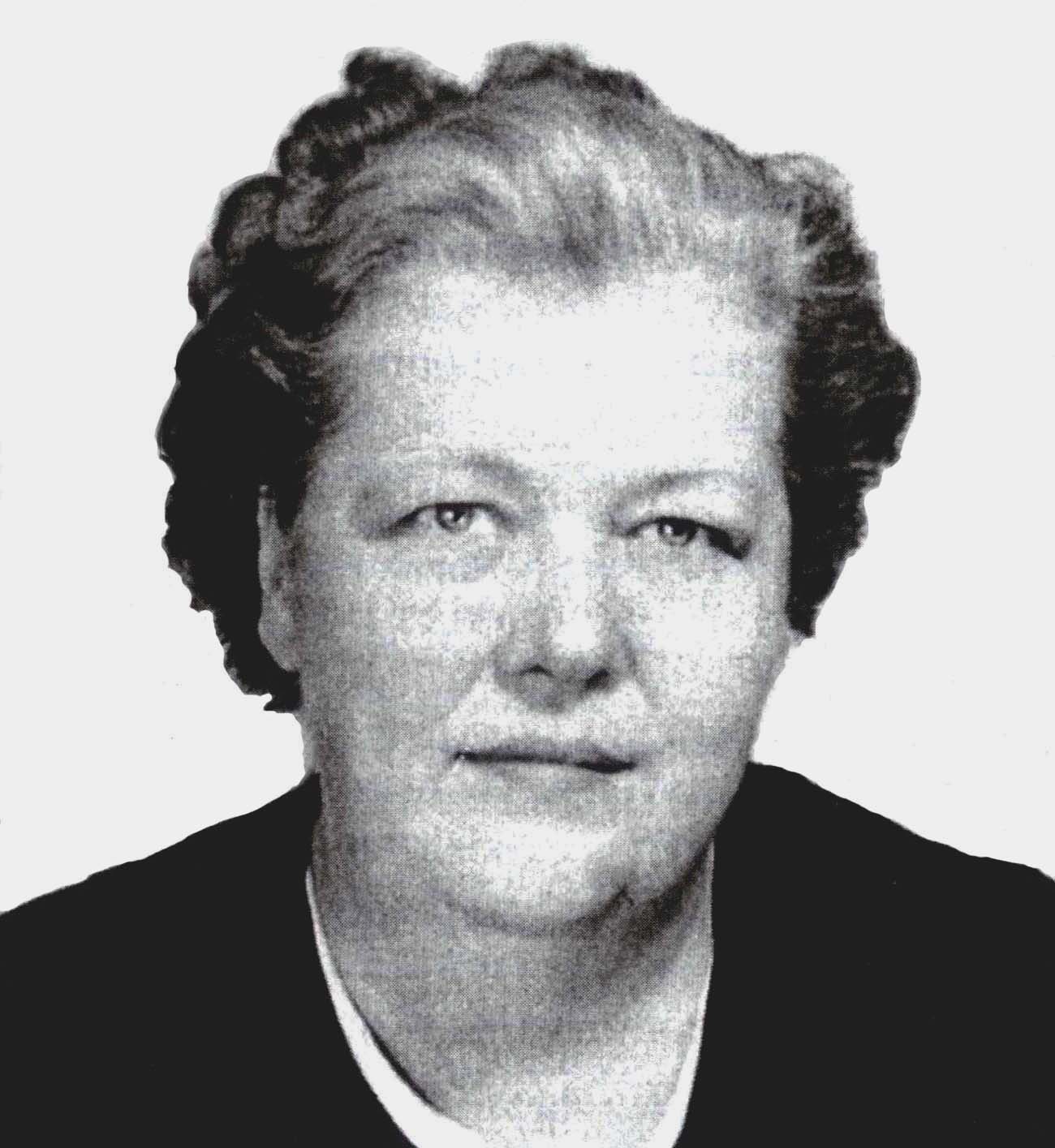
Florence McQuillen, CRNA, graduated from the Central School of Nursing at the University of Minnesota in 1925. She received her anesthesia education at the Minneapolis General Hospital in 1926. John Lundy invited Florence to join his staff at the Mayo Clinic in 1927. She worked closely with Lundy as chief nurse anesthetist, cared for the patients of the Mayo brothers, and served as a clinical instructor for new nurse anesthetists.
In 1936, Lundy asked Florence and Dr. Lloyd Mousel, a new resident, to select papers for presentation at a staff, resident, and nurse anesthetist journal club. Attendees were initially asked to review the papers and prepare reports for the journal club, an additional task that they resented. Within a year, Florence suggested to Lundy that an abstract for each paper be prepared by either her or our Mayo Section on Publications to reduce the burden on the attendees. This proved popular and in 1937 Lundy and Florence began publishing these abstracts in a new format, Anesthesia Abstracts. The journal Anesthesia Abstracts was produced from 1937 through 1966 and was widely read. It’s successor publication, Survey in Anesthesiology, was published through 2017. Florence also prepared abstracts for the fledgling Anesthesiology from 1940 through 1947.
In 1948 Florence resigned from Mayo Clinic and became the first AANA Executive Director (formerly Executive Secretary), a position she held until her retirement in 1970. In her 22 years as Executive Director, she was influential in virtually all areas of the AANA’s growth and expansion. Under her guidance, the US Department of Health, Education, and Welfare officially recognized the AANA’s authority to grant accreditation for nurse anesthesia programs and to grant certification for nurse anesthetists/nurse anesthesiologists. She also instituted the AANA’s voluntary continuing education program, which made the AANA the first professional nursing organization to recognize the need for continuing professional education; this eventually led to the adoption of a mandatory CE program. Florence received the AANA Award of Appreciation in 1970 and the Agatha Hodgins Award of Outstanding Accomplishment in 1981.

Joe Messick, M.D., was born in Wilmington, Delaware in 1935. After college at Wesleyan University in Middletown, Connecticut, he earned his M.D. degree from the University of Virginia School of Medicine. He was a resident in anesthesiology at the Presbyterian Hospital in Philadelphia, one of several hospitals affiliated with the University of Pennsylvania, from 1961 through 1964. He then spent two years in the U.S. Navy. Upon completion of his military duties, Joe moved to Rochester for additional training in anesthesiology and earned his Master’s degree from the University of Minnesota. His mentors for his thesis were Drs. Dick Theye, Albert Faulconer, Ward Fowler, and Jack Michenfelder, a pretty star-studded group. His thesis was directed towards understanding the impact of common anesthetics and adjuvant drugs on whole body and cerebral oxygen consumption rates.
Joe was integrated into what was then, and was to remain, one of the most productive and visible neuroanesthesia groups in the world. He joined colleagues such as Drs. Jack Michenfelder, Kai Rehder, and Gerry Gronert. He was initially assigned to the cardiac group, but when Gerry was drafted into the Army, he was asked to transition to neuroanesthesia. Drs. Roy Cucchiara, and Ron Faust soon followed as members of the group, as did Drs. Leslie Milde and Bill Lanier. It was a remarkable period of discovery in neuroanesthesia. Drs. Thor Sundt, Ed Law, Frank Sharbrough, and others in neurosurgery and neurology contributed. Joe chaired the Section on Neuroanesthesia from 1978 through 1984. During that period he led the introduction of routine use of mass spectrometry into neuroanesthesia in Rochester, a project he and Dr. Duane Rorie expanded to all Rochester operating rooms during the mid-1980s when they chaired the Divisions of St. Marys Hospital Anesthesiology and Rochester Methodist Hospital Anesthesiology, respectively. Their strong support for mass spectrometry and the installation of pulse oximeters into every operating room during their division chair tenures led to advanced intraoperative monitoring that transformed the specialty and patient safety at Mayo Clinic.
Joe served as chair of the Division of St. Marys Hospital Anesthesiology from 1984 through 1988. He earned Teacher of the Year recognition in 1988 as he transitioned his clinical activities and leadership to the management of in-hospital pain. He was indefatigable in that role, starting a pain medicine fellowship and in-patient services at both Rochester hospitals. He chaired the Division of Pain Medicine until his retirement in 1997. He retired as a Professor Emeritus.
It is worth noting that Joe was a wonderful and gentle soul with an amazingly gracious bedside manner. That characteristic served him well throughout his career, whether in patient care or administrative leadership roles. He was president of the Minnesota Society of Anesthesiologists in 1977-1978. He currently resides in Rochester.
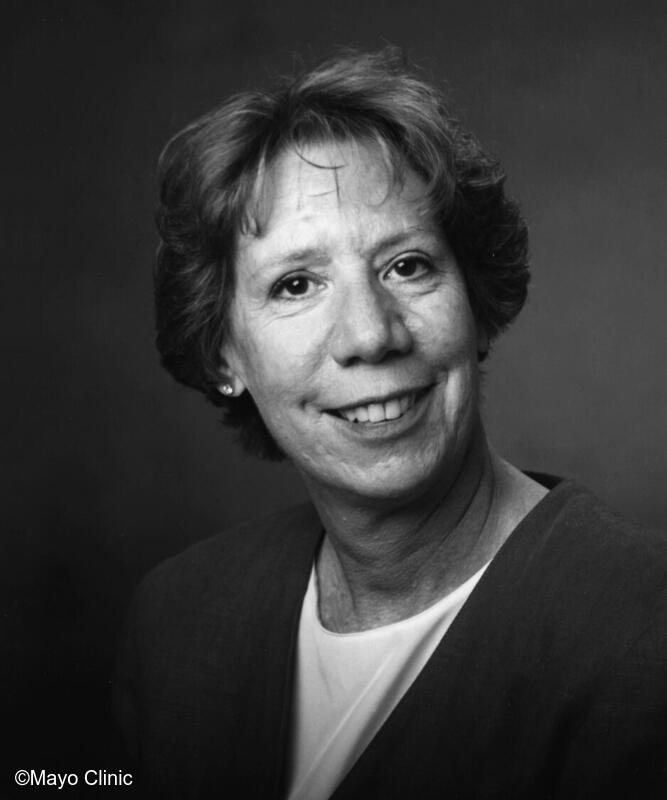
Leslie N. Milde, M.D., was born in Rochester, NY and attended the University of Rochester. She served as the chief pulmonary function and senior clinical research technician in the Cardiovascular Research Institute of the University of California, San Francisco (UCSF) for five years before entering the UCSF School of Medicine in 1973. She completed her anesthesiology residency and critical care fellowship in 1981 at Massachusetts General Hospital, serving as an editor of the widely read MGH Handbook on Clinical Procedures of the MGH while in training. She subsequently moved to Rochester as a neuroanesthesia research fellow with Jack Michenfelder. She joined our staff in 1982 and rapidly rose to the rank of Professor of Anesthesiology in 1993, becoming our department’s first woman to attain that high rank.
Leslie was a champion of anesthesia education, receiving Teacher of the Year awards and serving as the anesthesiology residency’s program director. She served 16 years as an oral examiner for the American Board of Anesthesiology. She was very involved in leading the development of neuroanesthesiology, serving as treasurer of the Society for Neuroscience in Anesthesiology and Critical Care and a long-time editor of the Journal of Neurosurgical Anesthesiology. She also was chair of the American Society of Anesthesiology’s Committee on Experimental Neurosciences and a member of its Subcommittee on Neuromuscular Transmission.
Leslie moved to Arizona in 1994 and served as chair of our Mayo Clinic Arizona (MCA) Department of Anesthesiology from 1997 through 2003. While in Arizona, she made major contributions to the evolution of MCA as a member of the MCA Board of Governors and its Executive Committee and the MCA Executive Operations Team, serving as the Executive Operations Team for six years. In that role she led an Academic Development course for women physicians and an administrative course for administrative interns. She was the leader of Public Relations for MCA during that time period. She subsequently sat on the Board of Governors for the institution and was part of the group to redefine its administrative structure. She chaired a task force to integrate the three existing geographically-define Mayo Clinic internet entities into the one institutional internet site we have today. While on the Mayo Clinic Board of Governors, she simultaneously was a physician member of the Board of Trustees. An endowed travel grant for an anesthesiology resident research winner in MCA has been named in her honor. Although retired in 2010, she continued to provide anesthesia care through 2017 as a supplemental consultant.
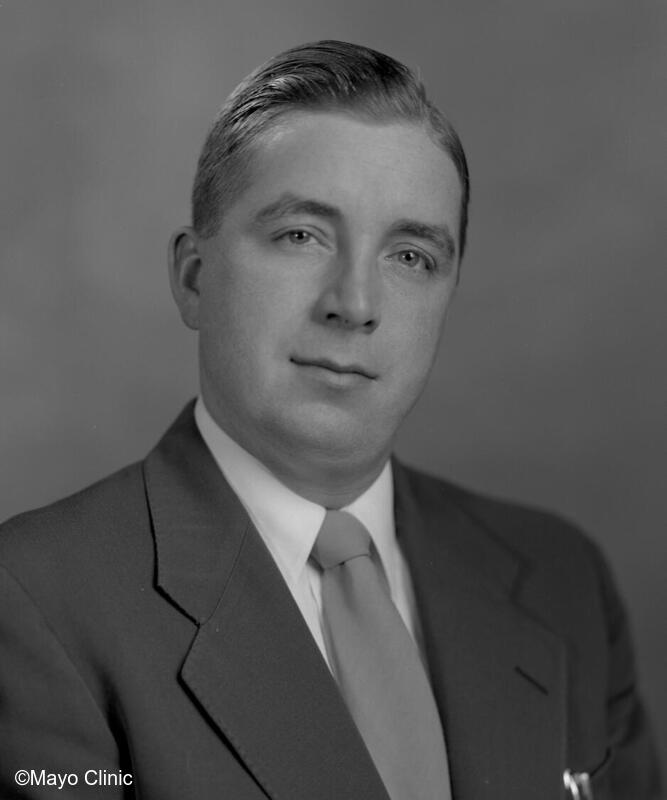
Emerson Moffitt, M.D., was born in New Brunswick, Canada in 1924. He went to the University of New Brunswick in Fredericton, although his undergraduate studies were interrupted by WWII and service in the Canadian Royal Navy Fleet, Air Arm. He graduated from Dalhousie Medical School in Halifax, Nova Scotia in 1950 and entered general practice in North Sydney, Nova Scotia near Cape Breton Island. During his three years in general practice, he delivered hundreds of general and spinal anesthetics, triggering his desire to pursue further anesthesia training. In 1954 he moved to Rochester as a new resident working with John Lundy and others. He became very interested in the launch of the institution’s first cardiopulmonary bypass use in March 1955. Under the mentorship of Dr. Jeremy Swan (of Swan-Ganz catheter fame) and working with colleagues such as Drs. John Kirklin (CV Surgery), Earl Wood (Physiology), and Bob Patrick (Anesthesiology), he studied the physiologic effects of cardiopulmonary bypass and the management of anesthesia, anticoagulation, transfusion, and electrolytes during bypass. His work at that time, augmented by further studies with fellow anesthesiologists Drs. Dick Theye, Bob Devloo, Alan Sessler, and Dick Lundborg, led to the specialty’s fundamental understanding of cardiopulmonary bypass and management of cardiac surgical patients. Our own Drs. Adam Jacob, Doug Bacon, and Hugh Smith wrote an outstanding, well-referenced summary of Emerson’s contributions in 2007. Dr. Peter Southorn also wrote a wonderful, more personal story in 2004 about Emerson’s time at Mayo Clinic in our department newsletter.
Emerson chaired the department’s Division of Anesthesiology at St. Marys Hospital from 1966 through 1971. In 1971, Dick Theye was chosen to succeed Dr. Albert Faulconer as chair of the newly renamed Department of Anesthesiology. Two other valued candidates for that position were Emerson and Dr. John (Tom) Martin. That transition, coupled with the early death of Emerson’s wife in 1972, triggered Emerson to decide to return with his two daughters to Nova Scotia. He was offered and accepted a position as chair of his medical school alma mater’s Department of Anesthesiology.
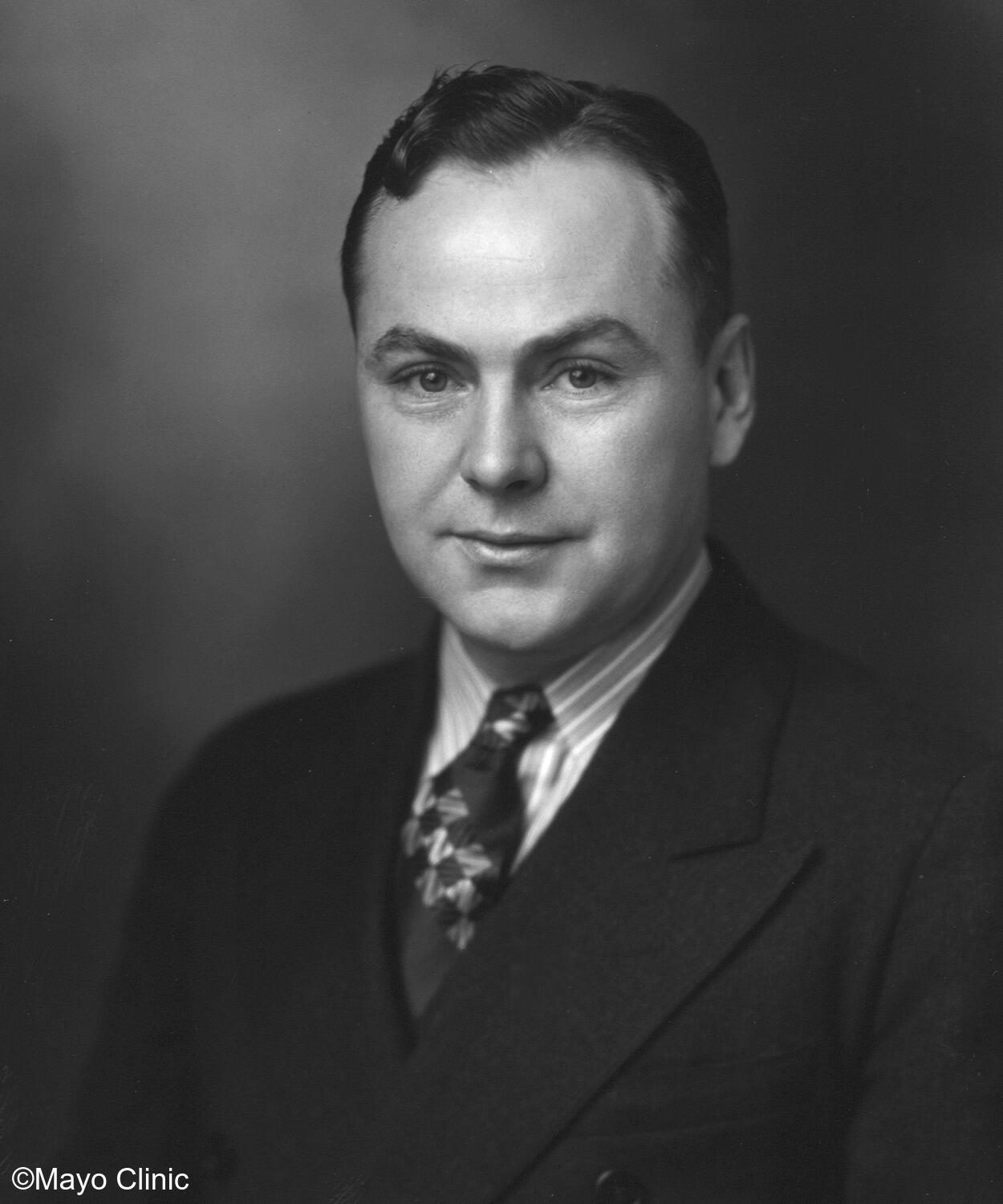
Lloyd H. Mousel, M.D., was born in Cambridge, Nebraska on December 24, 1903. After receiving his M.D. degree from the University of Nebraska in 1930, he did his internship year in Tacoma, Washington and established ties there that would eventually draw him back to the Seattle area later in life. He practiced general medicine in McCook, Nebraska and in his nearby hometown of Cambridge until 1936. He moved to Rochester as a resident in anesthesiology, completing his training and earning a Master’s degree from the University of Minnesota in 1939. His Master’s degree was on the effectiveness of respiratory stimulants during anesthesia and provided him with insights that directed much of his academic career to the study of anesthesia for the nascent use of thoracic surgery.
In 1939, Dr. Mousel was appointed as a consultant in our department, joining a department of 3 other anesthesiologists, Drs. John Lundy, Ed Tuohy, and Charles Adams. Dr. T. Harry Seldon subsequently joined the department in 1940. Although a member of the department until 1946, Dr. Mousel was called to military duty in 1942 and served most of his remaining four years as a Mayo consultant in U.S. Army assignments. Much of his duty was focused in Washington, D.C. running Gallinger Municipal Hospital, a primary hospital in the nation’s capital used for the care of injured soldiers, Marines, airmen, and sailors. He also was assigned as the Army’s leader of anesthesia for thoracic surgery during his service. In this role, he standardized data collection about the care of thoracic surgery patients who received their care in the Army’s 7 designated “thoracic surgery” hospitals. Based on the findings of the accumulated work, he wrote extensively about anesthesia for thoracic surgery, with his insights guiding clinical practices across the country for the article next several decades. His 1947 provides a fascinating look at the development of anesthesia for thoracic surgery and its status, clinical practices, and morbidities during World War II.
In 1946 and upon his military discharge, Dr. Mousel resigned from Mayo Clinic and accepted the position as chief of anesthesia services at the George Washington University, a role he held from 1946 through 1951. He subsequently moved to Seattle and became the chief of anesthesia services at the rapidly growing Swedish Hospital. He worked closely with the University of Washington and his hospital’s anesthesia services became an integral part of the anesthesia training program at the university.
Mousel died on June 13, 1970.

Jeff T. Mueller, M.D. was born on December 31, 1963 in Wichita, Kansas and raised in central Kansas in Salina. He was the first in his family to graduate from college and pursue a professional education. His parents were both raised on small farms. His father’s lifetime occupation was coast-to-coast truck driving. His mother often worked as a part-time secretary and bookkeeper for small businesses. All members of the family helped with the grandparents’ small farms in the summertime.
Jeff completed undergraduate education at the University of Tulsa where he received a Bachelor of Science in Mechanical Engineering in 1986. After graduation he worked as an engineer in the propulsion engineering section of Martin Marietta Aerospace, specifically in the areas of fluid mechanics, heat transfer, and thermodynamics. Jeff entered the Washington University School of Medicine in St. Louis, Missouri in 1989. He graduated from medical school in 1993, followed by an internship in internal medicine and a residency in anesthesiology at Mayo Clinic in Rochester and Scottsdale, Arizona. Upon completion of residency training in 1997, Jeff joined the staff of Mayo Clinic in Arizona. He moved to a private practice in his hometown of Salina, Kansas in 1999 and 2000 and then returned to the staff at Mayo Clinic in Arizona.
Jeff’s practice leadership contributions include serving as the Medical Director of Perioperative Services in Arizona, Medical Director of the Mayo Clinic Hospital in Arizona, and Chair of the enterprise Hospital Practice Subcommittee. During his time as Mayo’s Chair of Hospital Practices, he led the successful enterprise-wide central line standardization and hospital mortality improvement projects which were reported in peer-reviewed publications. Jeff helped re-initiate publication of Faust’s Anesthesiology Reviewwith its fourth edition and has served as an associate editor of the fourth, fifth and sixth editions. During the Covid pandemic, Jeff revived his engineering background and collaborated with faculty at his undergraduate alma mater to successfully research and report on the N95 respirator leakage risks associated with double masking.
Jeff has served as president of the Arizona Society of Anesthesiologists, president of the Arizona Medical Association, and a member of the Arizona Hospital and Healthcare Association Board of Directors. He has also served in many American Society of Anesthesiologists’ leadership roles. These include his service as Vice President for Professional Affairs and Chair of the ASAPAC Executive Board. He is a tireless contributor to these organizations. He has been recognized for his efforts by the Arizona Medical Association with its National Leadership Award (2013), the Arizona Society of Anesthesiologists’ Distinguished Service Award (2023), and the American Society of Anesthesiologists’ Bertram W. Coffer Excellence in Government Award (2015).
Jeff resides in Scottsdale, Arizona with his spouse, Eileen Klein.
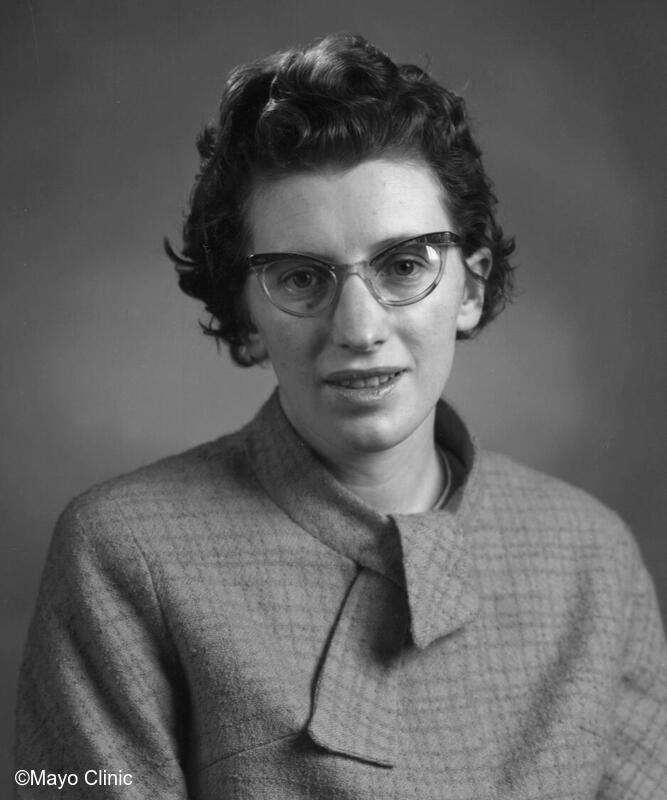
Sheila M, Muldoon, M.D., graduated medical school at the University College in Dublin in 1963. After initial postgraduate training at Mater Hospital in Dublin, she moved to Rochester and started her anesthesiology residency in 1966. During her training, she earned an M.S. degree in anesthesiology and physiology from the University of Minnesota while advised by Dr. Richard They. She was a staff member of our department from 1969 through 1977. While in Rochester, she worked clinically in our growing Respiratory Care Service. She received multiple research grants, including from the NIH, and worked closely with former department chair Dr. Duane Rorie and researchers Drs. Gertrude Tyce and Paul Vanhoutte.
In 1977 Sheila moved to the Washington, D.C. area and was one of the very first women appointed to the new Uniformed Services University for Health Sciences (USUHS) faculty. During her time at USUHS she identified growing military concerns about exertional heat illnesses, including the potential of unrecognized malignant hyperthermia (MH) in military personnel (add link to Muldoon Exertional Heat Illness and MH 2009 here). She established what was to become one of the country’s leading MH testing and research laboratories, now designated as the “Sheila Muldoon Malignant Hyperthermia Diagnostic Center.” The center was one of a handful of muscle testing centers in the U.S. and provided testing services similar to those in our Mayo Rochester laboratory that was led by Drs. Jerry Gronert, Denise Wedel and Margaret Weglinski. Dr. Muldoon was very active in the evolution of Malignant Hyperthermia Association of the U.S. (MHAUS) and its MH Hotline. Dr. Muldoon became chair of the USUHS Department of Anesthesiology in 1987, a position she held until 2001.
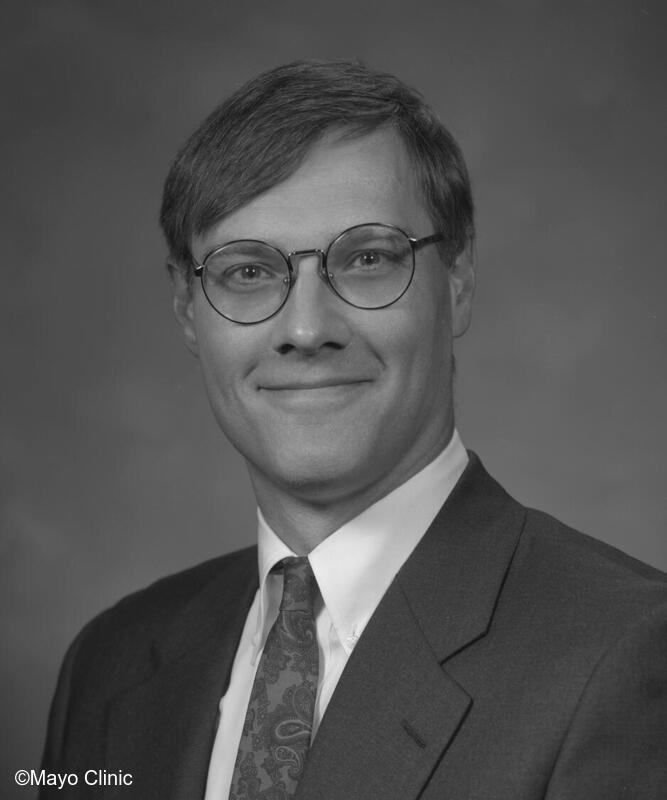
Bradly J. Narr, M.D. was born July 26, 1954 in Neosho, Missouri while his father was in the U.S. Army. By the time he was 6 months old, the family had moved to Minnesota where he was raised and educated. He earned his Bachelor of Science degree in Biochemistry at the University of Minnesota before completing medical school at the same institution in 1980. He came to train at the world-famous Mayo Clinic in Internal Medicine (1980-83) before switching career trajectories in 1983, chiefly because his YMCA basketball friends raved about their respective careers in Anesthesiology. After Dr. Alan Sessler took him to breakfast in the Methodist Hospital Cafeteria in 1985, Brad was invited to join the Anesthesiology consulting staff where, for the first part of his career, he divided his clinical responsibilities between critical care and the operating theaters.
Brad rose to positions of leadership within the department and at Mayo, holding the Department of Anesthesiology chair role for 11 ½ years as well as serving as the vice-chair and chair of the Surgical and Procedural Committee between 2007 and 2021. He is the only non-surgeon to chair this crucial Mayo committee. Brad was also the first medical director of the 10-1 ICU at Methodist Hospital and the first medical director of the 7 MB DE ICUs at St. Mary’s Hospital, both units envisioned and built under his direction. He also pioneered the creation of the Department of Anesthesiology Preoperative Evaluation Clinic which opened its doors in 1996.
Within Mayo Clinic but outside the department, Brad has a distinguished career. While serving as a member of Mayo Clinic’s Executive Operations Team, Mayo President and Chief Executive Officer Dr. John Noseworthy tasked Brad with solidifying Mayo Clinic’s US News and World Report#1 ranking . . . a remarkably successful and satisfying mission for Brad that led to more than a decade of the institution holding the top spot before the magazine switched its operational definitions and stopped awarding #1 positions. Brad also led key efforts within Mayo Clinic, in the city of Rochester, and in the Minnesota Legislature to designate Mayo Clinic/Rochester as a Destination Medical Center in the state of Minnesota. This designation will ultimately bring nearly $600 million of state investment into Rochester’s infrastructure needs as the Destination Medical Center’s $5 billion, 20-year plan and the city’s growth during that period come to fruition.
As he starts his 40thyear as a consulting staff at Mayo, Brad continues to practice in the Preoperative Evaluation Clinic that he helped establish. His Internal Medicine and ICU backgrounds, coupled with his intimate knowledge of the Mayo surgical and procedural practice, help to facilitate patient access to the best surgical, procedural, and anesthetic care available anywhere in the world. He recently was elected as a board member of the Anesthesia Foundation (The Anesthesia Foundation® – Helping Anesthesiologists Succeed).
Brad and his wife, Terry, have 4 sons and many grandchildren, all in MN. He subscribes to the William Mayo quote; “there is no fun like work,” but his joy in life also revolves around his family. He is an amazing physician and colleague.

Lee A. Nauss, M.D., was born in Estherville, Iowa on March 28, 1932. After graduating high school in 1950, he spent two years in the U.S. Army Medical Corps as a corpsman. Upon discharge from the Army in 1952 and working for two years as a trucker in Estherville, Lee met a beautiful young candy striper in the Estherville Hospital while visiting his grandfather. Maria and her family had immigrated to Estherville from the Ukraine during a period of political upheaval. Upon meeting, Lee learned that Maria was interested in nursing school. He drove her to several potential schools. At Allen Memorial Hospital in Waterloo, Iowa, the program director enticed both to join the nursing school. They both graduated in 1956 and moved to Rochester, with Maria working as a nurse and Lee as a student in our Nurse Anesthesia program.
Lee completed our nurse anesthesia program in 1958. He and Maria moved to Juneau, Alaska where he organized a department of anesthesia at St. Anne Hospital. He worked there for 7 years. At the urging of several Juneau physicians, Lee and Maria moved In 1965 to Riverside, California where he could take undergraduate pre-medicine classes at La Sierra University in preparation for medical school at Loma Linda University. However, that opportunity at Loma Linda feel through as he was now more than 30 years old, an age discrimination that seems exception in today’s world. Therefore, in 1966 they moved to Little Rock, Arkansas where the University of Arkansas, Little Rock School of Medicine agreed that he would qualify for entry once he was established for a year as a resident of the state. To become a resident of the state, Lee took courses at the University of Little Rock on Monday, Wednesday, and Friday and worked as a nurse at Children’s Hospital in Little Rock on Tuesday, Thursday, and Saturday. It all paid off as he matriculated to the University of Arkansas, Little Rock Medical School in 1967.
Lee earned his M.D. in 1971. His post-graduate training included an internship in Little Rock and a year of anesthesia residency training at Virginia Mason Hospital in Seattle. He and Maria had planned on his completing his anesthesia training at Virginal Mason and then moving to Alaska. However, there was an epic battle between the state of Alaska and its state board of medical practice at the time and the board essentially dissolved and would not consider applications for new medical licenses. Stuck in a Catch-22 situation, Lee decided to finish his residency training at Mayo Clinic in Rochester.
Lee and Maria arrived in Rochester with their U-Haul trailer in late June 1973 on a Saturday morning. He contacted the anesthesia office and was told that he was on call at St. Marys Hospital that evening. Welcome to Rochester, Lee! His first night on call and in town, he was covering obstetrics at SMH and decided to use an epidural anesthetic for a laboring patient. It wasn’t the first epidural used in obstetrics at Mayo Clinic but it triggered quite a discussion as the obstetricians had previously determined that none of their patients would receive epidurals. To Lee, it was natural as he was trained to use epidural analgesia at Virginia Mason. Ultimately, both Drs. Dick Theye (chair of Anesthesiology) and George Malkassian (chair of OB/GYN) agreed that epidurals were acceptable as long as Lee taught all of the residents to place them.
Upon graduation from residency training, Lee joined the department staff and organized a program for the treatment of chronic pain at Methodist Hospital. He was joined in the effort by the return of former Mayo Clinic anesthesia resident, Dr. Joe Wang (class of 1968). Together they built what is now the Pain Clinic. They were joined in that effort in 1982 with the return of Dr. Peter Wilson from Australia. Peter was a post-doctoral fellow (Fulbright Scholar) at Mayo Clinic in 1976, working on understanding the mechanism of action of opioids and non-opioid neurochemicals (e.g., baclofen) when injected intrathecally.
Lee and Joe were intrigued by the potential of using intrathecal or epidural opioids for the treatment of acute and chronic pain. Mayo Clinic had several key scientists involved in the study of spinal opioids, specifically Drs. Frederic Kerr and Tony Yaksh. At Tony’s urging, in 1977 Lee used epidural morphine in a lung cancer patient who got complete pain relief. It was the first use of intrathecal opioids in a human. After organizing a small study of 7 additional patients who had intractable cancer pain and recruiting Dr. Juergen Thomas of the Department of Neurology to assist, Joe, Lee, and Juergen published the world’s first report of the use of intrathecal morphine in humans. Our own Peter Southorn, Lee’s residency classmate, wrote about this remarkable advance in medicine in a department newsletter.
Lee received multiple Teacher of the Year Awards from the Mayo Clinic Fellows Association in recognition of his exemplary education of anesthesiology residents. He was a gifted clinician, amazing storyteller, and extraordinarily humble and gracious colleague. Lee retired from the department in 1997.
Maria passed away on February 24, 2006. Lee subsequently met and married his current wife, Geri, on January 1, 2009. In a bit of a fairy tale ending, Geri and Lee were introduced together by a couple with whom Lee and Maria had shared a cabin in Alaska, just south of Denali. Lee and Geri currently reside in Rochester.
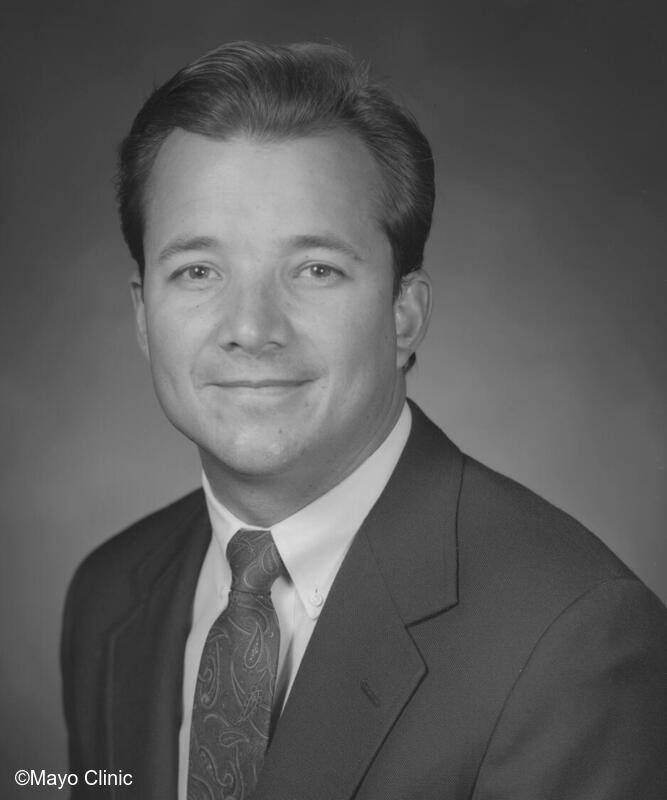
William “Bill” Oliver, Jr., M.D., attended school at the University of Alabama. He was probably the biggest booster ever of Coach Bear Bryant (and later Nick Saban) and the University of Alabama football team. He was a nice guy, regardless. Ha!
After graduating medical school in Birmingham, Alabama in 1983, he moved to Rochester as resident in our department. Bill went on to become one of our most respected and beloved anesthesiologists. He was legendary in his devotion and dedication to children with complex congenital heart disease. Even though personally limited at times by flare ups with cystic fibrosis, he had prodigious levels of energy and tenacity when it came to caring for “his kids.” His compassion was boundless. He received the honorary Humanitarian Award from the Mayo Alumni Association for his dedication to children who have congenital and chronic diseases. He trained many of us in pediatric cardiac anesthesiology and earned the academic rank of Professor of Anesthesiology. Sadly, Bill passed away at age 62 in 2018. Fittingly and not surprisingly, he was on call for the postoperative intensive care unit and its complement of congenital heart disease children that evening.
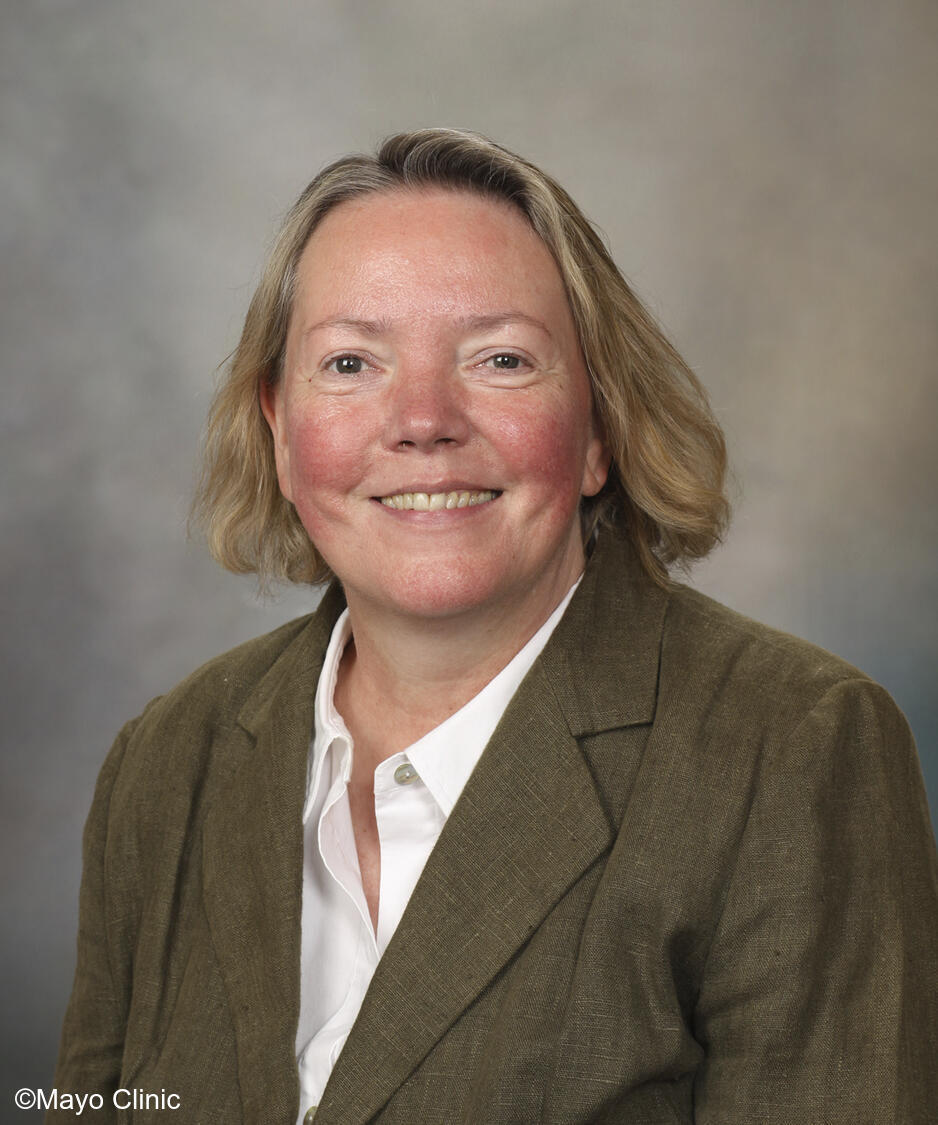
Christina M. Pabelick, M.D. was born in Dusseldorf, Germany where her father was a private practice internist and her mom supported the practice while bringing up Christina and her sister, Judith. Both children were expected to pursue rewarding professions. Judith became a lawyer while Christina pursued medicine at Heinriche Heine University in her hometown (our colleague, Dr. Thomas Comfere, went to the same school a bit later). After earning her M.D. in 1988, Christina was an intern in pediatrics in Dusseldorf. She subsequently trained in anesthesiology and critical care at Goethe University in Frankfurt under the mentorship of the chair Prof. Rafael Dudziak. Upon completion of her training in 1995, Christina received funding from the German government to do a research fellowship at Mayo Clinic. Because Dr. Kai Rehder in Rochester knew Dr. Dudziak, a connection was made with Dr. David Warner. Christina joined David’s lab in 1995.
The first few years as a fellow in David’s lab were tremendously productive for Christina. Beyond the great research on anesthestics and bronchodilation, she got to meet and interact with colleagues such as Drs. Tony Jones, Bill Perkins, and Gary Sieck. Perhaps most importantly, she also met and worked with Dr. Y.S. Prakash, a postdoctoral fellow in Gary’s lab. Collaborations led to Prakash and Christina working together. Their work and growing personal relationship led to a difficult decision for Christina to not return to Germany to become an anesthesiologist “back home.” To our good fortune, we were able to entice Christina to become a resident in our anesthesiology training program. She completed her residency in 2003.
Having Christina as an anesthesia resident during my time as chair of the department allowed me to better understand and appreciate the difficulties that foreign medical graduates encounter, especially those who have already been highly trained in their home countries but are subject to our rules regarding residency training. Using Christina as a case study and leveraging my position at the time as a director of the ABA, we were able to modify the ABA’s certification requirements and its rules for U.S.-based residency training. Essentially, we were able to reduce the re-training time for individuals from countries with training programs comparable to those in the U.S.
Christina spent her 4 years of residency training at Mayo while also helping Prakash go through medical school at the University of Minnesota from 1998 through 2002. They spent a good amount of their free time on the road between Rochester and the Twin Cities. This shuttle romance also helped them consolidate their research programs during this time. During her residency training, we were able to arrange for Christina to become trained in neonatal cardiac critical care at the world renown Great Ormond Street Hospital in London.
When Christina came on staff in 2003, she quickly set up her own research program in airway biology, focusing on what she has been most passionate about: the care of the most vulnerable, especially children. She has spent the past 20 years since working on exciting areas in airway biology at the extremes of age, from prematurity through aging. Her group has explored clinically relevant topics like cigarette smoke and nicotine exposure, the effect of hydrogen sulfide as a bronchodilator, and more recently the impact of Down Syndrome in premature lungs.
Christina is now a Professor of Anesthesiology and Physiology. She distributes her efforts between research, mentoring, administration and OR practice in the Pediatric Anesthesia Division. She has previously served as the Pediatric Anesthesiology fellowship director and as Chair of the Mayo Animal Care and Use Committee (IACUC), a position previously held by stalwart anesthesiologists such as Drs. Bill Lanier and Philippe Housmans. She has been remarkably successful in her research lab. Her success has been recognized in numerous ways, including her selection as chair of the ASA’s Committee on Research, the Scientific Advisory Board of the Association of University Anesthesiologists, and the NIH’s Surgery, Anesthesia, and Trauma Study Section. Christina is also an inductee into the Foundation for Anesthesia Education and Research (FAER) Academy of Research Mentors. Indeed, mentoring is a passion for Christina, and she has served as mentor for many of our junior faculty and emerging leaders. She recently became the Principal Investigator on an NIH T32 training grant that will keep her going in terms of her mentoring. She was appointed this past month as our department’s Vice-Chair for Research.
In her spare time, Christina enjoys working in the garden out in Elgin, Minnesota. She and Prakash now are the owners of the old “Dozois place” (many of you may know of Dr. Roger Dozois, emeritus professor of Colorectal Surgery and his son, Eric, current chair of our Division of Colorectal Surgery). Christina loves taking care of many cats who are all “momma’s boys and girls,” the chickens who think they run the place, the rental goats who want to check out the chicken coop, and the many other animals and birds that know of Christina’s generosity. She and Prakash enjoy traveling when they can, visiting family in Germany and Dubai, touring historic places, and photographing nature.

Robert (Bob) T. Patrick, M.D. is from Des Moines, Iowa and was born on August 29, 1920. After graduating from Denison University in Granville, Ohio, he attended medical school at the University of Louisville, Kentucky, earning his M.D. in 1944. After a two-year period in the U.S. Navy, he entered private practice in Norwalk, Ohio. By 1949, he decided to become a resident in anesthesiology. He came to Mayo Clinic and completed his training, joining the Mayo staff in 1952. While a fresh new consultant in Rochester, he was recalled to the Navy and spent much of 1953 and 1954 back in the service. He returned to Mayo Clinic in late 1954 and stayed until 1961 before leaving to a private practice in Casper, Wyoming. While in Wyoming, he was a member of the state’s medical board. He also became one of the few private practitioners at that time to be asked to serve as a director of the American Board of Anesthesiologists. He was a director of the ABA from 1967 through 1975, including a year as president of the ABA in 1971. More about his career may be found in a 1972 article in the Denison University Alumni Newsletter in which he was recognized by citation.
While at Mayo Clinic for 9 years, he had many remarkable achievements:
- Development of a Cardiopulmonary Bypass Machine. Team member of the Mayo cardiac innovators who tested and developed extracorporeal circulation, the “Mayo-Gibbons heart-lung machine.” Other team members included giants in medicine and physiology such as Drs. John Kirklan (cardiac surgery), Earl Wood and Jeremy Swan (physiology), James DuShane (pediatrics); and Richard Jones (biomedical engineering). An outstanding summary of the development of cardiopulmonary bypass and the first 50 years of cardiac surgery at Mayo Clinic was published in 2005 in Mayo Clinic Proceedings.
- Initial Clinical Trials of Cardiopulmonary Bypass. The primary Mayo Clinic anesthesiologist during the early clinical trials of cardiopulmonary bypass. Dr. Patrick provided the anesthetic care for the first 40 patients to undergo intracardiac surgery from March 22, 1955 through January 1956. This initial trial established the protocols used today for cardiopulmonary bypass and cardiac surgical volumes skyrocketed. The anesthesiologists involved in the team increased with the addition of Drs. Richard Theye, Robert Devloo, and Emerson Moffitt. An excellent story about one of the first children to undergo intracardiac surgery at Mayo Clinic (and in the world) may be found in Smithsonian Magazine at This 1950s Heart-Lung Machine Revolutionized Cardiac Surgery | Smithsonian (smithsonianmag.com).
- Building our Residency Training Program. Lundy implicitly trusted Dr. Patrick and handed over the role of residency program director to him in 1953. As noted above, he served in this role through 1959.
Patrick and his wife, Dorothy Ann, had six children. He passed away on August 30, 1999.

John W. (Bill) Pender, M.D. was born on September 3, 1912, in Hesterville, Mississippi. After earning an M.D. at Tulane University in 1935, an internship in New Orleans, and time in a general practice, Dr. Pender moved to Rochester in 1940 to begin fellowship training in our department. He was called to the U.S. Navy in 1942 and served admirably during World War II, inventing the “Pender Lemon” to assist with administration of ether to injured Marines, sailors, and airmen who required endotracheal intubation for their care. The device allowed careful titration of open drop diethyl ether, reducing spillage, waste, and the risk of aerosolization in the surgical environment and potential fire hazard. Subsequently, it was used in routine clinical practice, especially in cases in which patient positioning did not easily facilitate direct methods of using open drop ether (e.g., unique neurosurgical positions). This device continued to be used in our department until 1978, most often by Dr. Paul Leonard and Lucille Chen, CRNA.
Upon completion of the war, Dr. Pender returned to Mayo Clinic where he remained on the staff until 1954. During this time in Rochester, he published a number of papers. One of his most influential articles reported on the early use of endotracheal intubation in children. His observations (e.g., that the endotracheal tube should fit firmly but not tightly as it passes the vocal cords and through the cricoid ring) were put into practice for many years and continue to represent good practice. Dr. Pender moved from Rochester in 1954 and became chair of the Department of Anesthesiology at the Palo Alto Medical Clinic in California. He continued to be very involved in academics in this private practice setting, attaining a professor rank from Stanford University in 1977 and serving as an associate editor of Anesthesiology from 1956 through 1965. He was elected as a director of the Wood Library Museum of Anesthesiology in 1969, a position he held until 1978. He also was chair of the Section on Anesthesia of the AMA in 1970 and 1971. He became President of the Academy of Anesthesiology in 1965 and was recognized with its Citation of Merit Award in 1983.
Pender and his wife, Catherine, had six children. He died in 2001. Upon his death, he bequeathed a “Mayo Room” at the Wood Library Museum. You may read about the room and Dr. Pender’s many contributions in this storyby Dr. Mary Ellen Warner that appeared in our department’s newsletter in January 2005. Dr. Pender also provided a leadership gift to establish the John W. Pender, M.D. Collection of the Living History of Anesthesiology at the museum (Living History Interviews - Wood Library-Museum of Anesthesiology (woodlibrarymuseum.org). This collection contains nearly 150 oral histories of leaders in anesthesiology and continues to grow in number annually.
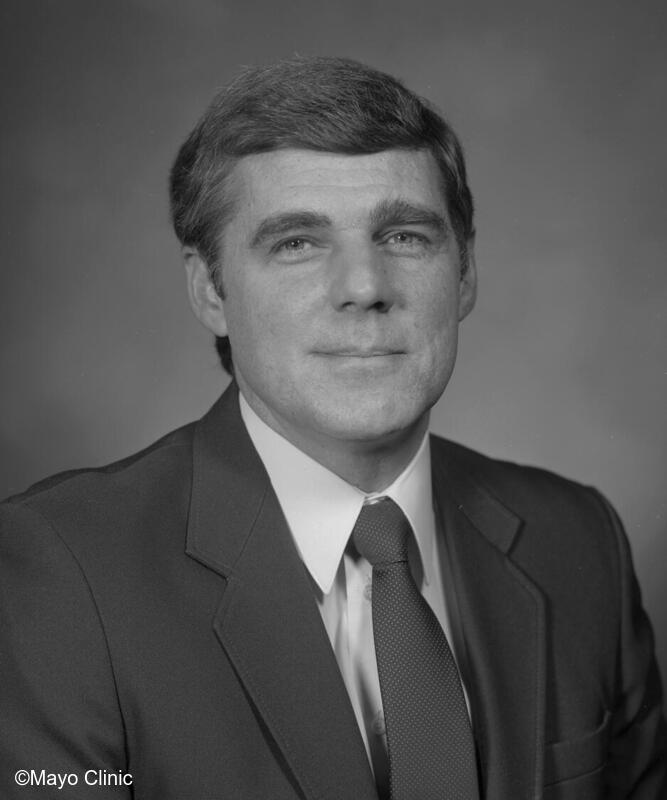
Bud Polk was our first nurse anesthesia supervisor in Jacksonville when he moved from Rochester in 1986. Bud was born in Independence, Iowa. He completed his nurse anesthesia training in Rochester in 1968. After one year working in LaCrosse, Wisconsin at Gunderson Lutheran Hospital, he was recruited back to Rochester by Dr. Emerson Moffitt, chair of our Division of Cardiac Anesthesia. He served as the supervisor for our cardiac practice, working closely with Emerson and others in the operating rooms and on research projects. Things were soon to change for Bud, though.
Our intensive care units (St. Marys Hospital and Rochester Methodist Hospital ICUs) were established in 1966 by Dr. Albert Falconer (chair of the department from 1955-1969). Paul Didier, with Renee Caspersen, CRNA, developed the Methodist Hospital ICU and Dr. Alan Sessler, with Bernie Gilles, CRNA, developed the St. Marys Hospital ICU. Bud joined the expanding Section on Intensive Care in 1972 as the new supervisor of our intensive care services at RMH. Other key members supporting the growing number of intensivists and critically ill patients included Myron Ricks, CRNA (1970), Lester Clapp, RT (1971), and Tom Holtackers, PT (1972).
In 1982, Bud transitioned back to the operating rooms, working closely with Steve Schmidt. Four years later, he decided to move to Jacksonville. He was joined by colleagues Drs. Jim Harper and Tim Shine and nurse anesthetists Linda Buck, Alicia Cassabar, and Phil Klineschmidt. These six individuals provided the anesthesia care for the Mayo Clinic patients who were receiving their care at St. Luke’s Hospital in south Jacksonville. They were joined by others in 1987 and, by 1988, they were appointed as a group to be the Department of Anesthesiology at Mayo Clinic in Jacksonville. Jim Harper served as the department’s first chair. Parenthetically, the department cooperatively worked with the pre-existing private practice anesthesia group at St. Luke’s Hospital for a decade until the department took over full provision of anesthesia services for all patients in 1996. Bud served as the supervisor for the new department during its first 5 years before Linda Buck, CRNA succeeded him in the role in 1991. From 1991 through 2003, Bud provided care for cardiac patients and joined the nascent liver transplant service.
Bud retired in 2003 and lives today in Palm Coast, Florida. Palm Coast has 26 miles of saltwater canals connecting to the ocean, fitting Bud’s love for boating. In fact, he was a yacht broker for a period of time after his anesthesia career.
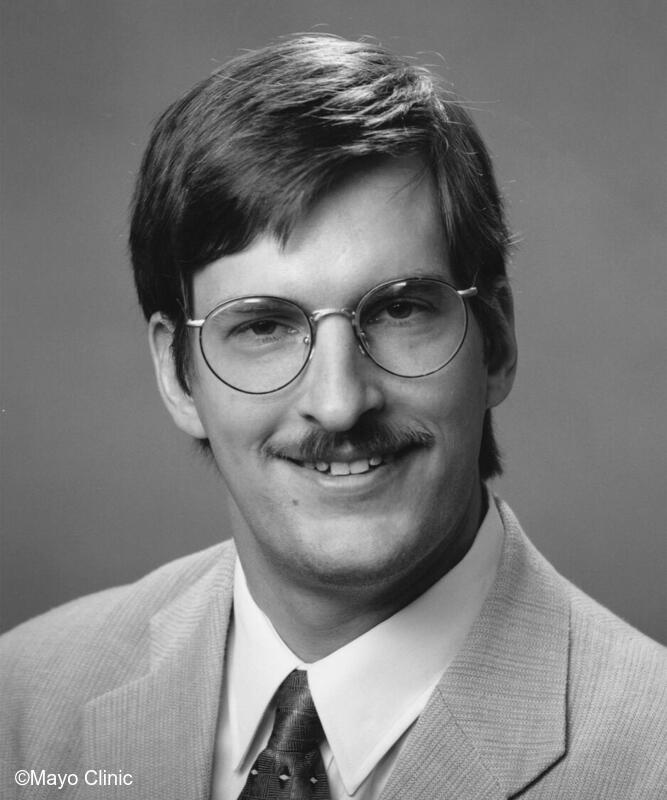
Karl A. Poterack, M.D. was born in Grand Rapids Michigan on March 25, 1961. He received his undergraduate and M.D. degrees from the University of Michigan, graduating medical school in 1985. Karl started in a general surgery residency program at the Medical College of Wisconsin in Milwaukee but after two years realized that he didn't have a particular love for operating and instead enjoyed taking care of sick patients. So luckily there was an open spot in Dr. John Kampine’s anesthesiology residency at the Medical College of Wisconsin and he started his anesthesia training in 1987. After finishing residency and then a neuro-anesthesiology fellowship at Milwaukee in 1991, he was obligated to pay back a military obligation from medical school. He was assigned to Wilford Hall Medical Center in San Antonio, TX where he was a staff anesthesiologist for four years.
After leaving the military in 1995 as an Air Force major, Karl returned to the Medical College of Wisconsin for two years where he was a section chief of anesthesiology services at Froedtert Memorial Lutheran Hospital. He was recruited by our own Dr. Leslie Milde to join the Mayo Clinic Arizona anesthesiology department in 1997. At that time, the department was providing outpatient surgical anesthesia in the Shea Blvd. Clinic Building and providing inpatient care at what was then Scottsdale North Hospital while the new Mayo Clinic Hospital was being completed. After the new hospital opened in 1998, Karl was the anesthesiologist for the first anesthetic given in it and the 1st liver transplant that was performed there in 1999. He was part of the liver transplant anesthesia team for the next 20 years as that program grew to be the largest solid organ transplant program in the U.S.
During his Mayo career, Karl has served in multiple roles, including Director of Quality Improvement for the department, Medical Director of Surgical Services, chair of the Mayo Clinic Arizona Accreditation and Regulatory Subcommittee through 4 cycles of Joint Commission surveys, as well as Medical Director of Clinical Informatics in the institution’s enterprise-wide Center for Information and Knowledge Management. In 2014, he became board certified in Clinical Informatics, one of the first anesthesiologists in the initial group of physicians nationwide to be boarded in this new specialty.
Karl and his wife, Stephanie, have 4 children ranging in age from 36 to 9, and a 3-year-old grandson. They live in Phoenix with their youngest son, Carson. In Karl’s spare time, he enjoys travel and photography.
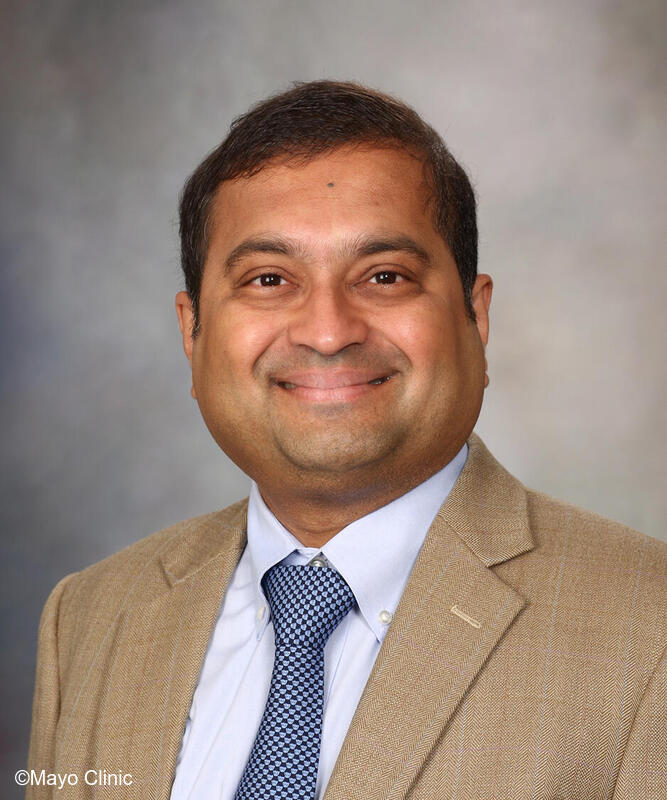
S. Prakash, M.D., Ph.D., was born in India and grew up in multiple places in Western India as his engineer father moved every few years to try something new in the field. After high school, he gained entrance into the highly competitive Indian Institutes of Technology (IITs) and finished a degree in Electrical Engineering from IIT Bombay in 1988. He garnered a scholarship from the University of Southern California (USC) in Biomedical Engineering (BME). While at USC, he joined the lab of Dr. Gary Sieck, our distinguished colleague who was then a faculty member at that institution in BME working on respiratory physiology. As you know, Gary got recruited by Dr. Kai Rehder to come to Mayo Clinic in Rochester in 1990 to join our department as Vice-Chair for Research.
Although Prakash loved sunny Southern California, his USC chair convinced him of this amazing place called Mayo Clinic where he could do world-class research working with amazing teams with amazing resources (Prakash’s own words). So, after earning his M.S. in BME in 1990 and having never actually visited Rochester or the Mayo Clinic, Prakash packed his worldly belongings in his little Brazilian-made Volkswagen Fox and drove cross-country, camping in multiple national parks along the way. After an all-night driving marathon from Yellowstone National Park through Wyoming, South Dakota and Minnesota (well before the age of GPS, using AAA TripTiks), he arrived in Rochester: and drove right through it not realizing how small the town actually was.
After this pass-through introduction to Rochester and turning around back to Rochester, Prakash got his first taste of the Mayo way when he realized that nobody at the Mayo Graduate School knew he was coming! And that he was not going to get a paycheck until the paperwork was cleared! Kai Rehder picked up a phone and with his usual soft and gentlemanly manner convinced someone to give Prakash a $500 check so he could survive for at least his first week.
Prakash spent the next 4 years at Mayo Clinic in Gary Sieck’s lab getting his PhD in physiology (1994). Along the way, a lot of us in the department got to know Prakash for his quirky ways and his fun attitudes. And never following the Mayo dress code. However, we also got to know him for his research and his potential as he then took a postdoctoral research fellowship in our department. It was during this time that Prakash met Dr. Christina Pabelick who was then a research fellow in Dr. David Warner’s lab down the hall from the Sieck lab in St. Marys Hospital. They worked together for a while before they got together with a lot of our encouragement and are now happily married.
And that’s where things got interesting. Prakash was fascinated by all the medicine around him and decided to apply to medical school while he was looking to get NIH funding as well. To his good fortune, he got both an NIH grant and admission to the University of Minnesota medical school. He is one of the few medical students in the U.S. to have ever been a Principal Investigator on an NIH R01 grant and the only one at that time. Although it was a little daunting, Prakash decided to pursue both medical school and his research simultaneously. We were fortunate to get Prakash as an anesthesia resident four years later (by then Christina had finished re-doing her anesthesia training to meet certification criteria and was ready to come on staff). The rest is history, so to speak.
Prakash is now a Professor of Anesthesiology and Physiology. He is the Chair of the Department of Physiology and BME and the Vice-Dean of Research for Mayo Clinic. He is not the first member of our department to be the chair of the Mayo Clinic Department of Physiology and BME; Gary Sieck served in that role previously. We are very proud of both. Remarkably, Prakash is doing this while working part-time in the clinical practice. He is a named Clinician-Investigator at Mayo (only the 3rdfrom a total of 5 anesthesiologists in our department to have gotten that position). He distributes his efforts between research, administration and OR practice in the Central Division at St. Marys Hospital.
Prakash directs a longstanding NIH-funded program in lung disease research, focused on pathophysiology of neonatal wheezing, asthma, and pulmonary vascular disease, exploring the role of inflammation, environmental factors, and life events from prematurity through aging. His lab is funded by 4 R01s and intramural grants. He has served as Editor-in-Chief of Comprehensive Physiology (formerly Handbook of Physiology) and is an Associate Editor of the Am J Physiol Lung Cell Mol Physiol. He served as chair of the NIH Lung Cellular, Molecular, and Immunobiology Study Section. He has served in leadership positions on ASA Committees, AUA, American Thoracic Society, and American Physiological Society. He is the first and only anesthesiologist from Mayo Clinic to be inducted into American Society for Clinical Investigation (ASCI) and is also an inductee into the Foundation of Anesthesia Education and Research (FAER) Academy of Research Mentors. He is the current chair of the Board of Trustees of the IARS. Other Mayo Clinic anesthesiologists to serve as chair of the IARS include T. Harry Seldon (1955); Emerson Moffitt (1977); J. Tom Martin (1979); E. Paul Didier (1985); Adrian Gelb (2003); Denise Wedel (2016); and K. Tony Jones (2020).
With all his spare time, Prakash and Christina enjoy their little piece of heaven out in Elgin, Minnesota in the old “Dozois place” (see summary of Dr. Christina Pabelick above), working in the garden, taking care of their cats, chickens, rental goats, and the many other animals and birds that flock to their sanctuary. They enjoy traveling when they can, visiting family in Germany and Dubai, touring historic places, and photographing nature.

T. Harry Seldon, M.D., received his M.D.C.M degree in 1929 from Queen's University in Ontario. After completing an internship at Toronto Western Hospital (1929-1930), he was in private practice in Sharlot Lake, Ontario (1930-1936). He entered the Mayo School of Graduate Medical Education in 1936 as a fellow in anesthesiology and received the M.S. degree in anesthesiology from the University of Minnesota in 1940. That same year, Dr. Seldon was appointed a Mayo Clinic consultant. In addition to an interest in general anesthesia, he was very involved in the department’s growing work in orthopedic and plastic surgery. He also led the institution’s blood transfusion service.
Dr. Seldon was very involved in the evolution of the science and specialty of anesthesiology. He was president of the American Association of Blood Banks and the Minnesota Society of Anesthesiologists. He was especially active in the International Anesthesia Research Society (IARS).
- Member of the Board of Trustees, 1948-1976
- Chair of the Board, 1955-1957
- Editor (in-chief) of the IARS’s Current Researches in Anesthesia and Analgesia (which became Anesthesia and Analgesia . . . Current Researches in 1957 and then Anesthesia and Analgesia in 1979), 1955-1976
- Harry documented the early history of the IARS in 1971 on the 50th anniversary of Anesthesia and Analgesia.
- Recognized in 1983 by the IARS Board of Trustees when it established the T. H. Seldon Memorial Lecture in his honor.
- This keynote lecture opens the IARS Annual Meeting and brings renowned experts to spark important conversations on anesthesiology and beyond
Dr. Seldon retired from Mayo Clinic in March 1970 and died in Rochester’s Charter House on October 22, 1991.
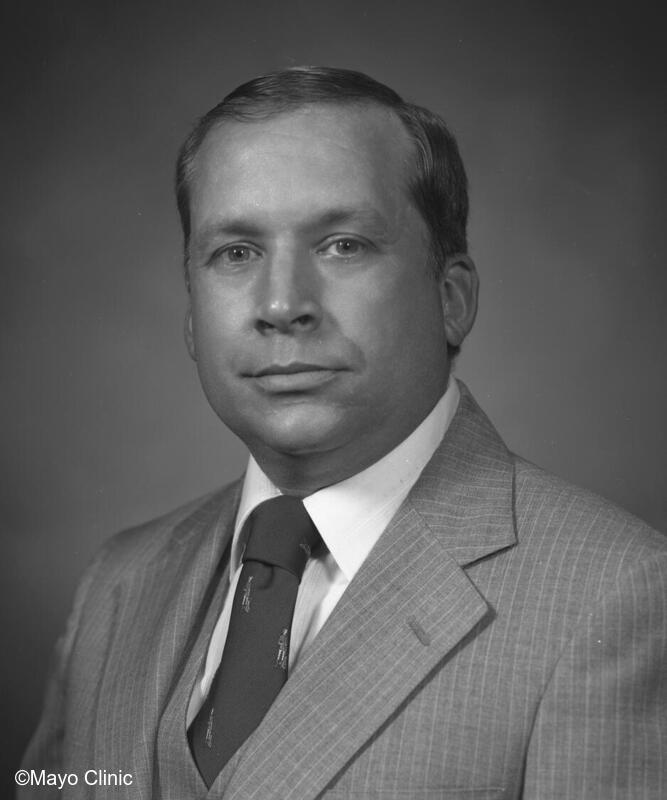
Steven Rettke, M.D., was born in Marinette, Wisconsin on October 22, 1946. He attended Western Michigan University in Kalamazoo, Michigan, earning a B.S. degree in Aviation Engineering in 1969. We believe he may be the only consultant in our institution’s history to hold an Airframe and Powerplant mechanic’s license. Steve also received a B.S. degree in biology from Jacksonville University (Florida) in 1975. He subsequently earned his M.D. degree in 1979 from the University of Wisconsin, Madison. He did his residency in anesthesiology at Mayo Clinic Rochester and joined our staff in 1982. His classmates in that entering 1979 residency class included Drs. Bob Chantigian, Mary Ellen Warner, and me. Our cumulative years on staff at Mayo Clinic now stand at 164.
Prior to completing his first college degree, Steve joined the U.S. Naval Reserve in February 1967 as an Aviation Reserve Officer Candidate (AVROC). He entered active duty in 1969 after receiving his initial officer commission. Steve then earned his wings as a Naval Aviator on October 16, 1970. His class was the last to fly the TF-9J Cougar. He qualified to fly onto and off of aircraft carriers aboard the U.S.S. Lexington (CV-16). He went on to fly the A-7 Corsair and was attached to Attack Squadron 87 (VA-87). He was deployed from February 1972 to December 1972 aboard the U.S.S. Franklin D. Roosevelt (CVA-42) to the western and eastern Mediterranean area of operations. He transferred to the U.S. Navy Medical Corps after medical school and spent a total of 27 years of active and reserve duty before retiring as a Captain.
Steve was a leader in our Rochester department throughout his career. He was Section Head of Rochester Methodist Hospital North Anesthesia from 1986 to 1988. He then was Division Chair of Multispecialty Anesthesia from 1988 to 1991. From 1992 to 2000 he was Division Chair of Rochester Methodist North Anesthesia.
Our department has been asked to provide anesthesia care for several U.S. presidents and their family members over the years. I’m not violating any HIPAA regulations when sharing this publicly available information with you that Presidents Lyndon B. Johnson, Ronald Reagan, and George H. W. Bush received perioperative care led by Mayo anesthesiologists (in Washington, D.C.) or by our Mayo anesthesia care teams across the institution. For example, Dr. Paul Didier provided care for Presidents Johnson and Reagan. Steve was our leader in caring for Presidents Reagan and Bush. Dr Roy Cucchiara led the care for President Reagan. Dr. Jim Hebl was involved in the care of President Bush. Our institution-wide department is fortunate to be asked to provide care for many U.S. and international leaders. Special kudos for those who have provided this care and for treating each of these leaders well, just as we do for all patients.
Steve was our lead anesthesiologist in the initial establishment of the Mayo Clinic liver transplant program, working closely with colleagues such as gastroenterologists Drs. Roland (Rollie) Dickson and Russell (Russ) Weisner and transplant surgeon Dr. Ruud Krom. As our department’s Liver Transplant Program Coordinator from 1984 to 1998, he was responsible for setting up protocols and working with other Institutional specialties. This involved designing and, with Mayo Engineering, building the Mayo rapid infusion pump since there were no commercially available rapid infusion pumps at the time. The original engineering drawing for the first version of the Mayo rapid infusion pump can be found below. Nationally, Steve was the anesthesia specialty’s representative to the United Network for Organ Sharing (UNOS). In addition, he was the inaugural chair of the ASA’s Committee on Transplant Anesthesia.
In December 2014, Steve retired as Professor of Anesthesiology. He and his wife Mary have two sons and reside in Rochester.

Duane Rorie, M.D., was born in Yellville in the north central region of Arkansas in 1936. He completed his undergraduate and M.D. degrees at the University of Arkansas, then earned a Ph.D. in anatomy from the University of Mississippi. He subsequently moved to Rochester for his anesthesiology residency and joined the staff in 1970. With the initial class of the new Mayo Medical School entering in 1972, Duane became the school’s first anatomist and taught clinical anatomy for 10 years as well as working in our department and obtaining his first NIH grant in 1977. He continued his success with a string of NIH grants until 1999. His grants focused on understanding the mechanisms and impact of anesthetics on norepinephrine and other neuropeptides, specifically how anesthetics attenuate sympathetic vasoconstriction. His clinical research was directed towards the anatomic considerations of regional anesthetic techniques.
Duane served as the chair of our department’s Division of Anesthesiology at Rochester Methodist Hospital from 1980 through 1991. He advanced to chair of the department and continued in that role until 1999. He was an examiner of the American Board of Anesthesiology and a member of multiple honorary societies within the specialty. His excellence in research and education was recognized by the institution when he was appointed as its Reuben Eisenberg Professor in 1991. He is one of only 4 department members to be recognized as a named professor. Upon completing his role as department chair, Duane was asked to serve as the medical director of Mayo Clinic’s Procedural Skills Laboratory. His appointment brought the department full circle as the anatomy laboratory was first started by our own Dr. John Lundy in 1925 (see section above on the anatomy laboratory’s origin). Duane’s return to clinical anatomy leadership was defined by his refinement and expansion of the Procedural Skills Lab (Clinical Anatomy Lab – RST (mayo.edu)as well as his advocacy for a new Microsurgery Training Center Microsurgery Training Center (mayo.edu).
On rare instances, Duane would tell of the start of his rise within the Mayo Clinic hierarchy. He delighted in telling the story of his first committee role at Mayo . . . and as its chair, no less. He was asked to lead the institution’s Meal Policy Committee by Dr. Gene Mayberry, chair of our Board of Governors at the time. Candidly, there are only a handful of committees lower on the rung of Mayo’s committee ladder. One of those is the Surgical Scrub Suit Policy Committee . . . which was my first committee assignment as a chair (thank you, Bob Waller, successor to Gene Mayberry). Both chair roles were challenging (and a little painful) because few personnel affected by the policies of these two committees are happy about them. Duane and I shared more than a few laughs at how these assignments launched our careers, nearly derailing them right from the start.
Duane passed away on March 7, 2014. His obituary in the Rochester Post-Bulletin may be found at Duane K. Rorie — Rochester - Post Bulletin | Rochester Minnesota news, weather, sports. Dr. Stephen Carmichael, emeritus professor of anatomy, wrote a tribute about Duane’s contributions to Mayo Clinic. Duane had a wonderful wife of 50 years, Carolyn, and two daughters.
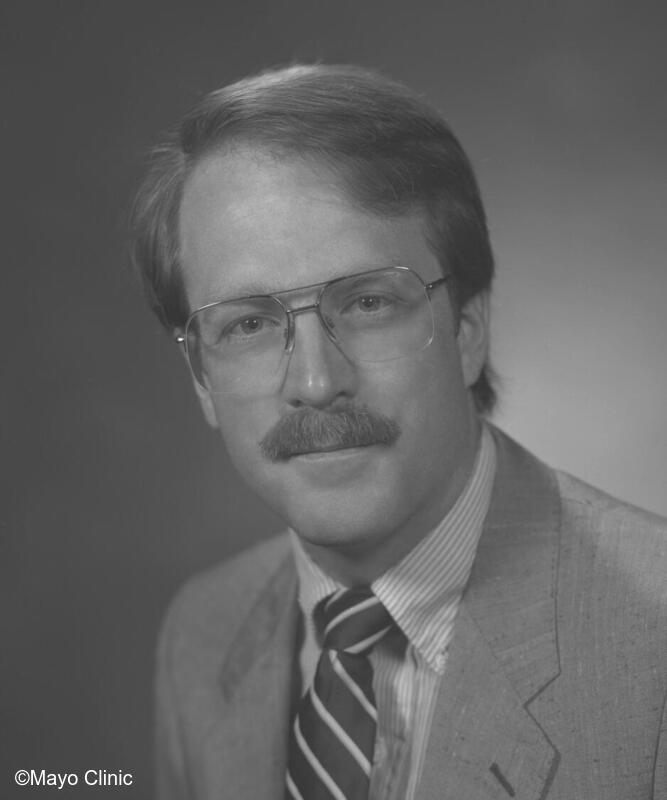
Steve Rose, M.D., was born in St. Paul, Minnesota. He graduated from “the most prestigious public high school” in Valley City, North Dakota (population 6,000+). Our own Drs. Niki Dietz and Kami Anderson are also graduates of Valley City High School. Steve moved on to Concordia College in Moorhead, Minnesota and Mayo Medical School before completing his anesthesiology residency at Mayo Clinic. With help from Dr. Martin Abel, Steve spent a year as a Senior Registrar at Groote Schuur Hospital in Cape Town, South Africa and several months in London, England as a Mayo Foundation Scholar before joining the Mayo faculty in 1985.
Steve was an outstanding athlete in high school, a talent that paid dividends during his training. He played as an all-star on various intramural, departmental, and community flag football and broomball teams. In one of the most shining successes in his training, he resuscitated a fellow broomball player from a cardiac arrest on the ice. Today, he and his wife, Dr. Beth Elliott, continue to participate in sports as avid, expert downhill skiers and frequent swimmers.
The focus of Steve’s non-clinical career has been medical education. He served as residency program director from 1994-2007 and as the department’s Vice Chair for Education from 1994-2009. He was the Mayo Clinic School of Graduate Medical Education’s (MCSGME’s) Associate Dean for Surgery and Surgical Specialties from 2003-2009; Vice Dean from 2007-2012; and Dean from 2012-2021. He also was the school’s Designated Institutional Official (DIO) from 2007-2022. As DIO, he oversaw and governed nearly 200 accredited residency and fellowship programs that trained more than 1,900 residents and fellows annually.
Steve was appointed to the national Accreditation Council for Graduate Medical Education’s (ACGME’s) Institutional Review Committee in 2017 as served as its chair from 2020-2023. This is one of the country’s most important leadership roles in graduate medical education. He is the first Mayo physician to serve in the role since an earlier version of it was established by Dr. Louis Wilson, one of Mayo Clinic’s pioneers in pathology and education. In 2022, Steve received two of the highest honors for a physician in education, the Mayo Clinic Distinguished Educator Award and the ASA’s Excellence in Education Award. This article summarizes his many educational accomplishments.
Three of six MCSGME Deans have been members of the Department of Anesthesiology. Dr. Alan D. Sessler was the inaugural Dean. He served as a mentor to Dr. Mark A. Warner and to Steve (the second and third department members, respectively, to serve in this position).
In clinical practice, Steve works in our Central Division at St. Marys Hospital, caring for patients undergoing complex orthopedic, spine, and thoracic procedures.
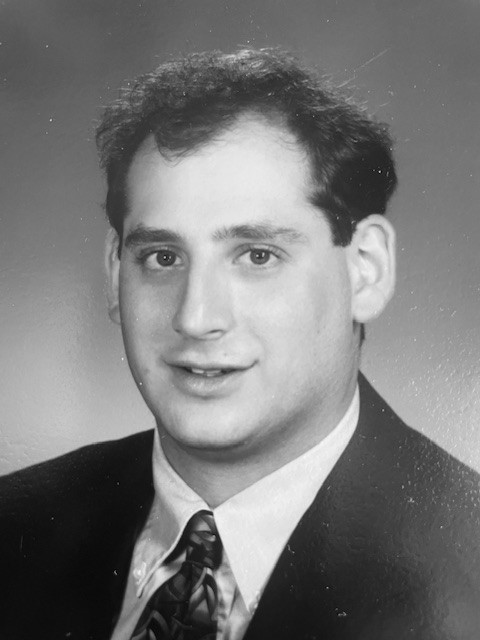
David M. Rosenfeld, M.D., was born May 9, 1969, at Michael Reese Hospital in Chicago, IL. He grew up in Glencoe, IL, a small town twenty miles north of Chicago. His undergraduate education was at the University of Colorado, Boulder, where he earned a degree in Political Science in 1991, considering a career in law and the foreign service. In 1992 he acted on his long-repressed desire to be a physician and enrolled in a one-year post baccalaureate pre-medical program at Loyola University in Chicago. He graduated from Northwestern University Medical School in 1998, where he participated in research focusing on the immunology and cellular rejection pathways of Islet of Langerhans transplantation. Dr Rosenfeld served his internship in general surgery at University of Wisconsin Hospital in Madison, followed by his anesthesiology residency at UCLA Medical Center. He completed his residency training in 2002. While a medical student at Northwestern he met his future wife Missi, at the time a visiting medical student from University of Arizona, and the couple was fortunate to train in anesthesiology together at UCLA. His residency was followed by a Pain Medicine fellowship at Brigham and Women’s Hospital in Boston.
Dave joined the department at Mayo Clinic Arizona in 2003. In his first years of practice, he combined clinical work between general, regional, and cardiac anesthesia, while devoting twenty-five percent time to clinic and in-patient pain medicine. The first decade of the 21stcentury saw tremendous advances in pain medicine, but also an explosion in the use of prescription opioids prescribed to treat mostly benign pain conditions leading to what is now referred to as the opioid epidemic. Well intentioned improvements in pain management for hospitalized patients led to an increase in adverse events mainly due to opioid-induced respiratory depression. In 2007 Dr. Rosenfeld and partner Julia Griffin, RN, CNS, established the first MCA Pain Management Committee, with a focus on quality improvement and safety. Many initiatives were advanced across MCA to improve education, standardization of opioid use protocols, and improved monitoring for patients. At the enterprise level he worked with one of our Rochester colleagues, Dr. Terre Horlocker, on the “Surgery + Opioid = Narcan” project in 2007. The project helped define these issues and spearheaded collaborative improvements. Dave served as division chair in Pain Medicine from 2008 through 2014, overseeing steady growth, the relocation of the clinic to the Phoenix 3 Building, and comprehensive reorganization of operations. In 2014 he partnered with administrator Roshy Didehban to recruit Cynthia Townsend, PhD and establish the Pain Rehabilitation Center, the first of its kind in the region.
In 2005, Dave’s clinical anesthesia responsibilities migrated from cardiac to liver transplantation. During the past nineteen years, he has been involved in more than 400 transplants. He is a national leader in abdominal transplant anesthesia and serves on committees in the ASA and the Society for the Advancement of Transplant Anesthesia. He has devoted his career to advancing the specialty of anesthesiology in education, research, mentoring, and patient safety. In 2022 Dr Rosenfeld was appointed as chair of our Department of Anesthesiology and Perioperative Medicine in Arizona. He has also served as the department Vice Chair, medical director of Surgical Services and section chair of Abdominal Transplant Anesthesiology before becoming department chair.
Dave has been married to Dr. Missi Rosenfeld for 26 years. Missi works for Valley Anesthesiology Consultants/Envision Healthcare and recently joined Mayo Clinic as a supplemental consultant. They have two children, Ethan and Eliana. In his spare time, Dave plays ice hockey, skis, and is an avid hiker who loves the outdoors. He is an accomplished musician/guitarist and has played in a number of different rock bands since high school.

T. Harry Seldon, M.D., received his M.D.C.M degree in 1929 from Queen's University in Ontario. After completing an internship at Toronto Western Hospital (1929-1930), he was in private practice in Sharlot Lake, Ontario (1930-1936). He entered the Mayo School of Graduate Medical Education in 1936 as a fellow in anesthesiology and received the M.S. degree in anesthesiology from the University of Minnesota in 1940. That same year, Dr. Seldon was appointed a Mayo Clinic consultant. In addition to an interest in general anesthesia, he was very involved in the department’s growing work in orthopedic and plastic surgery. He also led the institution’s blood transfusion service.
Dr. Seldon was very involved in the evolution of the science and specialty of anesthesiology. He was president of the American Association of Blood Banks and the Minnesota Society of Anesthesiologists. He was especially active in the International Anesthesia Research Society (IARS).
- Member of the Board of Trustees, 1948-1976
- Chair of the Board, 1955-1957
- Editor (in-chief) of the IARS’s Current Researches in Anesthesia and Analgesia (which became Anesthesia and Analgesia . . . Current Researches in 1957 and then Anesthesia and Analgesia in 1979), 1955-1976
- Harry documented the early history of the IARS in 1971 on the 50th anniversary of Anesthesia and Analgesia.
- Recognized in 1983 by the IARS Board of Trustees when it established the T. H. Seldon Memorial Lecture in his honor.
- This keynote lecture opens the IARS Annual Meeting and brings renowned experts to spark important conversations on anesthesiology and beyond
Dr. Seldon retired from Mayo Clinic in March 1970 and died in Rochester’s Charter House on October 22, 1991.
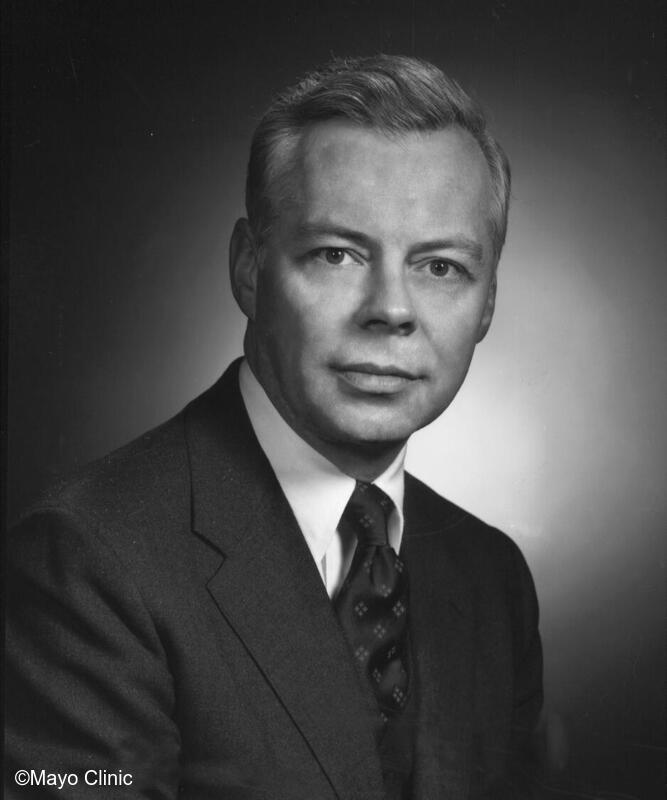
Alan Sessler, M.D., received the degrees of A.B. (1953) from Dartmouth College and M.D. (1957) from Tufts University. He completed an internship and residency at Mary Hitchcock Memorial Hospital in Hanover, New Hampshire (1957-1959), and served in the United States Navy (1959-1961). In 1961, Doctor Sessler entered the Mayo School of Graduate Medical Education as a fellow in anesthesiology. He was appointed a Mayo Clinic consultant in anesthesiology in 1962, and later served as head of the Section of Respiratory Intensive Care (1971-1977) and as chair of the Department of Anesthesiology (1977-1989). He advanced through the academic ranks to become professor of anesthesiology at Mayo Clinic College of Medicine in 1978. Doctor Sessler was a member of the Mayo Clinic Board of Governors (1989-1993) and was the first dean of Mayo School of Graduate Medical Education (1989-1994). He was active and received honors in a number of professional associations. He was a fellow of the American College of Anesthesiologists, the Royal College of Surgeons in Ireland, and the Royal College of Anaesthetists in England. Doctor Sessler retired from Mayo Clinic in June 1995 and died March 18, 2020.
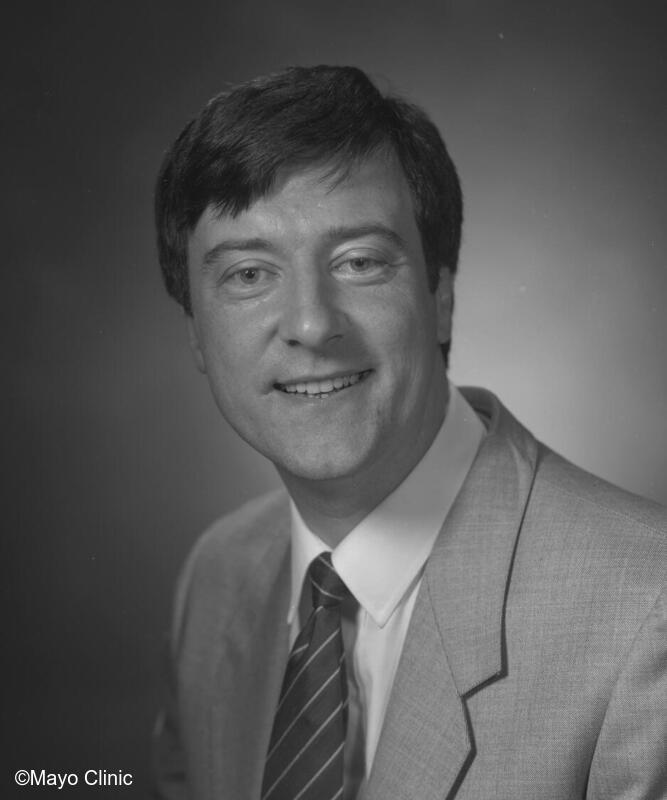
Timothy S. J. Shine, M.D., was born in Dublin, Ireland on September 1, 1953. He earned the degrees of B.A. and M.D. in 1979 from Trinity College in Dublin. After completing an internship at St. James Hospital in Dublin (1979-1980), he moved to Rochester and was a resident in anesthesiology from 1980 through 1984. Tim also served here as a fellow in cardiovascular/thoracic anesthesia and pain clinic/regional anesthesia during the 1984-5 academic year. After working one year at the Carle Clinic in Champaign-Urbana, Illinois, Dr. Alan Sessler, the Rochester department chair at the time, recruited Tim to join Dr. Jim Harper as the first two members of our nascent Department of Anesthesiology in Jacksonville.
Tim served as chair of the Division of Liver Transplant Anesthesia in Jacksonville from 2006 through 2017 and was a member of numerous administrative committees. Examples include membership on the Mayo Clinic Florida Clinical Practice Committee, Surgical Committee, and Pharmacy & Therapeutics Committee. His special interests included cardiovascular anesthesia, transplant anesthesia, and intraoperative transesophageal echocardiography. He is the recipient of two Teacher of the Year awards from our Department of Anesthesiology at Mayo Clinic in Florida.
During his Rochester training, Tim participated in a number of laboratory and clinical trials, working with mentors and colleagues such as Drs. Mike Nugent, Mike Murray, and Dave Plevak. His participation in scholarly publications continued in Florida. He co-authored papers on diverse topics ranging from spinal cord preservation techniques during thoracic and upper abdominal vascular procedures and solid organ transplant anesthesia to the use of perioperative echocardiography. His co-authors in Florida included close friends such as Drs. Neil Feinglass, Wolf Stapelfeldt, Dave Mackey, Roy Greengrass, Sorin Brull, Steve Aniskevich, Claudia Crawford, Bruce Leone, Archer Martin, Sher-Lu Pai, and Steve Clendenen. He is extraordinarily proud of the efforts and expertise of his colleagues as they worked together to develop one of the country’s largest and most successful solid organ transplant programs and the anesthesia teams that have supported them. Tim retired in 2018 after having served in our Florida department’s first 32 years.
Tim and his wife, Marsha, have two children. They continue to reside in Jacksonville and enjoy hiking. They also are proud fans of the Jacksonville Jaguar (NFL).

Gary Sieck, M.D., together with his twin brother Jerry, were the first in the family to attend college. Gary is a University of Nebraska Corn Husker through and through, earning his undergraduate degree in Lincoln and PhD in Physiology & Biophysics in Omaha. After a postdoctoral fellowship at the UCLA Brain Research Institute, Gary was appointed to the faculty in the Department of Anatomy & Cell Biology at UCLA and the Department of Pulmonary Medicine at City of Hope Medical Center. In 1987, Gary transitioned to the faculty in Biomedical Engineering at the University of Southern California.
He finally saw the light and returned to the Midwest, coming to Rochester in 1990 and joining our department as well as the Mayo Clinic’s Department of Physiology & Biomedical Engineering. From 1991-2002, Gary served as our Vice-Chair for Research. In 2002, he became Chair of the Department of Physiology & Biomedical Engineering, serving in that role until 2014.
Gary’s research focuses on cardiopulmonary physiology with an emphasis on neural control of breathing muscles. His research has been continuously funded by NIH grants since 1976. He has published extensively. Throughout his career, Gary has been incredibly active in education and mentorship. He has mentored more than 350 students and fellows. Many of his trainees have gone on to successful careers in biomedical research. In fact, two of his former PhD trainees are currently department chairs in our institution, Y.S. Prakash in Physiology & Biomedical Engineering and Carlos Mantilla in, of course, Anesthesiology & Perioperative Medicine.
Gary has received numerous honors for his research accomplishments, including recognition as a named professor and a Distinguished Mayo Investigator. Outside of Mayo, he has received the Rodarte Award for Scientific Distinction from the American Thoracic Society (ATS), the Distinguished Service Award from the Association of Chairs of Departments of Physiology (ACDP), the Distinguished Alumnus Award from the University of Nebraska Medical Center, and the Distinguished Advocate Award from the American Institute of Medical and Biological Engineering (AIMBE).
He has served as a member of the ATS Board of Directors, a member of the National Council of the American Lung Association, President of the American Physiological Society (APS) and President of the Association of Chairs of Departments of Physiology. He is currently a member of the Executive Committee of the International Union of Physiological Sciences (IUPS). In his spare time (ha!), Gary has served as Editor-in-Chief of both the Journal of Applied Physiology and of Physiology.
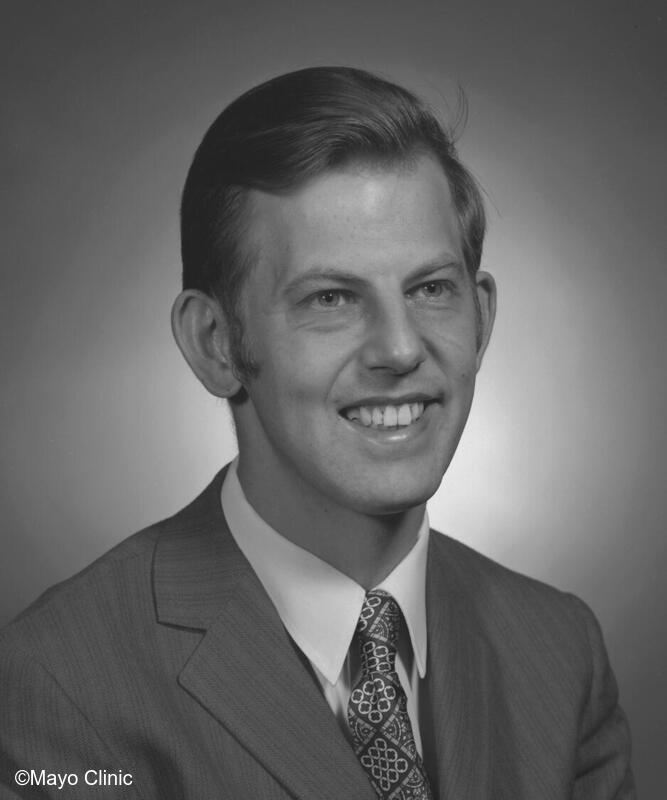
Peter Southorn, M.D., attended undergraduate and medical school at University College in London. After extensive anesthesia training in London, he moved to Rochester in 1973 for a one-year fellowship. He returned to University College as a staff member before making his definitive trip across the Atlantic to join our Mayo staff in 1976. During his career he made major contributions to the evolution of our critical care activities, led enhancement of our intraoperative and ICU patient monitoring capabilities, and was very involved in the development of our solid organ transplant services. Peter played major roles in Mayo’s medical school (admissions committee) and the Mayo Alumni Association (executive committee member). A quiet leader, he was a founding member of the American Society of Critical Care Anesthesiologists (currently named the Society of Critical Care Anesthesiologists) and president of the Minnesota Society of Anesthesiologists.
To many of us, Peter is best known for his gracious demeanor, crooked surgical hat, ready smile, and willingness to help on any project. Peter, Alan Sessler, and Kai Rehder wrote our department’s history in “Art to Science.” That book will be revised in 2025 at the conclusion of the Centennial Celebration.
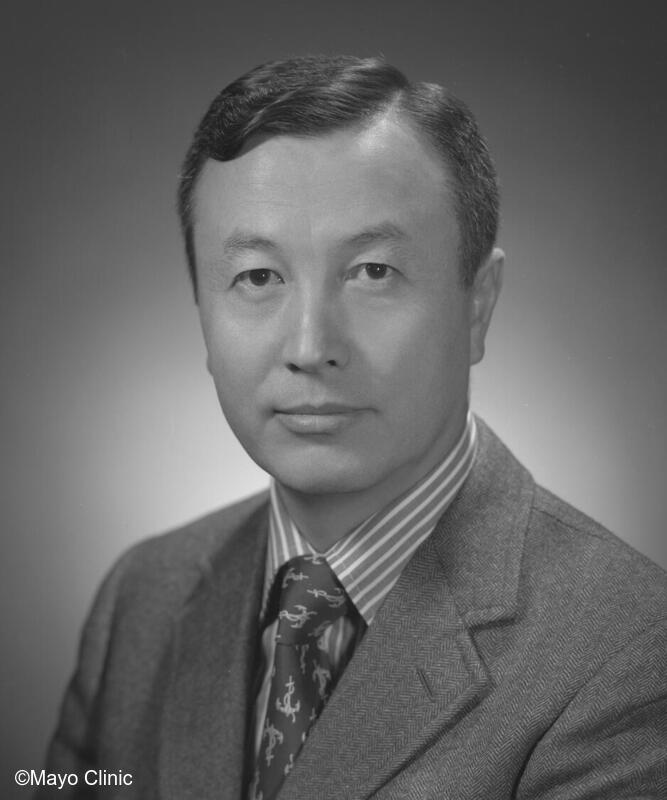
Sait Tarhan, M.D., graduated from the Istanbul Medical School and trained in pulmonary medicine. After completing his training, he served in the Turkish Army on the country’s eastern front. After completing two years of service, he moved to the U.S. in 1958 and worked as a pulmonologist in the Cincinnati, Ohio area for 4 years. He then moved to Rochester, trained in our department, and joined the staff in 1965. He spent most of his career working in our cardiac anesthesiology section and served as our St. Marys Hospital Division chair from 1975-1983.
Sait became one of the world leaders in cardiac anesthesia. Joining forces with Drs. Emerson Moffit, he published a seminal paper on myocardial infarction after general anesthesia (please link to Tarhan Moffit paper here). This JAMA paper led to an understanding of the impact of patient risk on perioperative outcomes and in decisions about scheduling patients for elective surgery. For more than 3 decades, this paper and a subsequent confirmatory paper by Petter Steen and Sait (please link to Steen Tarhan paper here) guided the world on surgical decision-making and perioperative management of patients with previously documented myocardial infarctions.
For his remarkable contributions to our understanding of patient risk factors and perioperative outcomes, Sait was recognized around the globe with honorary memberships in national societies (e.g., the Japanese Society of Anesthesiologists, the Association of Anaesthesiologists and Reanimatologists of the Republic of Kazakhstan). He received numerous awards, including the Recognition Award for Outstanding Contributions as a Pioneer of Cardiovascular Anesthesia by the World Association of Cardio-Thoracic and Vascular Anesthesia.
Sait never met anyone that he didn’t befriend and welcome. He was revered outside of the institution and admired within it. He received the Mayo Clinic’s Distinguished Clinician Award in 1993 in recognition of his lifetime of outstanding clinical care and his role in attracting and caring for many international patients who came to Mayo Clinic.
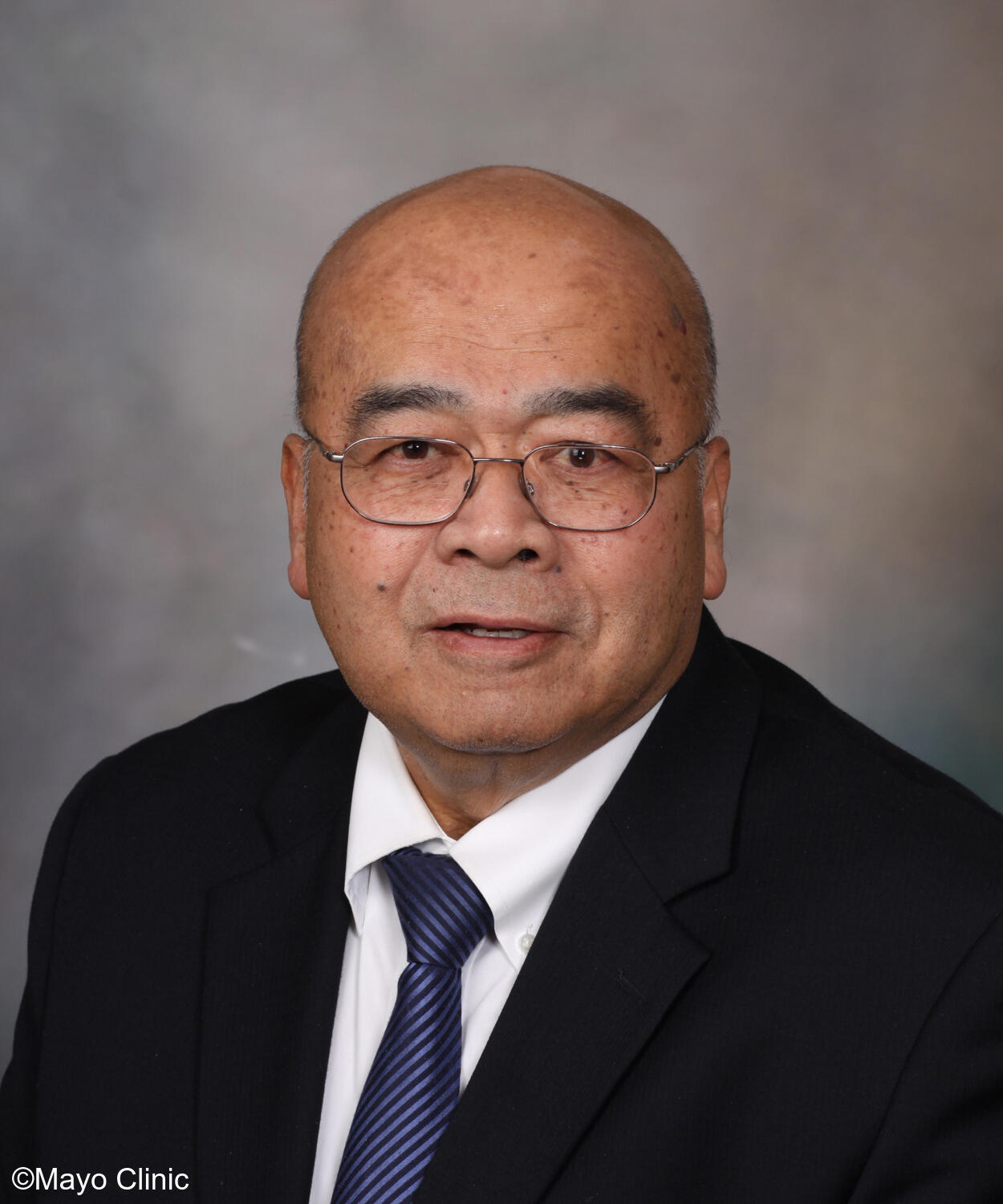
Rungson Sittipong, M.D., was born in Chiang-Mail, Thailand on July 16, 1941. His family moved to Bangkok while he was still in primary school. Rungson graduated from the Chulalongkorn University School of Medicine in 1965, receiving his M.D. degree as his class valedictorian. He was handed his degree directly from the King of Thailand. After a one-year internship at Chulalongkorn Hospital, he made an unlikely move in 1966 from Bangkok to Duluth, Minnesota where he was an intern at St. Luke’s Hospital. He impressed Mayo alumni while working at St. Luke’s and was encouraged to move to Rochester. From 1967 through 1968, Rungson was a resident in physiology, working closely with two of the world’s most eminent authorities on pulmonary physiology, our own Drs. Kai Rehder and Bob Hyatt. He then was an anesthesiology resident here from 1968 through 1972.
Rungson was brilliant and served as a remarkable resource of knowledge related to respiratory physiology. As such, he was recruited in 1972 to join Dr. Alan Sessler in his growing Section of Respiratory Care. That same year, Dr. H. Michael Marsh, who had previously been a clinical fellow in intensive care in Rochester, returned from Australia and joined the section. Together, to quote Dr. Peter Southorn’s summary in our department’s Art to Science history book, “(Marsh and Sittipong) were the advance guard of what came to be called . . . ‘Sessler’s foreign legion in intensive care’.” In 1976, Rungson left the Section on Respiratory Care and moved to full-time practice in the Rochester Methodist Hospital operating rooms. He joined forces with Drs. Duane Rorie, David Byer, Dave Nelson, and others in a growing regional anesthesia practice. He remained in this position until his initial retirement in 1996. He returned temporarily to Thailand to care for his elderly family members. During his time in Thailand, he volunteered at the medical schools and anesthesiology training programs in Bangkok. In 2001, he returned to Rochester and rejoined the department as a supplemental consultant. He continued in that role, with a special focus on working in the Preoperative Evaluation Clinic, through 2017.
There are so many wonderful stories about Rungson. Dr. Scott Atchison (Sioux Fall, South Dakota) wrote a short synopsis of “Rungson-isms” in our department newsletter of September 2002. In brief, he was beloved by everyone, including colleagues and patients. Most anyone who ever connected with him has one or more Sittipong stories, most of which have an element of truth in them (ha!). These range from his love of students of all types (he was Teacher of the Year for the residency in 1974 and 1986) to his joy for caring for patients and being with trainees and colleagues and to his enchantment with gambling, a trait he gained from his grandmother. A few of my favorite stories include his prize guppy, Fishong; his incredibly strong Manhattan drinks that he’d prepare for residents and friends during poker games in his Rochester Tower apartment; his mischievousness during the workday that brought smiles to everyone during especially busy late afternoons; and his way of simplifying the most difficult physiologic issues for trainees to understand. Regarding those Manhattan drinks, it is surprising how many of the plants in his living room suffered when Rungson would prepare “just one more drink” for his poker-playing guests. They would often pour those last drinks onto his plants when he wasn’t looking. No one ever wished to offend Rungson, but they also knew they could not possibly drink those last Manhattans before leaving for the evening.
If you have other Sittipong stories that you would like to share and allow us to archive, please send them to me at mark@mayo.edu.
Rungson traveled extensively, loved the opera, and knew almost every Thai chef in New York City by first name. He had friends in most of the world’s major cities and would always let them know if you were going for visits to those cities. He had an extensive collection of stamps and coins, as well as an encyclopedic knowledge about philately and numismatics. He was one of the most generous individuals you would ever meet, sharing both his expertise and his collections.
He lived at Charter House in Rochester for most of his time after returning in 2001 from Bangkok. Rungson passed away August 21, 2020.

Peter Southorn, M.D., attended undergraduate and medical school at University College in London. After extensive anesthesia training in London, he moved to Rochester in 1973 for a one-year fellowship. He returned to University College as a staff member before making his definitive trip across the Atlantic to join our Mayo staff in 1976. During his career he made major contributions to the evolution of our critical care activities, led enhancement of our intraoperative and ICU patient monitoring capabilities, and was very involved in the development of our solid organ transplant services. Peter played major roles in Mayo’s medical school (admissions committee) and the Mayo Alumni Association (executive committee member). A quiet leader, he was a founding member of the American Society of Critical Care Anesthesiologists (currently named the Society of Critical Care Anesthesiologists) and president of the Minnesota Society of Anesthesiologists.
To many of us, Peter is best known for his gracious demeanor, crooked surgical hat, ready smile, and willingness to help on any project. Peter, Alan Sessler, and Kai Rehder wrote our department’s history in “Art to Science.” That book will be revised in 2025 at the conclusion of the Centennial Celebration.
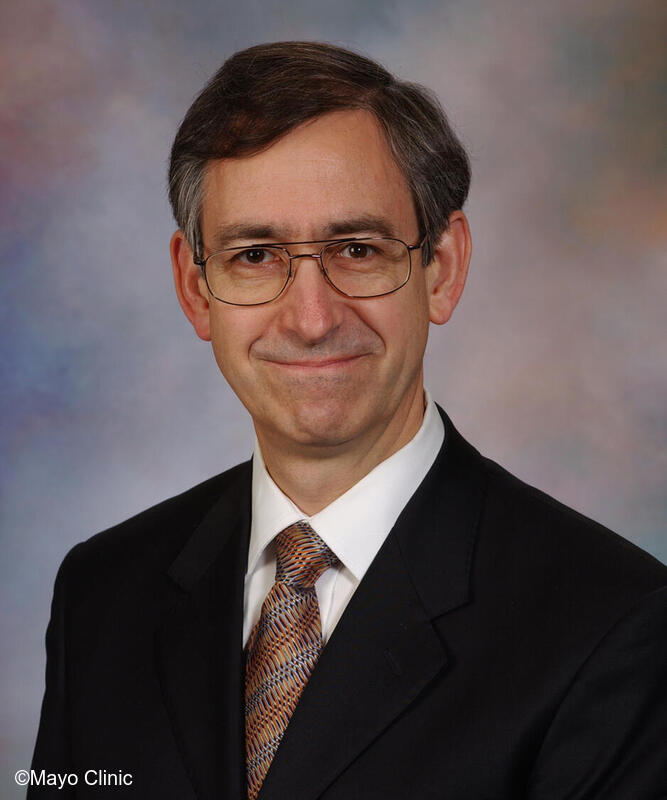
Tom Spackman, M.D., was born in Edmonton, Alberta in 1949. He attended undergraduate school at both Brigham Young University and the University of Alberta. He earned his M.D. degree in 1976 from the University of Alberta. He worked in general practice in Cardston, Alberta until 1978 when he moved to Rochester as a resident in anesthesiology. After graduating in 1980, Tom moved to Pocatello, Idaho and joined a private practice, returning to Mayo Clinic in Rochester in 1982. In 1993, he received a Master of Science degree in Administrative Medicine from the University of Wisconsin in Madison.
Tom chaired our Rochester Division of Cardiovascular/Thoracic Anesthesiology from 1988 through 1996, then transitioned to serve as department Vice-Chair for our Midwest Regional Anesthesiology practices. In that role he served as a member of the Board of Trustees for both the Albert Lea and Austin (MN) medical centers. Tom was very involved in the Minnesota Medical Association from 2000 through 2008, leading several reference committees at the association’s annual meetings.
In February 2009, Tom moved to Jacksonville and served as chair of our Mayo Clinic Florida Department of Anesthesiology until 2013. During his tenure as chair, the department grew, especially its exceptional solid organ transplant program and neuroanesthesia practice. Tom retired in 2014 but continued for several years as a supplemental consultant in Jacksonville. Many of his colleagues remember Tom as a gracious, humble, and unflappable colleague. Tom and his wife, Susan, have five children.

Sait Tarhan, M.D., graduated from the Istanbul Medical School and trained in pulmonary medicine. After completing his training, he served in the Turkish Army on the country’s eastern front. After completing two years of service, he moved to the U.S. in 1958 and worked as a pulmonologist in the Cincinnati, Ohio area for 4 years. He then moved to Rochester, trained in our department, and joined the staff in 1965. He spent most of his career working in our cardiac anesthesiology section and served as our St. Marys Hospital Division chair from 1975-1983.
Sait became one of the world leaders in cardiac anesthesia. Joining forces with Drs. Emerson Moffit, he published a seminal paper on myocardial infarction after general anesthesia (please link to Tarhan Moffit paper here). This JAMA paper led to an understanding of the impact of patient risk on perioperative outcomes and in decisions about scheduling patients for elective surgery. For more than 3 decades, this paper and a subsequent confirmatory paper by Petter Steen and Sait (please link to Steen Tarhan paper here) guided the world on surgical decision-making and perioperative management of patients with previously documented myocardial infarctions.
For his remarkable contributions to our understanding of patient risk factors and perioperative outcomes, Sait was recognized around the globe with honorary memberships in national societies (e.g., the Japanese Society of Anesthesiologists, the Association of Anaesthesiologists and Reanimatologists of the Republic of Kazakhstan). He received numerous awards, including the Recognition Award for Outstanding Contributions as a Pioneer of Cardiovascular Anesthesia by the World Association of Cardio-Thoracic and Vascular Anesthesia.
Sait never met anyone that he didn’t befriend and welcome. He was revered outside of the institution and admired within it. He received the Mayo Clinic’s Distinguished Clinician Award in 1993 in recognition of his lifetime of outstanding clinical care and his role in attracting and caring for many international patients who came to Mayo Clinic.
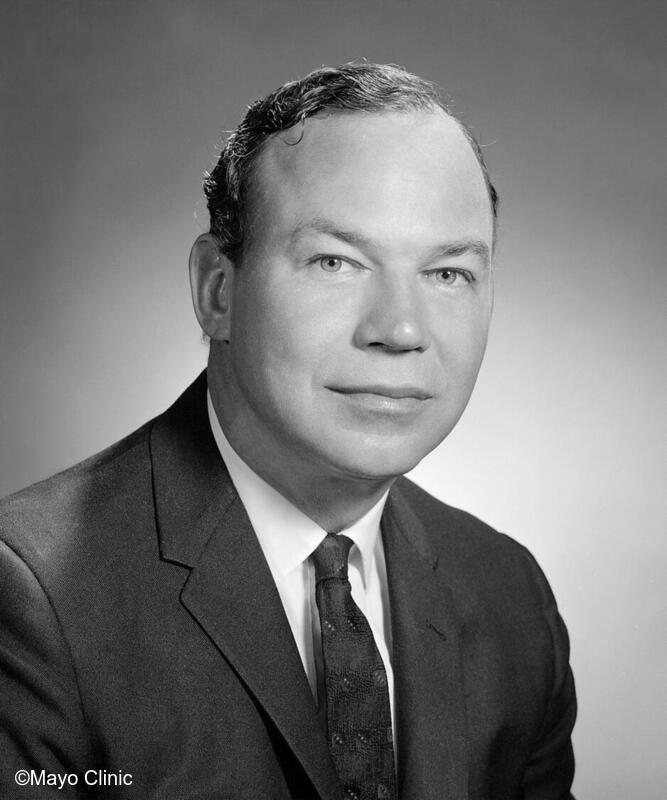
Richard “Dick” Theye, M.D., was from Ft. Wayne, Indiana, a graduate of Indiana University, and trained in anesthesiology in Indianapolis. After a stint in the U.S. Navy and a short time in private practice, he moved to Mayo Clinic and rapidly established his interest in clinical research, specifically pulmonary gas exchange, cardiac output, and regional oxygen uptake measurement during anesthesia. He became the first department staff member to be assigned dedicated research time and was instrumental in the research training of Jack Michenfelder and Kai Rehder. He served as department chair from 1971 through 1976 and was a director of the American Board of Anesthesiology. Sadly, he passed away from ALS in 1977 just as he was in the prime of his career.
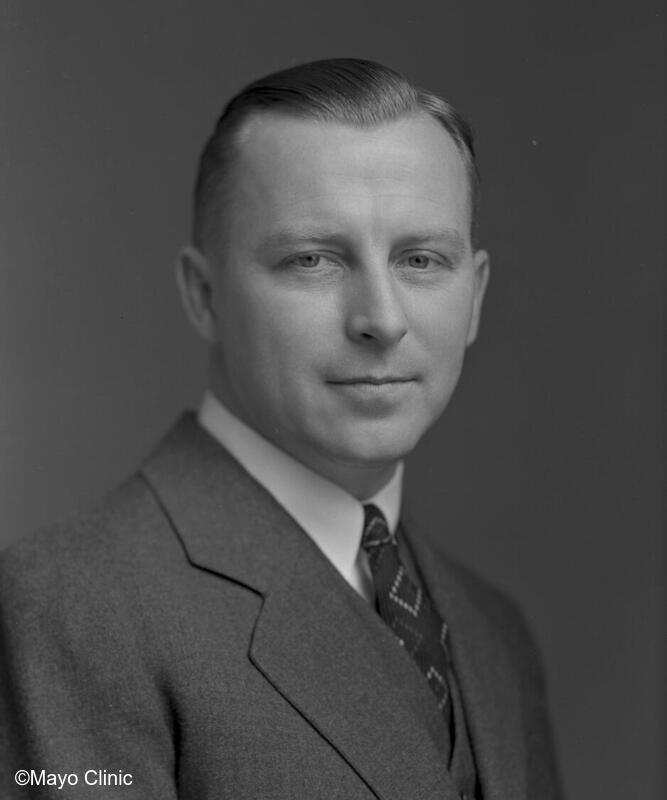
Ralph Tovell, M.D., was born in Sydenham, Ontario, Canada in 1901. He earned his M.D. degree from the Queen’s University in Kingston, Ontario in 1926. He immediately moved to Rochester as one of Dr. John Lundy’s first fellows. He remained in Rochester until moving in 1939 to become the chief of anesthesiology at Hartford (CT) Hospital. Several wonderful, brief summaries of Ralph’s contributions to the specialty’s development may be found at Ralph M. Tovell, M.D.* - Wood Library-Museum of Anesthesiology (woodlibrarymuseum.org) and Dr Ralph Moore Tovell | The Royal College of Anaesthetists (rcoa.ac.uk). For brevity, let me summarize several of his remarkable key accomplishments:
- 1938: Helped found the American Board of Anesthesiology.
- 1939: Chief of Anesthesia, Hartford (CT) Hospital, remaining in that role until 1963.
- 1940: Became a U.S. citizen.
- 1940: Appointed as Associate Editor, Anesthesiology, a position he held until 1955, becoming Editor-In-Chief at that time.
- 1941: President, American Society of Anesthesiologists.
- 1942: Appointed as Senior Consultant in Anesthesia for the U.S. Army, European Theatre of War, discharged at the rank of Colonel.
- 1947: President, American Board of Anesthesiology.
- 1948: Chair, AMA Section on Anesthesia.
- 1951: Recipient, ASA Distinguished Service Award.
- 1955: President, Academy of Anesthesiology
Two examples of Ralph’s contributions are his advocacy that led to the adoption of the Pin-Index safety system for gas cylinders and his contributions to developing safer anesthesia care during WWII.
He died on January 7, 1967. Dr. David Little, another early leader in the specialty, wrote his obituary in Anesthesiology.

Terrence (Terry) L. Trentman, M.D. was born in San Diego, California in 1962. He obtained his undergraduate degree from Brigham Young University and earned his M.D. degree in 1990 from Tulane University in New Orleans. During medical school he participated in the U.S. Air Force’s Health Professions Scholarship Program. From 1990-1995 he and his young family lived in Rochester, MN where he completed an internship, Anesthesiology residency, and pain fellowship. He and Dr. Gil Wong were the first 2 pain fellows in our newly accredited pain fellowship. After completion of his training, Terry and his family returned to the South to fulfill his Air Force payback commitment. He was stationed at Keesler USAF Medical Center, Biloxi, Mississippi for 3 years.
In 1998, Terry joined the staff of Mayo Clinic Arizona. In the subsequent years, he served in various clinical and administrative roles. Among others, he worked part-time in the chronic Pain Clinic, was a member of the Anesthesiology liver transplant team for 20 years and helped to bring ultrasound-guided regional anesthesia to MCA. He served as Division Chair of Pain Medicine, Medical Director of Surgical Services, Department Vice Chair for 10 years under Dr. Dan Cole, and Department Chair for an additional 9 years. Simultaneously, he also served as our institution-wide Anesthesiology Specialty Council Chair, was Vice-Chair of the Mayo Clinic Arizona Personnel Committee, and was promoted to professor rank in 2017.
Since rotating out as Department Chair in 2022, he has continued to work in the operating room but also increased his time in the Preoperative Evaluation Clinic. He currently serves as the Mayo Clinic Arizona Medical Director of Leadership Development and Chair of the Mayo Clinic Medication Diversion Prevention Subcommittee, following in the footsteps of our own Drs. Halena Gazelka and Keith Berge. He and his wife, Laralee, have 4 children and 7 grandchildren.
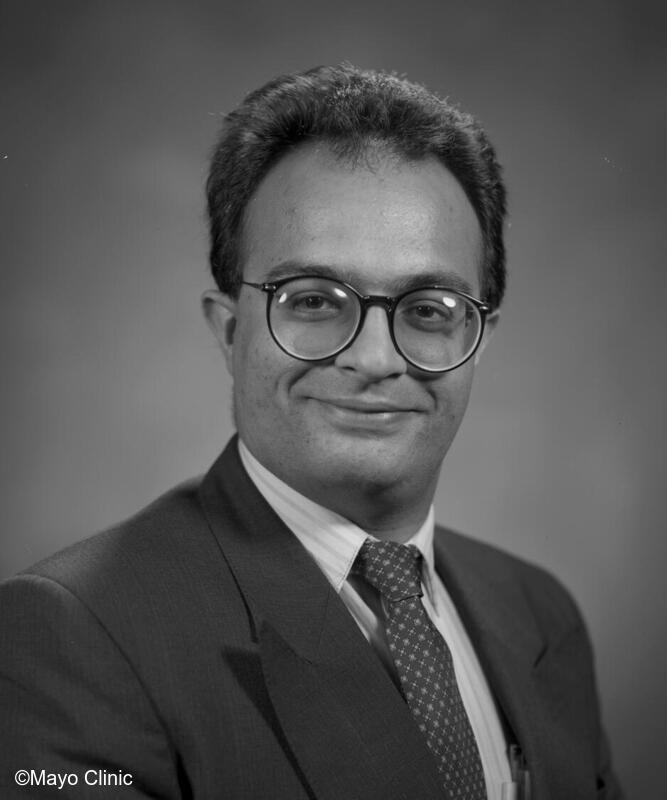
Gurinder (Gary) Vasdev, M.D., was born in Nairobi, Kenya in 1962. He attended medical school in London at the Middlesex Hospital Medical School and earned his MBBS in 1985. The school is part of the University of London, England. Gary completed his general training in anaesthesia at Addenbrokes Hospital, Cambridge, England. He subsequently was awarded the Fellowship of the Royal College of Anaesthetists in both England and Ireland. It was at his graduation ceremony in Dublin in 1990 that Gary first met Dr. Alan Sessler who was bestowed an honorary fellowship at the same time. It truly is a small world!
With Alan’s encouragement, Gary moved to Rochester in 1991 as a fellow in obstetric anesthesiology. He completed that fellowship as well as a critical care fellowship. From 1993 through 1994, he served as a Mayo Clinic Special Clinical Fellow in liver transplant anesthesia.
After completing his advanced training in Rochester, Gary moved to Hartford, Connecticut and joined the University of Connecticut for a short period. He returned to Mayo Clinic in Rochester in March1995. In 1992, he received a Zuspan Award from the Society of Obstetric Anesthesia and Perinatology (SOAP). This award led to what was the beginning of his national rise in OB anesthesiology. In 2007, he became our first Mayo physician to be President of SOAP.
Gary has served our department as director of OB anesthesiology and various other committees. He currently is our department’s vice-chair for Diversity, Equity, and Inclusion. He continues to support Mayo Clinic's national exposure and will soon become President of the North American Sikh Doctors and Dentists Association (NASMDA). Gary has been instrumental in his outreach work with international anesthesiology societies as they develop CME education programs. He has been an advocate for helping his colleagues gain valuable presentation experiences internationally. Gary is a fun travel companion and has done much to bring people together both within our department and the institution.
Gary and his wife, Billie, an outstanding Rochester dentist, have 3 children. Amrit is an anesthesiology resident at Mayo Clinic in Rochester; Ranveer is a urology resident also here in Rochester; and Tanveer is a dental student at the University of Iowa.

Jeff Ward served as the education coordinator for our Respiratory Therapy training program for more than 3 decades. During that period the program trained more than 350 respiratory therapists. Shirley Johnson partnered with Jeff during most of his time as overall education coordinator. Shirley served as the program’s clinical coordinator. Paul Didier and Dave Plevak were the medical directors of the program during most of Jeff’s time in his leadership role.
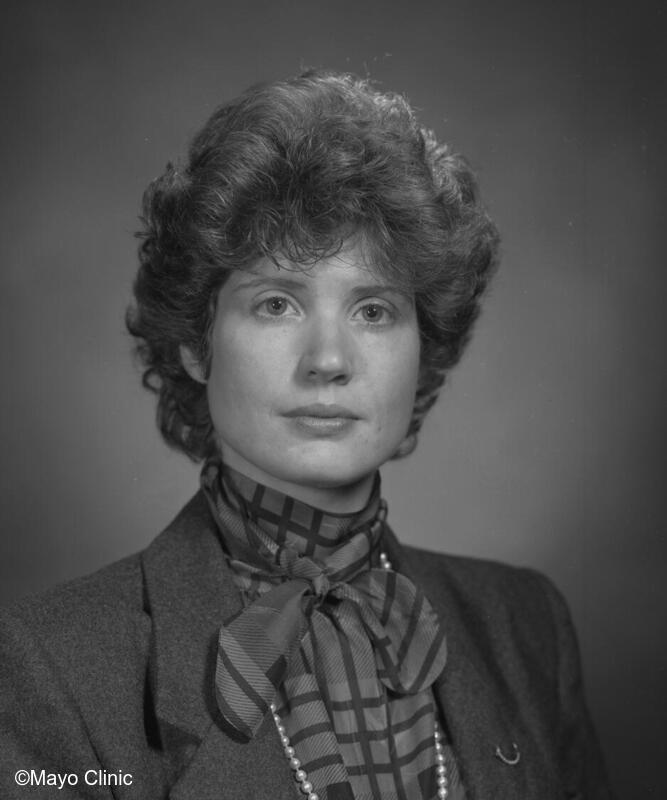
Denis Wedel, M.D., received undergraduate and medical degrees from the University of Minnesota. After her Rochester residency, she served as a regional anesthesia fellow at Virginia Mason Clinic in Seattle. She joined our staff in 1982. She recently retired as an emeritus professor. Denise was responsible for re-invigorating the use of regional anesthesia in our Rochester practices and became one of the leading voices for regional anesthesia and its safe use internationally. She served as president of both the American Society for Regional Anesthesia and the International Anesthesia Research Society. She also was a long-serving editor for regional anesthesia and pain medicine in Anesthesia & Analgesia. She published extensively in regional anesthesia as well as malignant hyperthermia. She and protégé Terre Horlocker published the seminal recommendations on neuraxial anesthesia and the management of anticoagulants, impacting and improving the safety of patient care worldwide.

Frank J. Villamaria, M.D., was born in Frontenac, Kansas (far southeast Kansas) in 1955. He attended undergraduate school at Pittsburg State University in Pittsburg, Kansas. After completing medical school and a surgical internship at the University of Kansas, he was commissioned into the US Navy and attended flight surgery training in Pensacola, Florida. His first assignment was with the First Marine Air Wing in Okinawa, Japan. From there he deployed to multiple islands in the Pacific as well as to South Korea, the Philippines, and Australia. After completing a second tour of duty at the Navy’s Jet Training Command in Kingsville, Texas he moved to Rochester in 1984 as a resident in anesthesiology. He graduated in 1986 and stayed on another year as a cardiac anesthesiology fellow with his good friend, the late Dr. Bill Oliver.
Frank joined our staff in Rochester in 1987. In 1989 he moved to Temple, Texas where he joined the Scott & White Clinic (now Baylor Scott & White Health). He has spent his career at Scott & White, rising to the highest levels of leadership in the organization. He has held multiple positions in the Department of Anesthesiology, including chief of cardiac anesthesia, department vice-chair, and department chair. He has served in many positions at the institutional level, including being a member of the Scott & White Clinic Board of Directors and the medical director for quality and safety. He is currently Clinical Professor of Anesthesiology in the Baylor College of Medicine and vice-chair of anesthesiology for the Baylor Scott & White central Texas region. Like so many other large health systems, Scott & White Clinic merged with a large health system. The chosen partner was the Baylor Health System, resulting in a renewed organizational structure as Baylor Scott & White Health. It is the largest healthcare network in Texas.
Always a leader, Frank was very involved in the Texas Medical Association from 2008-2016, serving as a member of Council of Scientific Affairs and later serving as the inaugural chair of its Council on Healthcare Quality.
While at Mayo Clinic and Scott & White Clinic, Frank remained active in the U.S. Naval Reserve. He was recalled to active duty during Operation Desert Storm. While his children were young during the late 1990’s and early 2000’s, Frank transitioned to an inactive reserve status. However, he returned to the Active Reserve in 2014 once the kids had moved from home, retiring from the Navy as a Captain with over 30 years of service in May 2022. Throughout his service in the Navy, Frank retained both roles as an anesthesiologist and a Naval flight surgeon. He especially enjoyed his assignments as a flight surgeon because it allowed him to be assigned to Navy and Marine Corps Flight Squadrons and interact closely with pilots and aircrew. His duties sent him to many places worldwide and gave him the opportunity to fly in multiple military aircraft.
Frank and his wife, Maureen, married while he was a resident at Mayo. They met in Washington, DC during his Mayo Clinic-sponsored pediatric anesthesia rotation at D.C. Children's Hospital. Frank and Maureen have five children, three of whom are physicians. Emma is beginning her first year in dermatology residency at Mayo Clinic in Rochester next month. Charlie and Luke, in anesthesiology and orthopedic surgery residencies respectively, will serve as U.S. Air Force physicians on completing their training. Their other two girls, Maggie and Sara, are thriving in business in Austin, Texas. Frank and Maureen reside on a small farm outside of Belton, Texas.
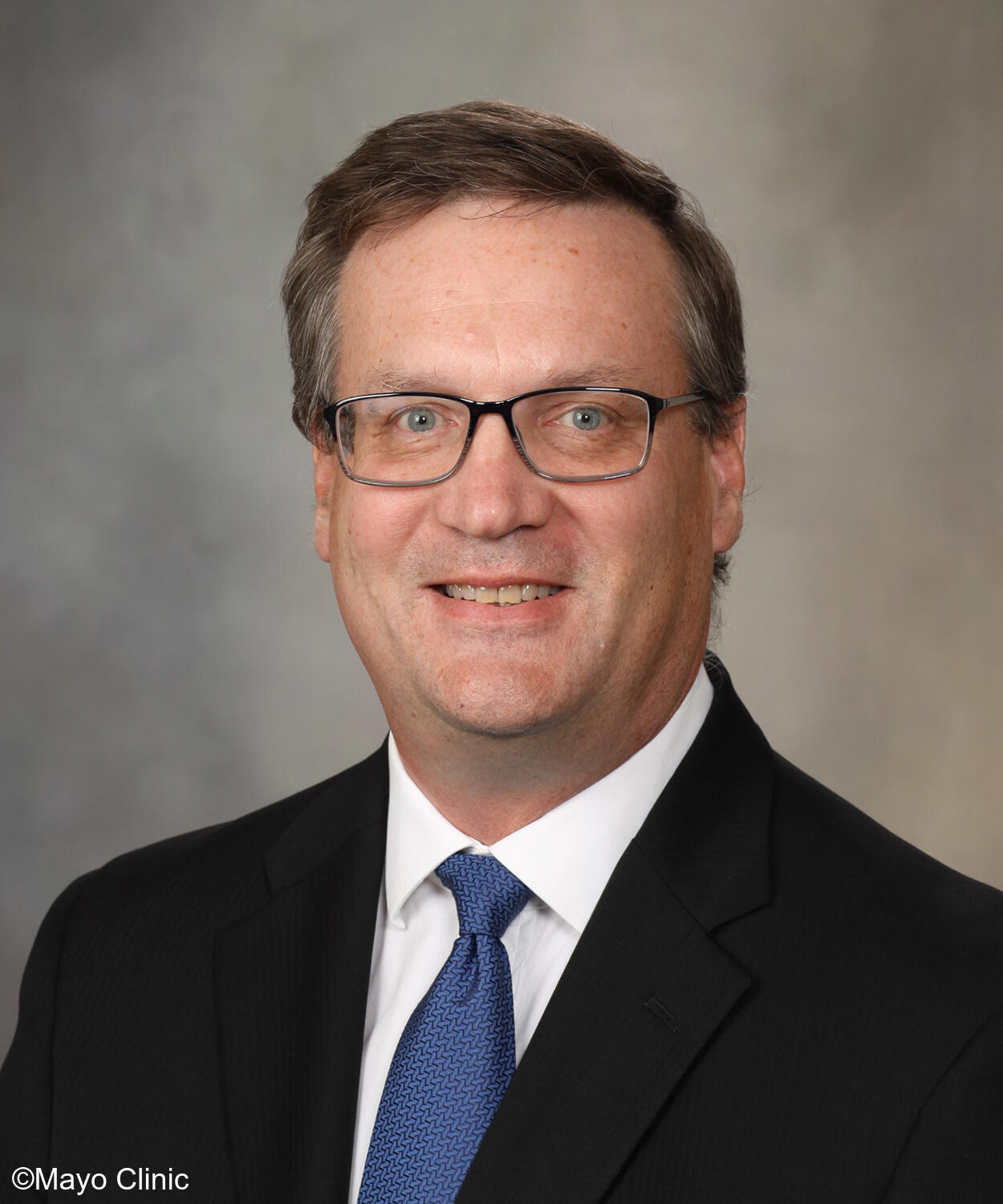
Michael (Mike) T. Walsh, M.D., was born in Gary, Indiana, the 4thof 6 children and the first in his family to become a physician. Mike graduated from the University of Notre Dame in 1984 and earned his M.D. at the Indiana University School of Medicine in 1988. He was a resident in anesthesiology at the Cleveland Clinic from 1990 through 1993. Mike joined the Cleveland Clinic faculty after completing his training, focusing primarily on ENT anesthesia and difficult airway management. In a few short years he was appointed as Head of the ENT Anesthesia Section and co-developed the Cleveland Clinic Difficult Airway Workshop. He was also part of the team that performed the first laryngeal transplant in the U.S.
In 1998, Mike moved back to Indiana to be closer to family. He served as Medical Director for the SurgiCare Ambulatory Care Center in Bloomington, Indiana from 1998 through 2002. It was there that Mike became involved in organized medicine generally, and ambulatory anesthesia specifically. He served on the Board of Directors of the Indiana Society of Anesthesiologists and joined a number of committees in the Society for Ambulatory Anesthesia (SAMBA).
After four years, Mike realized that he missed the excitement and variety of academic anesthesia and came to the Mayo Clinic in Rochester in 2002 to help Drs. Mary Ellen Warner and Ron Mackenzie in the newly formed Gonda 7 outpatient practice. His second practice site in the department was in the Methodist South Division (currently the Jacobson Division). Over time, the balance between Methodist South and Gonda practices shifted towards the hospital. He was appointed Chair of the Methodist South Division in 2006 and served in that role for the next ten years.
Soon after arriving in Rochester, Mike became actively involved in the Minnesota and American Society of Anesthesiologists. He became Secretary/Treasurer of the MSA in 2005 and joined the board of directors. He subsequently advanced to serve as the President of MSA in 2014. As part of his MSA roles, he was one of the society’s representatives to the ASA’s House of Delegates for 10 years.
Mike’s involvement in ASA focused on ambulatory anesthesia. He spent several years on the ASA’s Educational Track Subcommittee on Ambulatory Anesthesia and 18 years on the Ambulatory Care Committee; 4 years as its chair. He has been one of the ASA’s most prominent speakers on ambulatory surgery and anesthesia during the past 15 years. Mike’s SAMBA journey began almost 30 years ago and has been an important part of his career. He started on SAMBA’s Office-Based Anesthesia Committee and, over the years, he served on almost every SAMBA committee, chairing quite a few. Mike joined the SAMBA Board of Directors in 2010 and ascended to the society’s presidency in 2017. The colleagues, mentors, and friends he met along the way have been a great source of joy in his career. He was honored by SAMBA in 2020 with its Distinguished Service Award. He had the added privilege of having his daughter, Emily E. Walsh, M.D., present him with the award. Emily currently is a resident in our department in Rochester and, at the time of the award, was a medical student member of SAMBA.
Mike spent several years involved in accreditation issues in ambulatory surgery and was the ASA’s representative to the Ambulatory Surgery Division of the Joint Commission. He also represented ASA on the Board of Directors of the American Association for Accreditation of Ambulatory Surgery Facilities.
Outside of anesthesia, Mike’s interests include spending time with his wife, Liz, and Emily. Mike and Liz enjoy travel and literature. Mike admits to being addicted to golf; Liz is not yet addicted to it but is patiently learning to play.

Jeff Ward served as the education coordinator for our Respiratory Therapy training program for more than 3 decades. During that period the program trained more than 350 respiratory therapists. Shirley Johnson partnered with Jeff during most of his time as overall education coordinator. Shirley served as the program’s clinical coordinator. Paul Didier and Dave Plevak were the medical directors of the program during most of Jeff’s time in his leadership role.
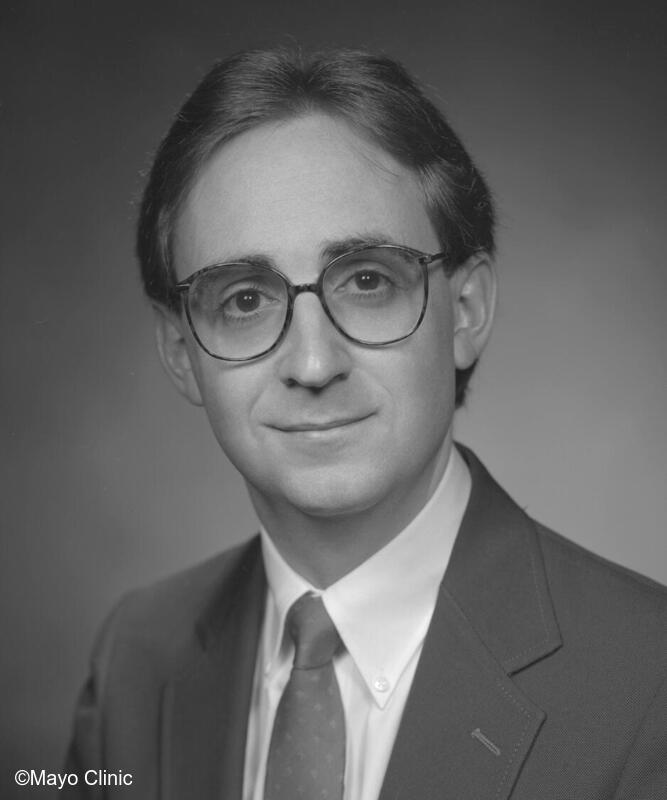
David O. Warner, M.D. was born in Columbus, Ohio on May 31, 1957. For those aware that David is my first cousin, his parents, Drs. E. Jackson (Jack) Warner and Louise Oman (Omie) Warner were pediatric anesthesiologists at Children’s Hospital in Columbus (now Nationwide Children’s Hospital). David obtained his undergraduate degree and his M.D. from the Ohio State University in 1979 and 1983, respectively. According to Dr. Peter Southorn in his summary about David in our department’s Art to Sciencetext about our history (published in 2000), “He (David) was lured to Rochester by his cousin . . . “ I’m not sure “lured” is the correct term, but Mary Ellen and I were able to interest David and his wife, Julie, into visiting Rochester, a trip that may have been one of the best things Mary Ellen and I have done for Mayo Clinic and our department. Regardless of how he got to Rochester, David completed his five-year residency program in 1988. It included two years as a research fellow under the mentorship of Dr. Kai Rehder.
While David’s clinical career was predominantly focused on the care of children, his research interests varied over his 35 years as a consultant in our department. He was, and remains, a remarkable and innovative researcher. His research falls into six primary categories.
Respiratory physiology: David’s early work with Drs. Kai Rehder and Bob Hyatt was focused on pulmonary mechanics and respiratory muscle physiology. His work led to our current understanding that volatile anesthetics relax smooth muscle both by impairing neural reflexes and by direct effects on airway smooth muscle. The ability of volatile anesthetics to relax even maximally stimulated airway smooth muscle is unique (e.g., not shared by beta-adrenergic agonists) and is the foundation for ongoing drug discovery efforts seeking novel bronchodilators.
Perioperative tobacco control: David had a longstanding desire to improve perioperative lung health. His studies on the impact of tobacco smoke on lungs during and after anesthesia and surgery, as well as the potential to use the perioperative period to get patients to stop smoking, have led to major reductions in perioperative pulmonary complications as well as increased rates of smoking cessation in surgical populations. He founded the ASA’s Smoking Cessation Task Force in 2008 and influenced the Centers for Medicare & Medicaid Services (CMS) to pay anesthesia professionals for smoking cessation counseling of patients.
Neurodevelopment following anesthesia and surgery in children: Based on preclinical studies suggesting that anesthesia may be associated with neurotoxicity in the developing brain, David organized a departmental team to investigate this issue in children undergoing anesthesia and surgery. The team’s first studies providing evidence that neurotoxicity from anesthetics may occur in children, showing that anesthetic exposure within the first three years of life is associated with a doubling of the risk for the later development of learning disabilities. Ongoing research is aimed at understanding whether anesthesia and surgery is causative or simply confounding in behavior changes and diminished fine motor skills in children and later in their lives, especially in those with multiple exposures to anesthesia and surgery.
Cognition after anesthesia and surgery in the elderly. Similar to the findings that anesthesia may cause neurotoxicity in developing brains, there is some evidence that this impact may also be found in elderly brains. David assembled a Mayo team and found that although surgery with anesthesia is not associated with an increased risk of clinical diagnoses of long-term cognitive impairment, it is associated with a modest acceleration of cognitive decline. These results are reassuring from the standpoint of anesthesia exposure but highlight the continued need to address perioperative brain health as his team also found that postoperative delirium is associated with subsequent cognitive impairment.
Innovation in postgraduate medical education and assessment. As a director of the American Board of Anesthesiology, David led its Research Committee and produced papers that documented the value of board certification as well as increased understanding of how anesthesia professionals process and retain new information. These studies led to his development of the ABA’s Maintenance of Certification in Anesthesiology (MOCA) continuing education assessment tool, the MOCA Minute. They also triggered the inclusion of a novel Objective Structured Clinical Exam (OSCE) into the ASA’s examination process.
Research in education and mentorship. David recognized the need for improvements in our educational systems at Mayo Clinic and elsewhere. He founded the Mayo Clinic College of Medicine and Science’s Office for Applied Scholarship and Education Science (OASES). The OASES program brings the expertise of professional educators to our institution’s educational programs.
Administratively, David has served within our department as its Rochester vice-chair for research. He co-founded the Mayo Perioperative Outcomes Group in 1995 and followed that by founding the Anesthesia Clinical Research Unit in 1999. Within the institution’s research community, David has been Associate Dean for Clinical and Translational Research, director of Community Engaged Research, and co-director of the Office for Diversity in Clinical Research. He has been an editor of Anesthesiology and the Journal of Applied Physiology. He was the president of the ABA in 2022 and was recognized by the ASA with its Excellence in Research Award that same year.
David retired clinically in January 2023. He continues as a supplemental consultant, working with department members to write research grant applications and offering his advice and insights to our colleagues with research and career interests. David and his wife, Julie, reside in Rochester. They have three children.

Denis Wedel, M.D., received undergraduate and medical degrees from the University of Minnesota. After her Rochester residency, she served as a regional anesthesia fellow at Virginia Mason Clinic in Seattle. She joined our staff in 1982. She recently retired as an emeritus professor. Denise was responsible for re-invigorating the use of regional anesthesia in our Rochester practices and became one of the leading voices for regional anesthesia and its safe use internationally. She served as president of both the American Society for Regional Anesthesia and the International Anesthesia Research Society. She also was a long-serving editor for regional anesthesia and pain medicine in Anesthesia & Analgesia. She published extensively in regional anesthesia as well as malignant hyperthermia. She and protégé Terre Horlocker published the seminal recommendations on neuraxial anesthesia and the management of anticoagulants, impacting and improving the safety of patient care worldwide.

Mark A. Warner, M.D., was born in Greenville, Ohio on October 7, 1953, and was raised on a Jersey dairy farm with his family and grandparents. He graduated from Miami University in Oxford, Ohio in 1976 and entered the Medical College of Ohio (now the University of Toledo School of Medicine). At 7:57 AM on July 6, 1976, he met his future wife, Mary Ellen, as she stood on the medical school steps and unknowingly captured his attention on their way into their first class. After 6 months of relentless pursuit, Mary Ellen finally agreed to a first date.
During their junior year of medical school, they obtained ASA Preceptorship awards with the assistance of their mentor, Dr. J. Tom Martin, a former Mayo Clinic anesthesiologist and Rochester Methodist Division leader. Alan Sessler, Duane Rorie, Ron Faust, and Jim Prentice were their advocates during their two months in Rochester in Spring 1978. Mark and Mary Ellen married in their senior year, graduated in 1979, and moved to Rochester as new residents in 1979. The first two people they met in the department were Ann (Tvedt) Brumm and Donna (née Huntley, formerly Goetsch) Baxter, two of the secretaries in our St. Marys 4 Joseph department office. Dr. Faust was their program director and Dr. Sessler was the chair. Their first-year classmates included Drs. Bob Chantigian, Steve Rettke, Mark Martinson, and John Billings.
Mark completed his residency training in December 1982 and joined the staff. Two of the first new residents assigned to him in July 1983 were Drs. Brad Narr and Jim Eisenach. Of his clinical activities, he is exceptionally proud that the old General Section (now the Multispecialty Division at St. Marys Hospital) provided anesthesia for 225 consecutive children with severe mandibular hypoplasia (e.g., Pierre Robin and Treacher Collins syndromes) without any lost airways or tracheostomies in a time before pediatric fiberoptic endoscopy was available. Colleagues who were extensively involved in the care of these children with him included Drs. Steve Kunkel, Scott LeBard, Lynn Christianson, and Doug Bell and nurse anesthetists such as Mary Marienau, Curt Buck, and John Carter. By the mid-1980s, Mark and colleagues recognized the need for a unique team to care for the institution’s smallest children and formed the pediatric call group. This call group expanded their scope of practice to the evolving pediatric transplant services and postoperative pain management. Recruitment over time of key pediatric anesthesiologists such as Drs. Randy Flick, Bob Friedhoff, Greg Shears, and Bob Lunn rapidly escalated the skill set and size of the pediatric anesthesia group and tied the department closely to the overall integrated pediatric practice at Mayo.
For much of his career, Mark assumed administrative roles within the department and the institution. He was sequentially the chair of the General Section within the department at St. Marys Hospital, the inaugural chair of the Pediatric Council for the institution, the vice-chair of the institution’s Clinical Practice Committee, and the first chair of what is now the institution’s Hospital Practice Committee. He became chair of the Rochester Department of Anesthesiology in 1999 and continued in that role through 2006. Working closely with Drs. Brad Narr, his vice-chair of the practice; Steve Rose, his vice-chair of education; and Mary Ellen who developed the new, innovative Gonda ambulatory practices with colleagues such as Steve Jorgensen, Marla Judd, and Steve Osborn, he was able to watch the department thrive. The department grew in size and academic stature internally and externally. At two different points during his term as department chair, department colleagues served as presidents of 6 of the 8 primary subspecialty societies and Dr. Ron Mackenzie served as ASA president in 2000. He is most proud of the outstanding care provided by his colleagues, the department’s national visibility, and the leadership that colleagues throughout the institution provide for the advancement of specialty.
In 2006, Mark stepped down from his department chair role and joined the Mayo Clinic Board of Governors. He remained a director of that Board as it evolved to the Rochester Board of Governors. He also served the institution as Dean, Mayo Clinic School of Graduate Medical Education (MCSGME; 2006-2012) and Executive Dean of Education (2012-2016). Throughout his time as an education leader, he worked side-by-side with colleague Dr. Steve Rose. Steve was his vice-dean of MCSGME and then later dean of that school. His mentor, sponsor, and surrogate father figure, Dr. Alan Sessler, also provided daily advice.
Mark was involved in the specialty within Minnesota and nationally. He served as a director of the American Board of Anesthesiology from 1998 through 2010 and was president of the ABA in 2009. He also was president of the ASA in 2011, the Academy of Anesthesiology in 2015, and the Anesthesia Patient Safety Foundation from 2016 through 2021. He has received Distinguished Service Awards from the ASA and the Minnesota Society of Anesthesiologists, as well as a Distinguished Educator Award from Mayo Clinic and a Distinguished Alumnus Award from the Medical College of Ohio. He is an honorary fellow of the College of Anaesthesiologists of Ireland. His ASA Distinguished Service Award was announced by former Mayo Clinic Arizona department chair Dr. Dan Cole.
Mark and Mary Ellen have four sons and 10 grandchildren. Two of their sons, along with their wives, are anesthesiologists in our Rochester department. Mark’s first cousin, Dr. David Warner, is one of the recruits he helped to attract to the department. Both Mark and Mary Ellen continue to work clinically. They enjoy traveling, having stayed overnight in more than 100 countries, and visiting their grandchildren. They maintain a farm and spend their spare time caring for their land and contributing to the community.
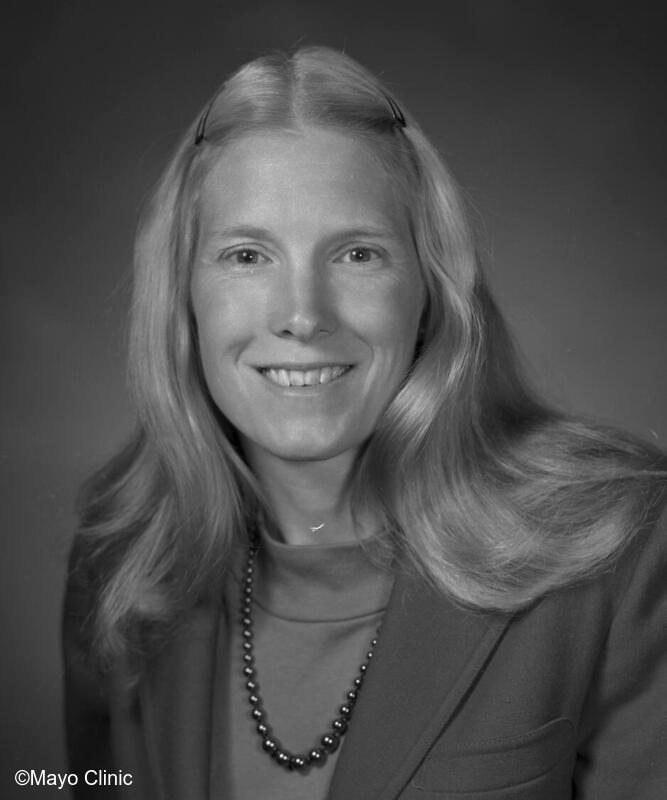
Mary Ellen Warner, M.D., was born in Chillicothe, Ohio on May 29, 1954. After graduating from the University of Florida in 1975, she entered the Medical College of Ohio (now the University of Toledo). While there, she met and married fellow classmate, Dr. Mark A. Warner. While at the Medical College of Ohio, they were mentored by Dr. John T. (Tom) Martin, former division chair and residency program director at Mayo Clinic and the chair of the Department of Anesthesiology at the medical college. Dr. Martin arranged for both Mary Ellen and Mark to be award medical student preceptorships from the American Society of Anesthesiologists. At Dr. Martin’s encouragement, they spent their preceptorships in Rochester. They were supervised by Drs. Duane Rorie and Alan Sessler. While there, they established great friendships with staff (e.g., Drs. Ron Faust, Jim Prentice, Bob Devloo, Paul Didier, Mike Marsh, and Matt Divertie) and residents (e.g., Drs. Ted Janossy, Mark Sperry, Charley Rich, Gary Baggenstoss, and John McMichan).
These preceptorships and their admiration for the parents of Dr. David Warner (pediatric anesthesiologists Drs. Jack and Louise Warner of Children’s Hospital in Columbus, Ohio) led them to seek residency training at Mayo Clinic upon graduation from the medical school in 1979. Mary Ellen completed her residency training in June 1983. First year classmates from that entering resident group in 1979 included her husband, Mark; Bob Chantigian; and Steve Rettke. These four colleagues continue their long-standing ties to the department with a cumulative 162 years of time as anesthesiologists in the institution.
Mary Ellen has held numerous leadership roles in the department and institution. In addition to serving as chair of the former “South” Division at Methodist Hospital, she also chaired the department’s Performance Improvement Committee for nearly two decades. In the institution, she has chaired its Conscious Sedation Task Force that implemented sedation and monitoring standards for the institution, chaired the Surgical Committee’s Procedural Practice Group, and been medical director for Rochester’s Outpatient Procedure Centers. In this latter role, she established new practice models that have been emulated around the world.
Her dedication to her patients, their safety, and the effectiveness of Mayo’s procedural practices resulted in her selection as a recipient of the Mayo Clinic Distinguished Clinician Award in Rochester in 2010. Only three anesthesiologists in Rochester have received this award. The other two are Sait Tahan (1993) and Martin Abel (2005). Two of our colleagues have received this award in Arizona, Joel Larson in 2005 and Terry Trentman in 2018. Roy Cucchiara earned the award in Florida in 2005.
Outside Mayo Clinic, Mary Ellen has been president of the Wood Library Museum of Anesthesiology, one of the world’s leading anesthesiology historical repositories. In 2023 she was the recipient of the WLM’s Distinguished Serve Award. She currently is vice-president of the Anesthesia Foundation.
Mary Ellen and her spouse, Mark, have four sons. They each continue to work clinically in the department.

Denis Wedel, M.D., received undergraduate and medical degrees from the University of Minnesota. After her Rochester residency, she served as a regional anesthesia fellow at Virginia Mason Clinic in Seattle. She joined our staff in 1982. She recently retired as an emeritus professor. Denise was responsible for re-invigorating the use of regional anesthesia in our Rochester practices and became one of the leading voices for regional anesthesia and its safe use internationally. She served as president of both the American Society for Regional Anesthesia and the International Anesthesia Research Society. She also was a long-serving editor for regional anesthesia and pain medicine in Anesthesia & Analgesia. She published extensively in regional anesthesia as well as malignant hyperthermia. She and protégé Terre Horlocker published the seminal recommendations on neuraxial anesthesia and the management of anticoagulants, impacting and improving the safety of patient care worldwide.
